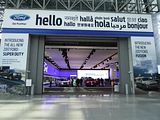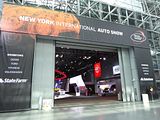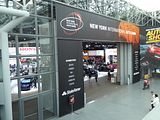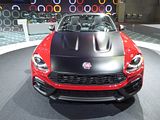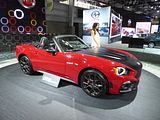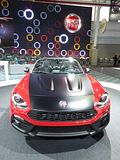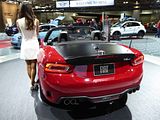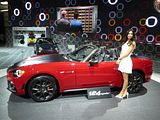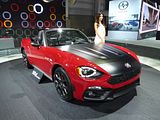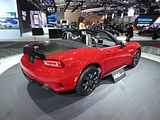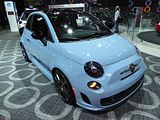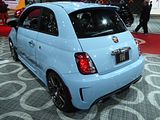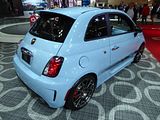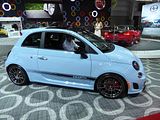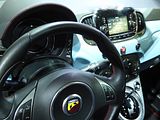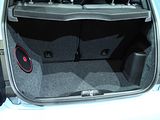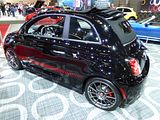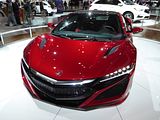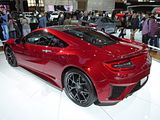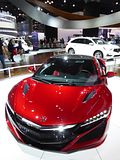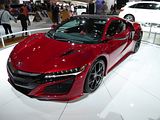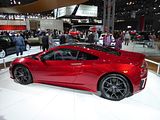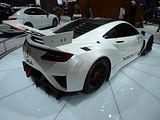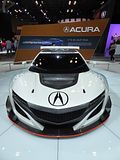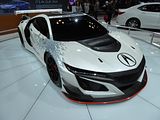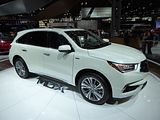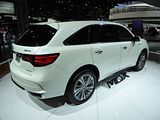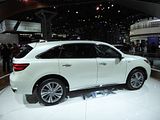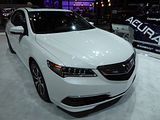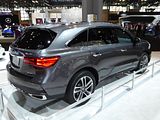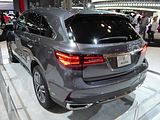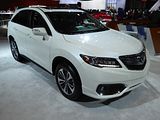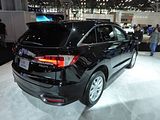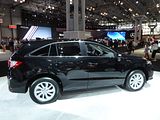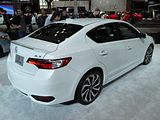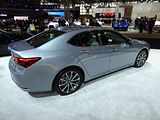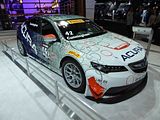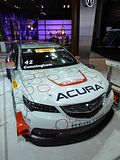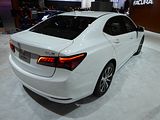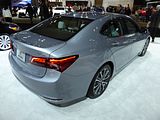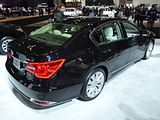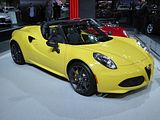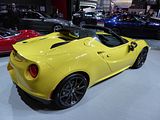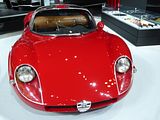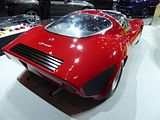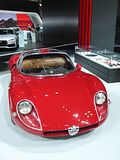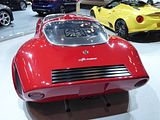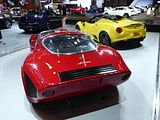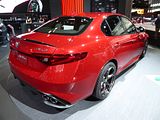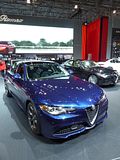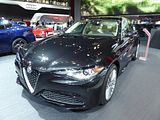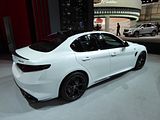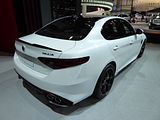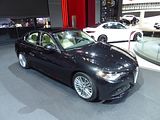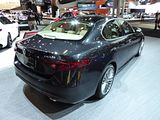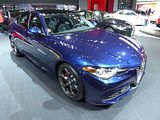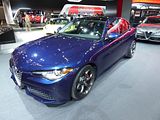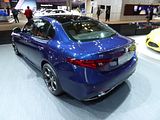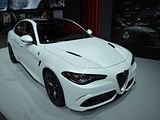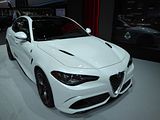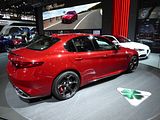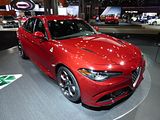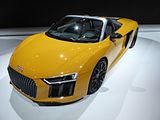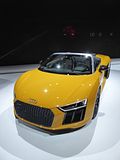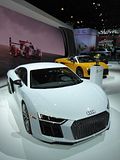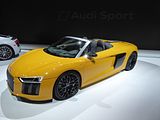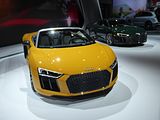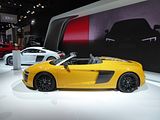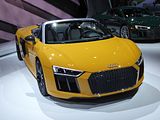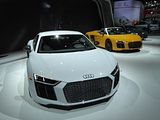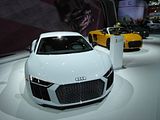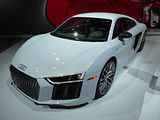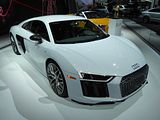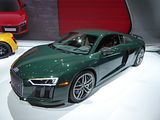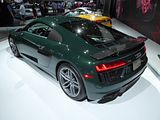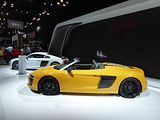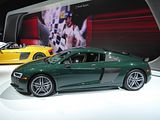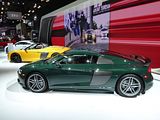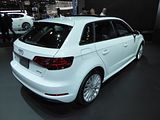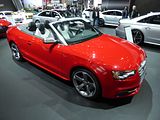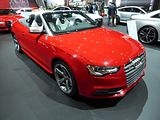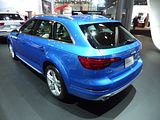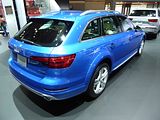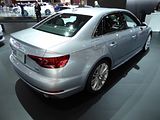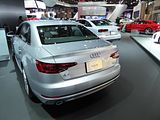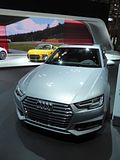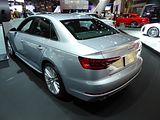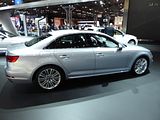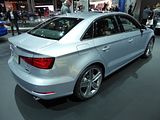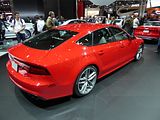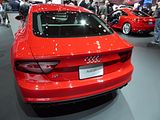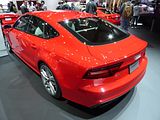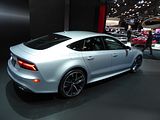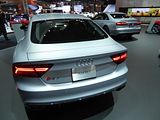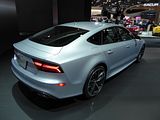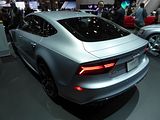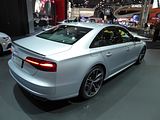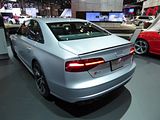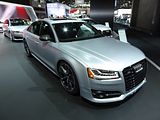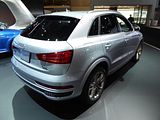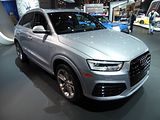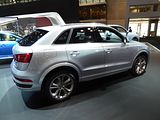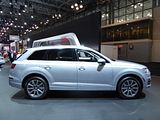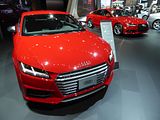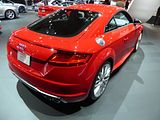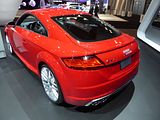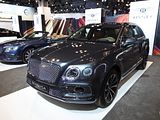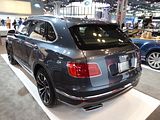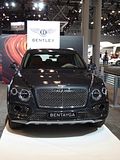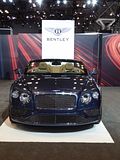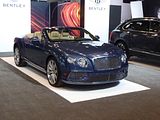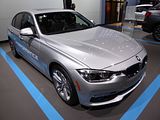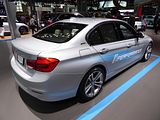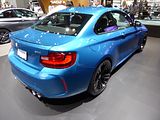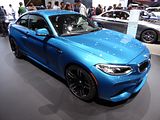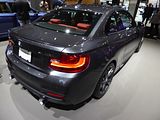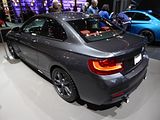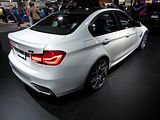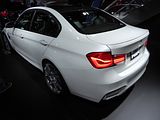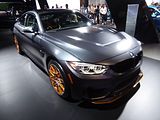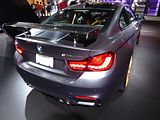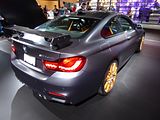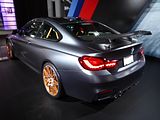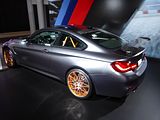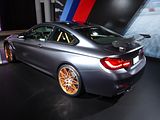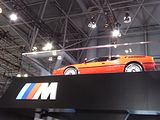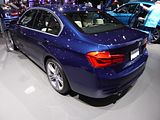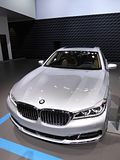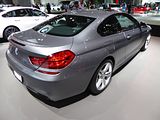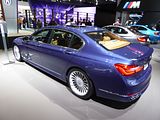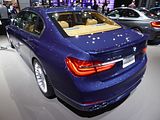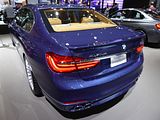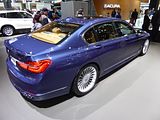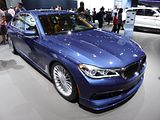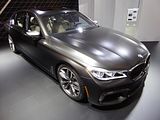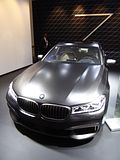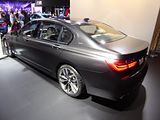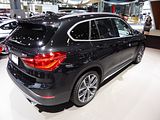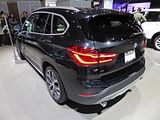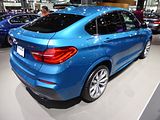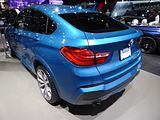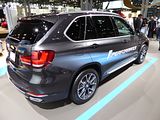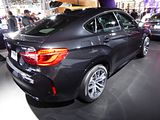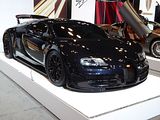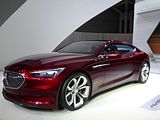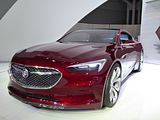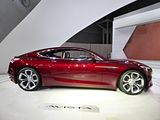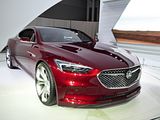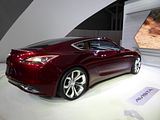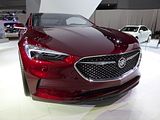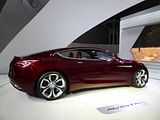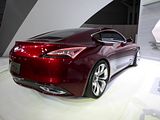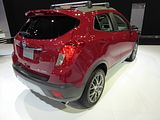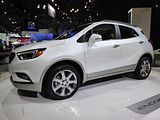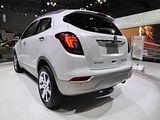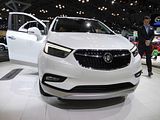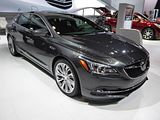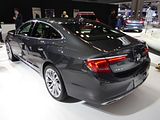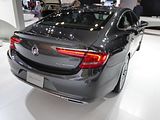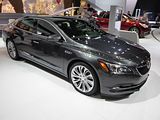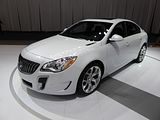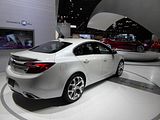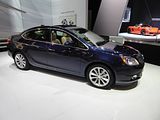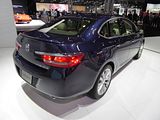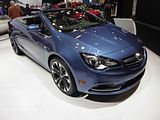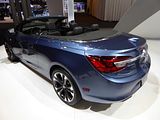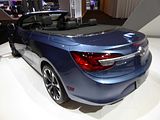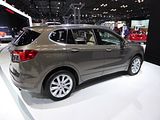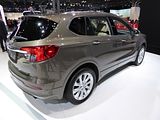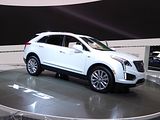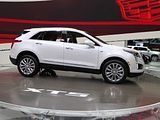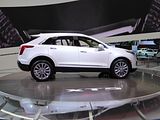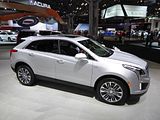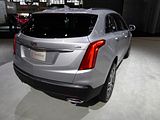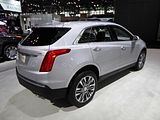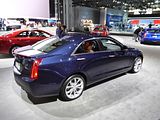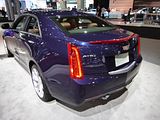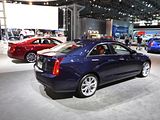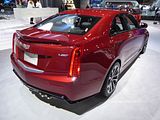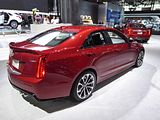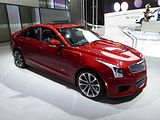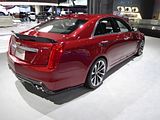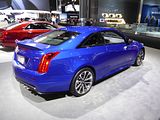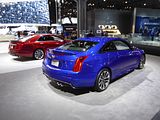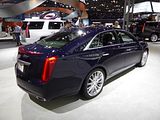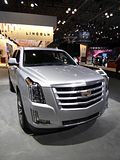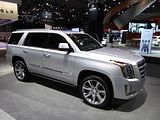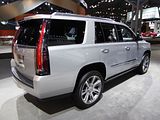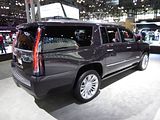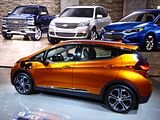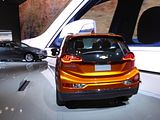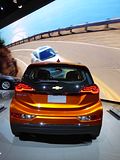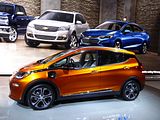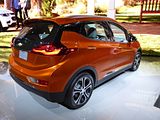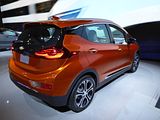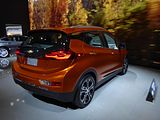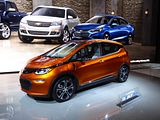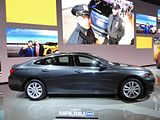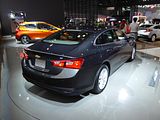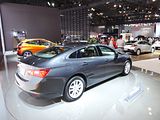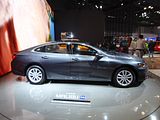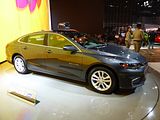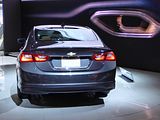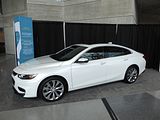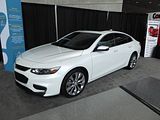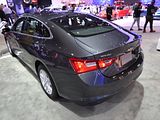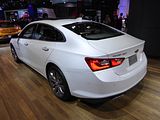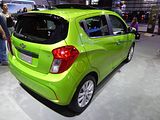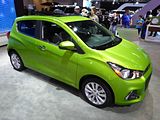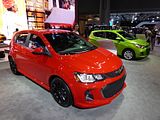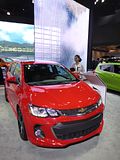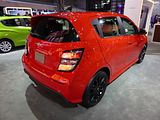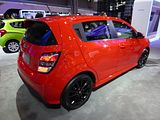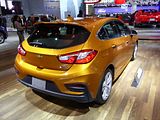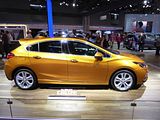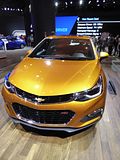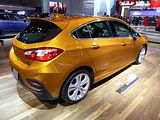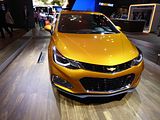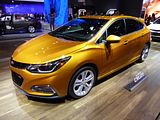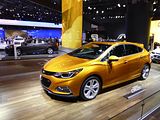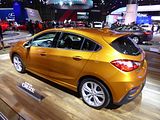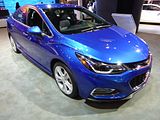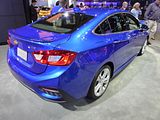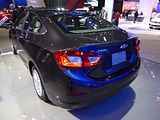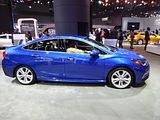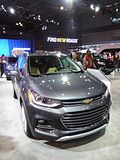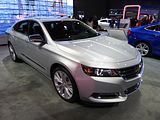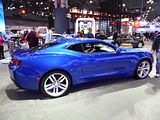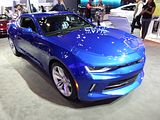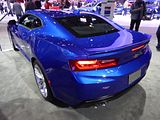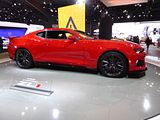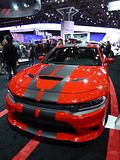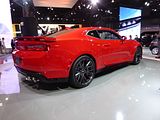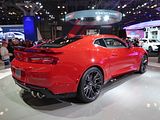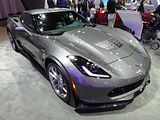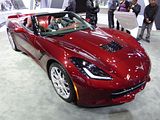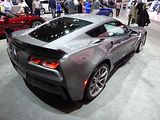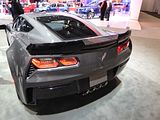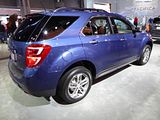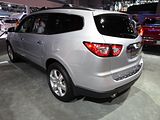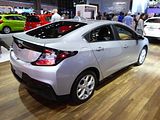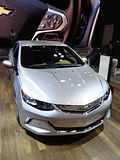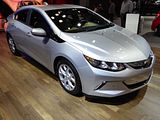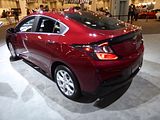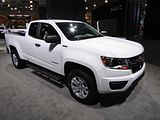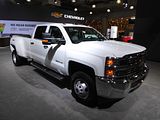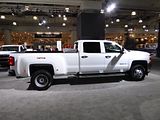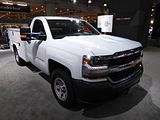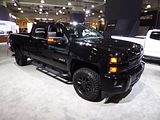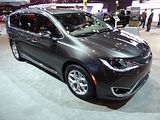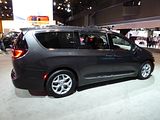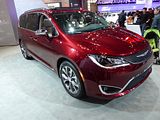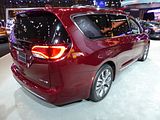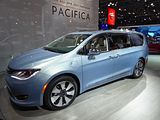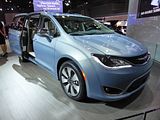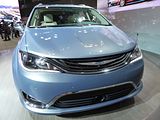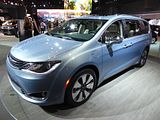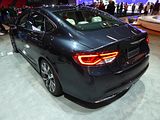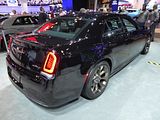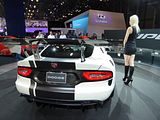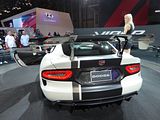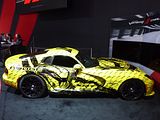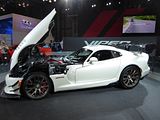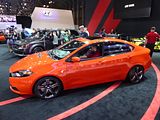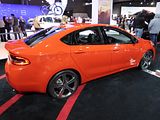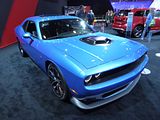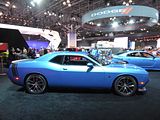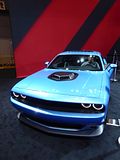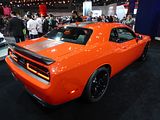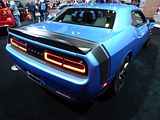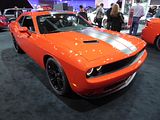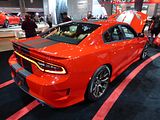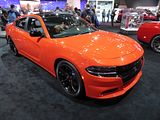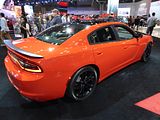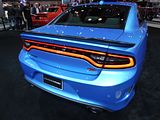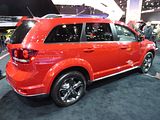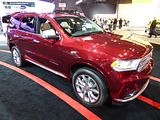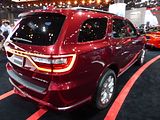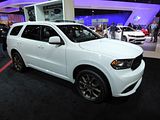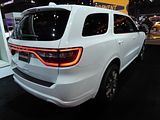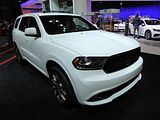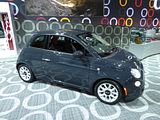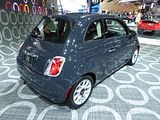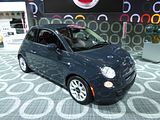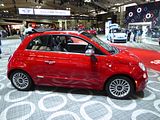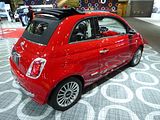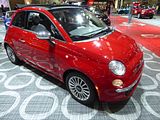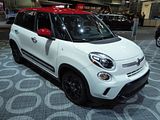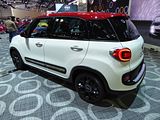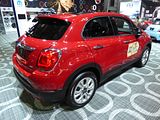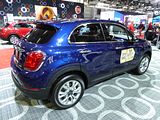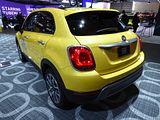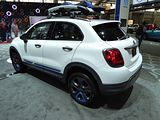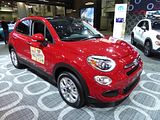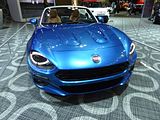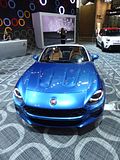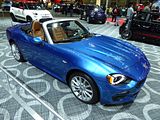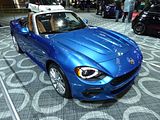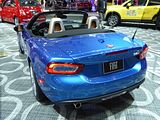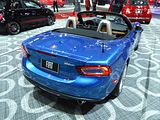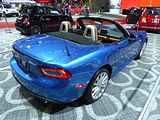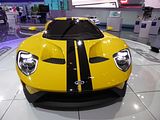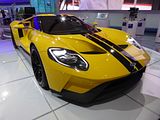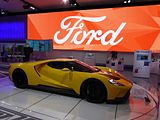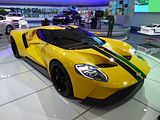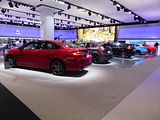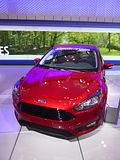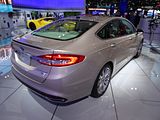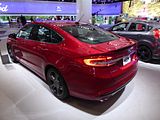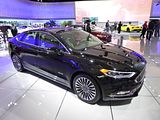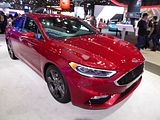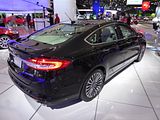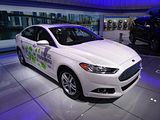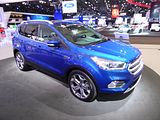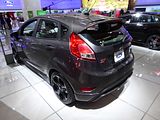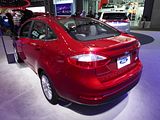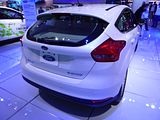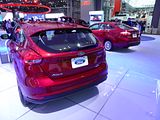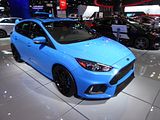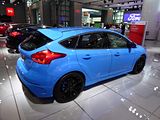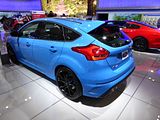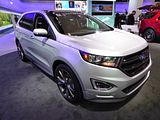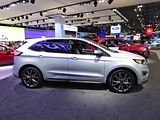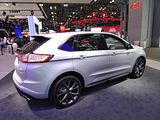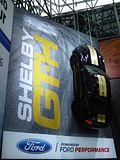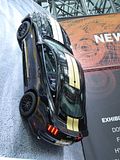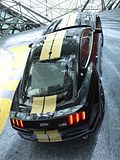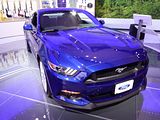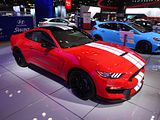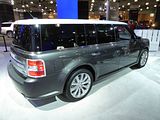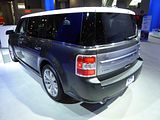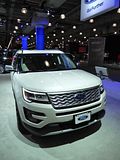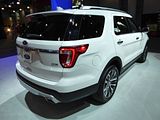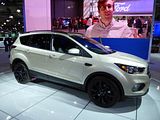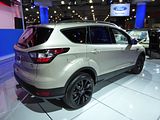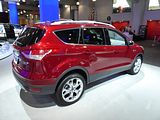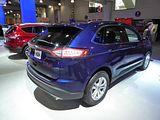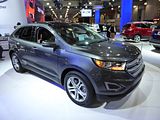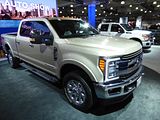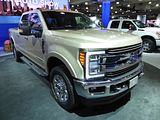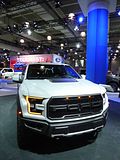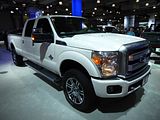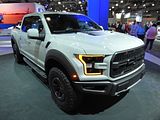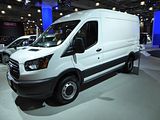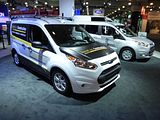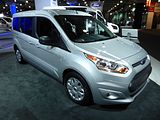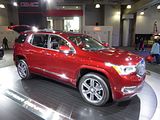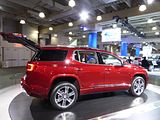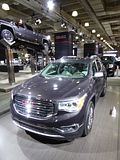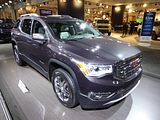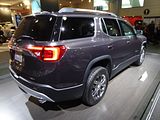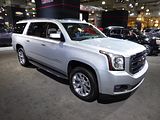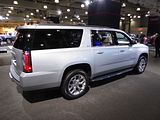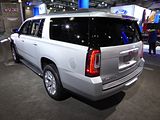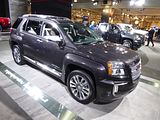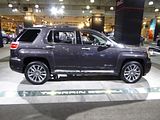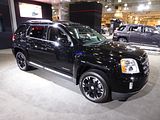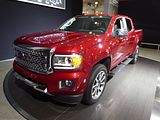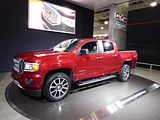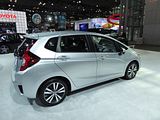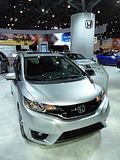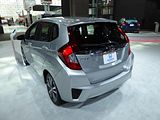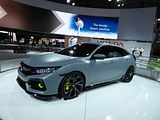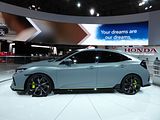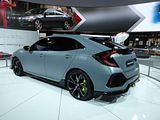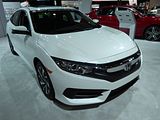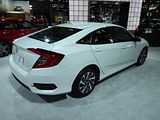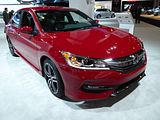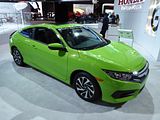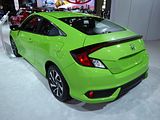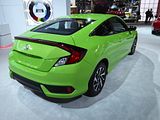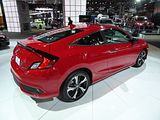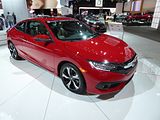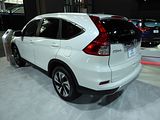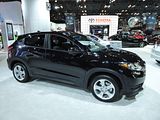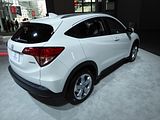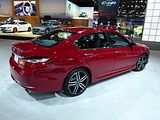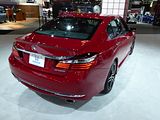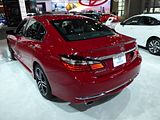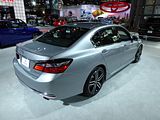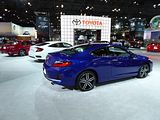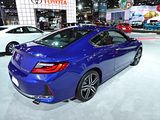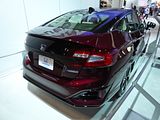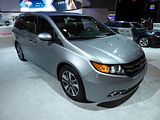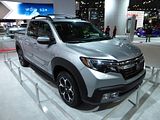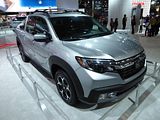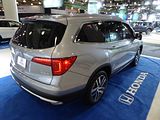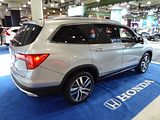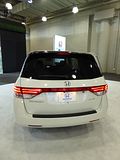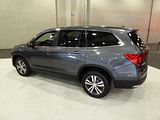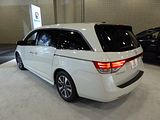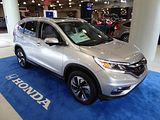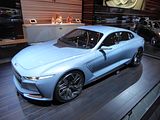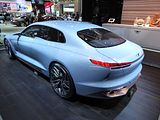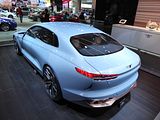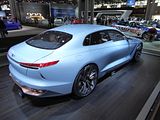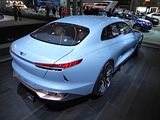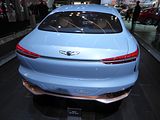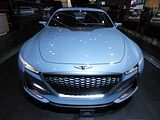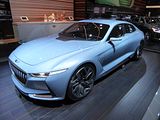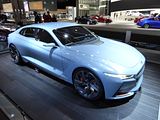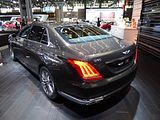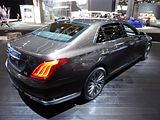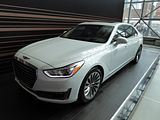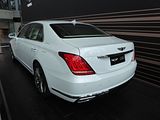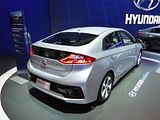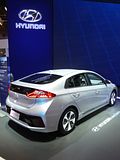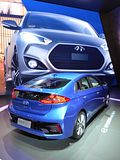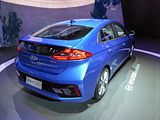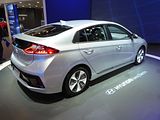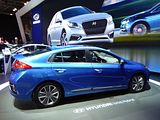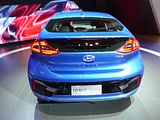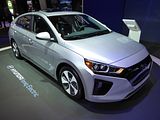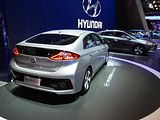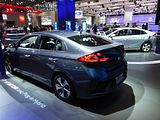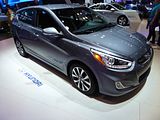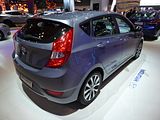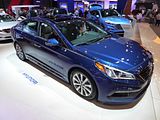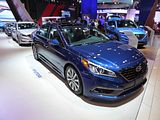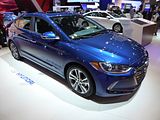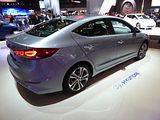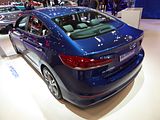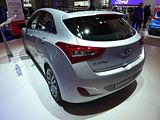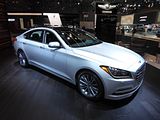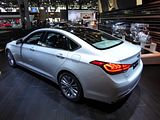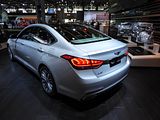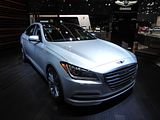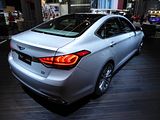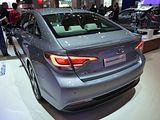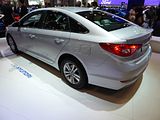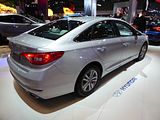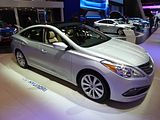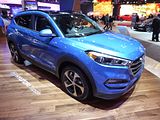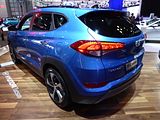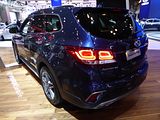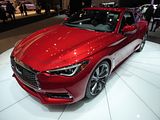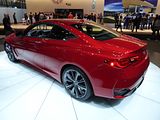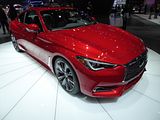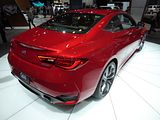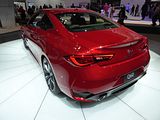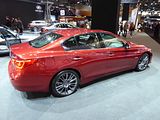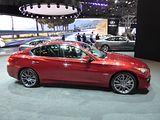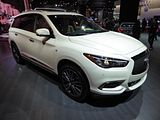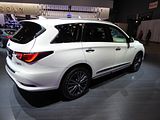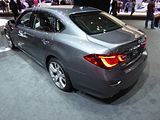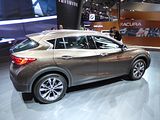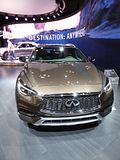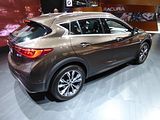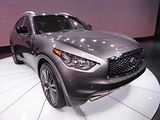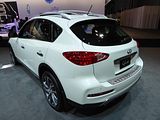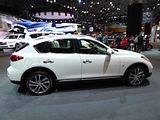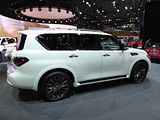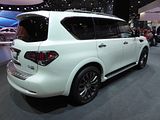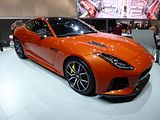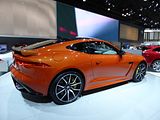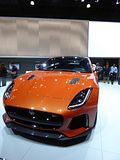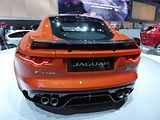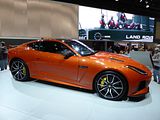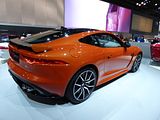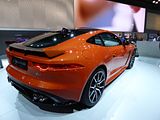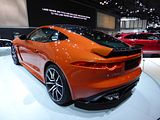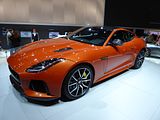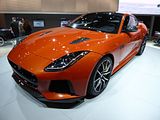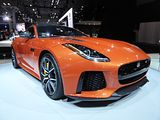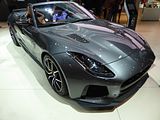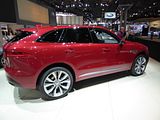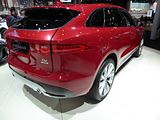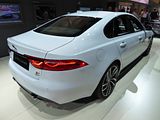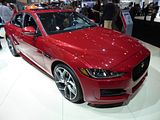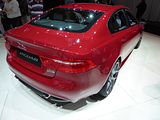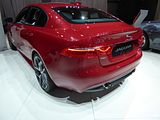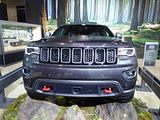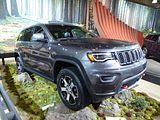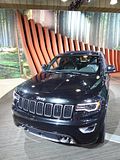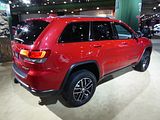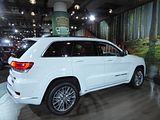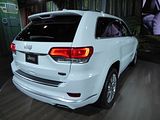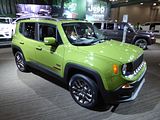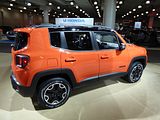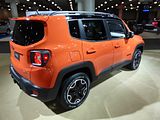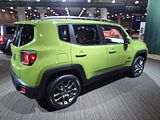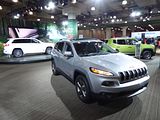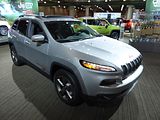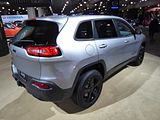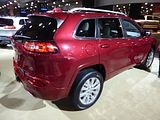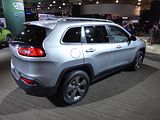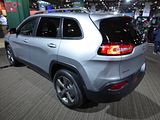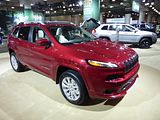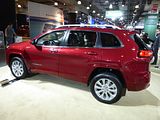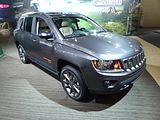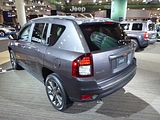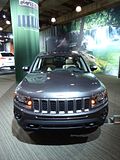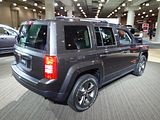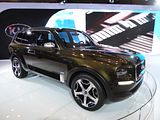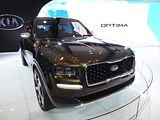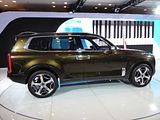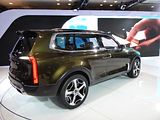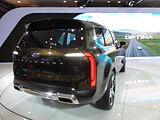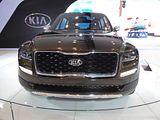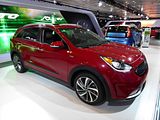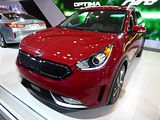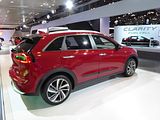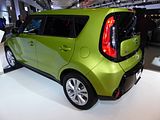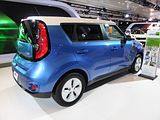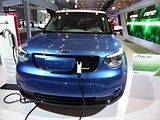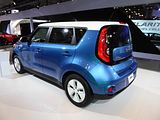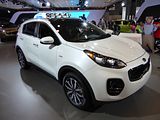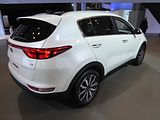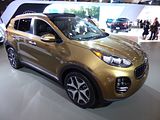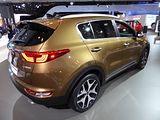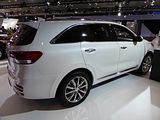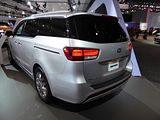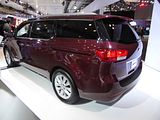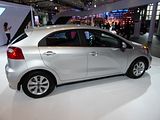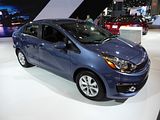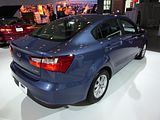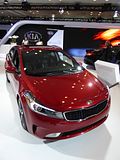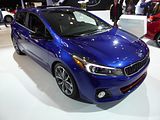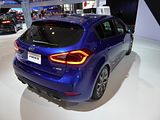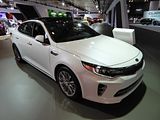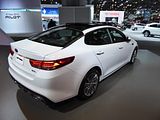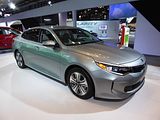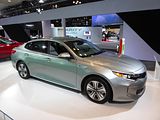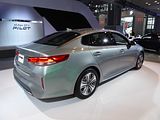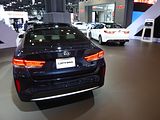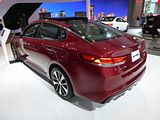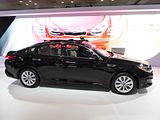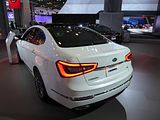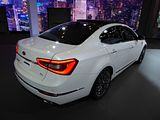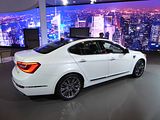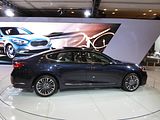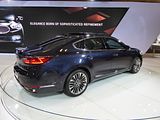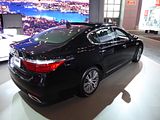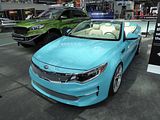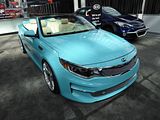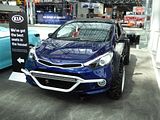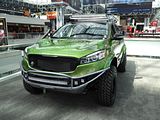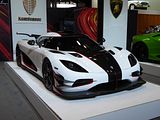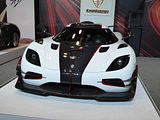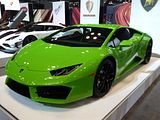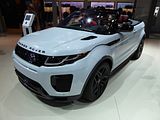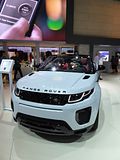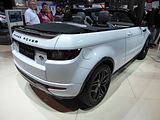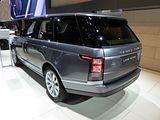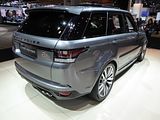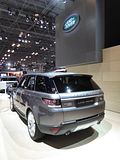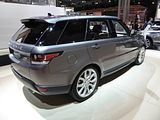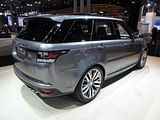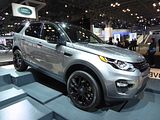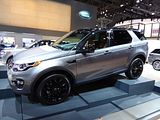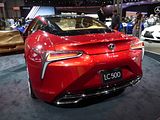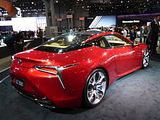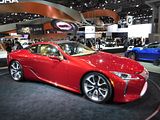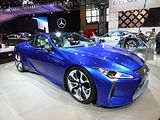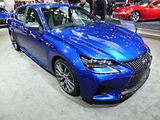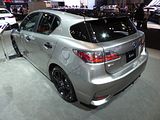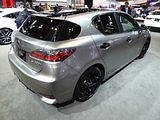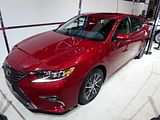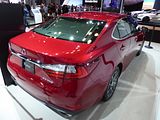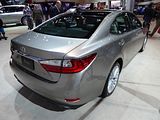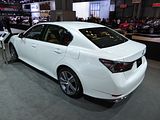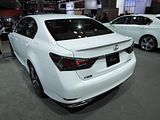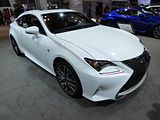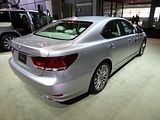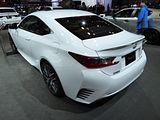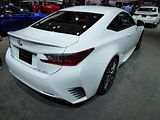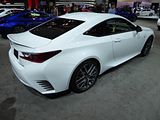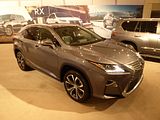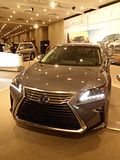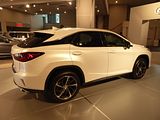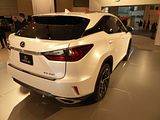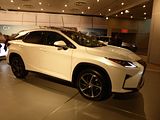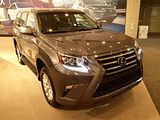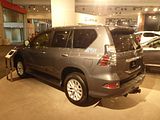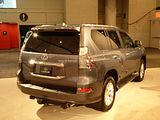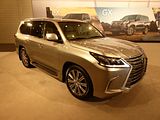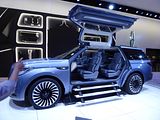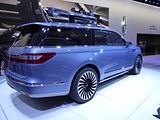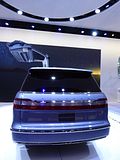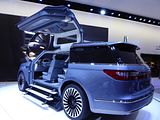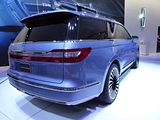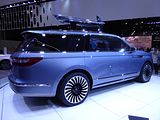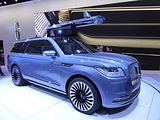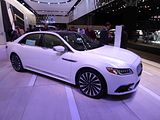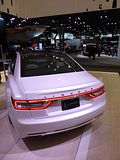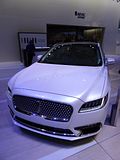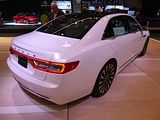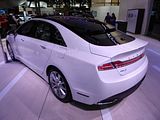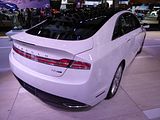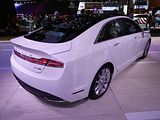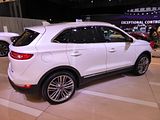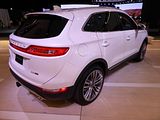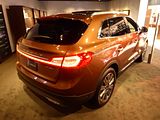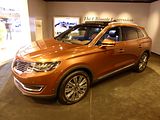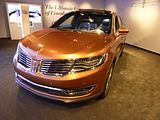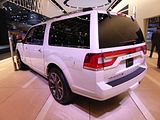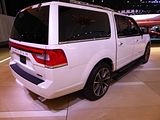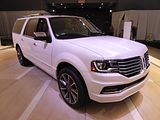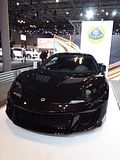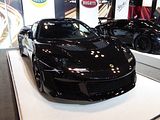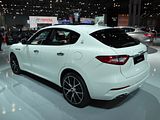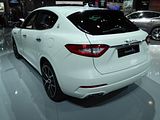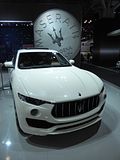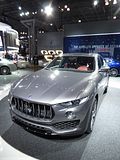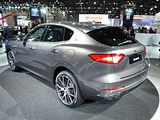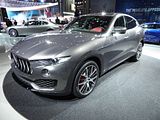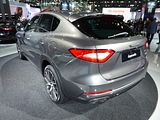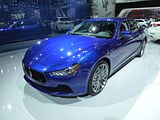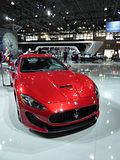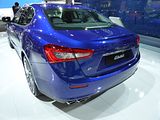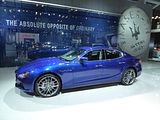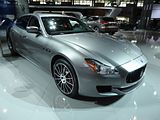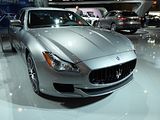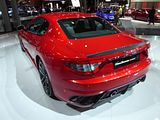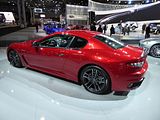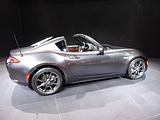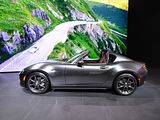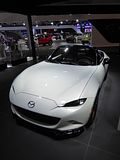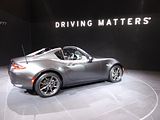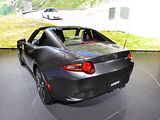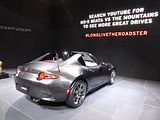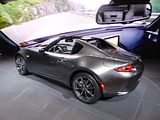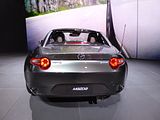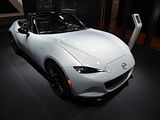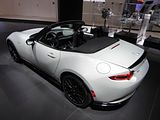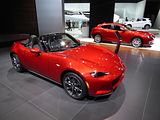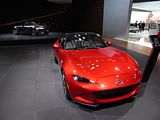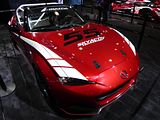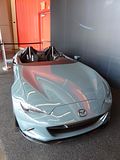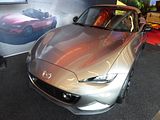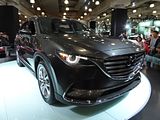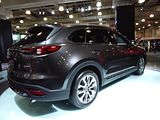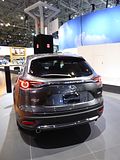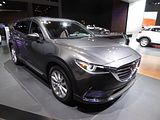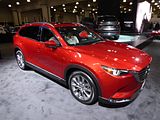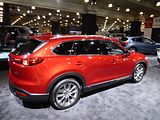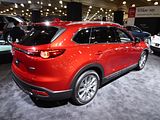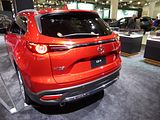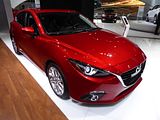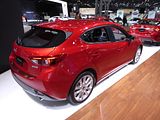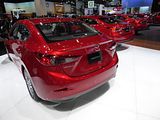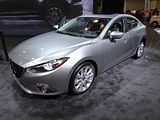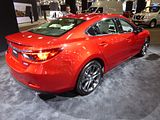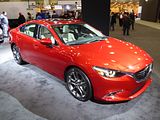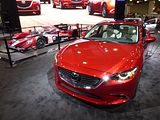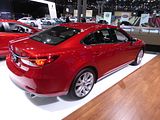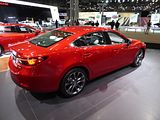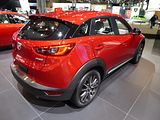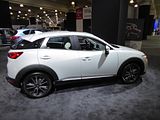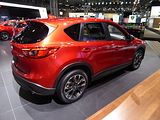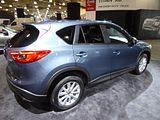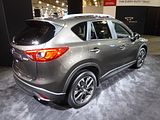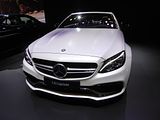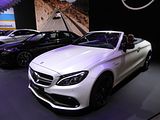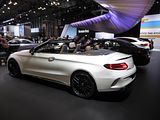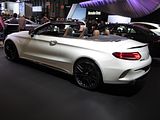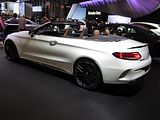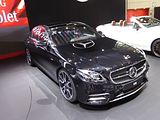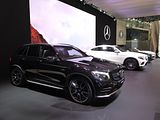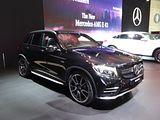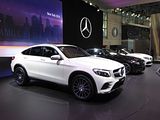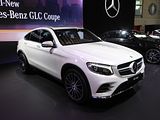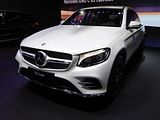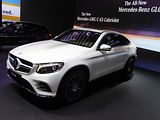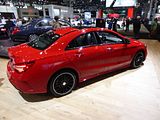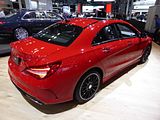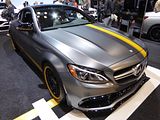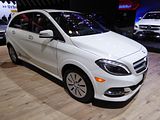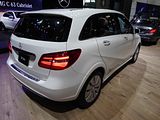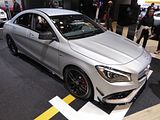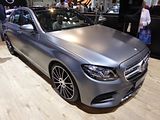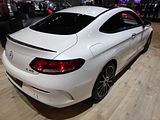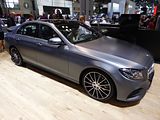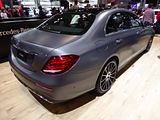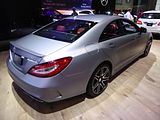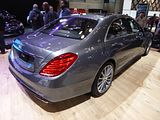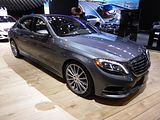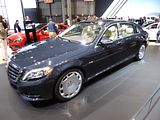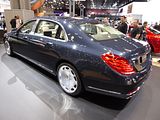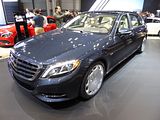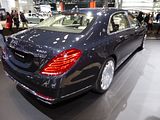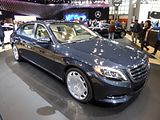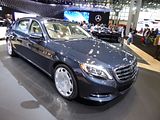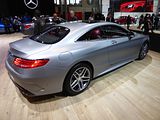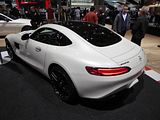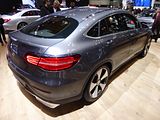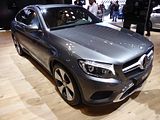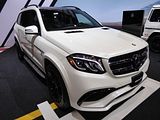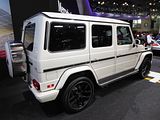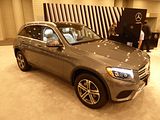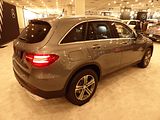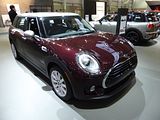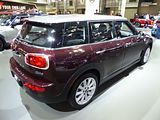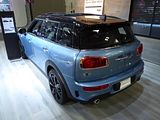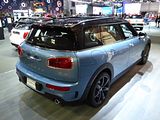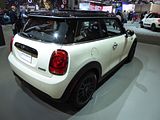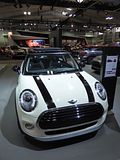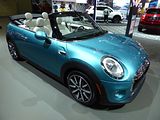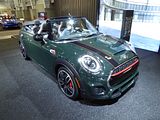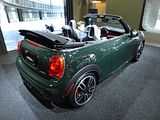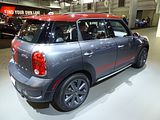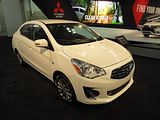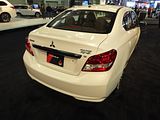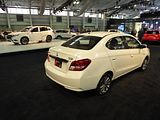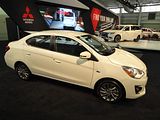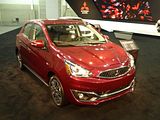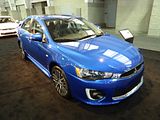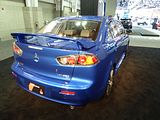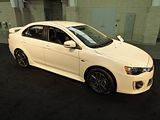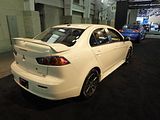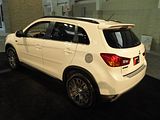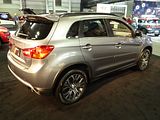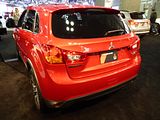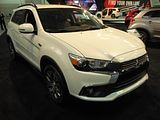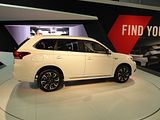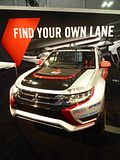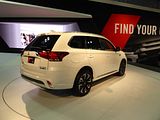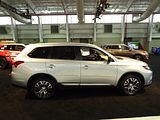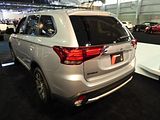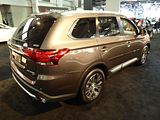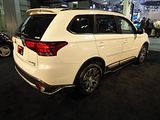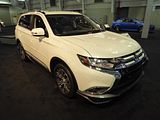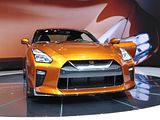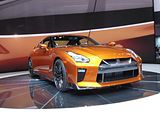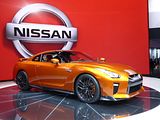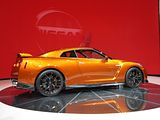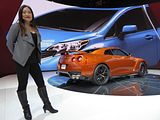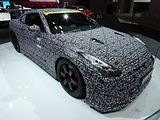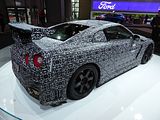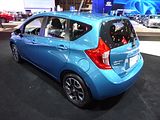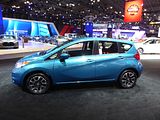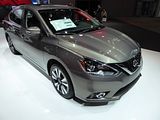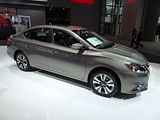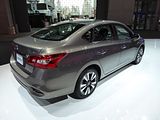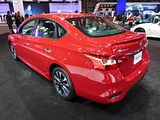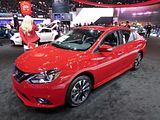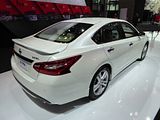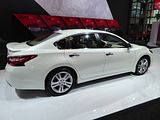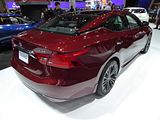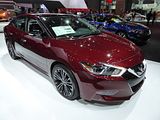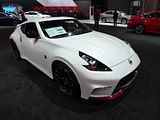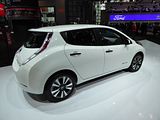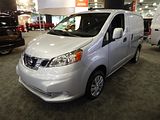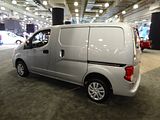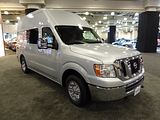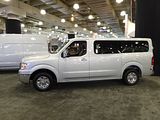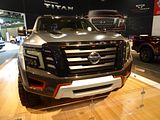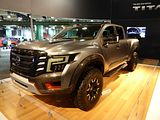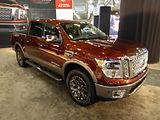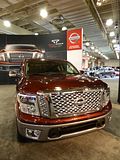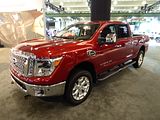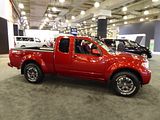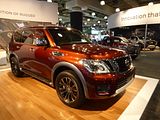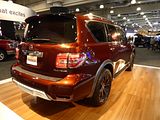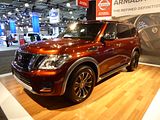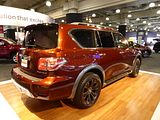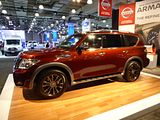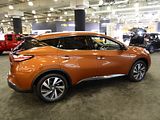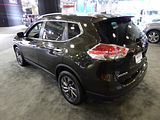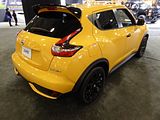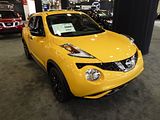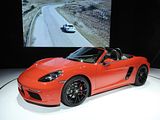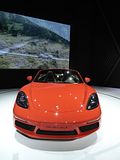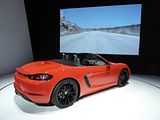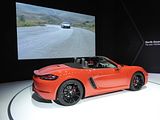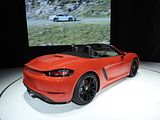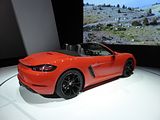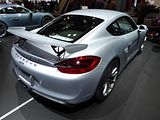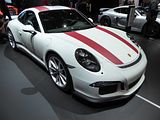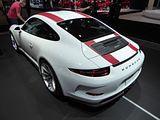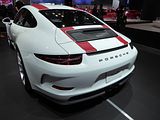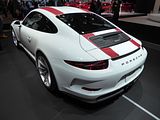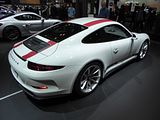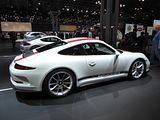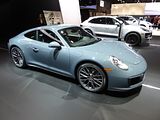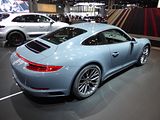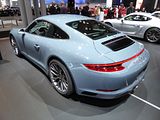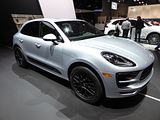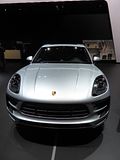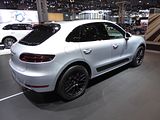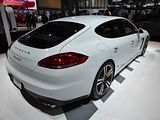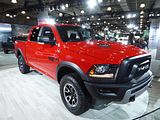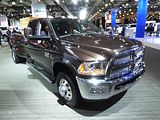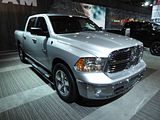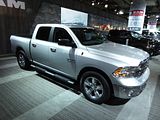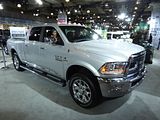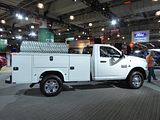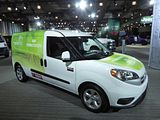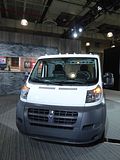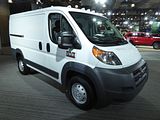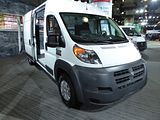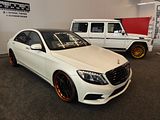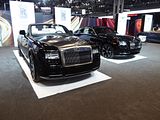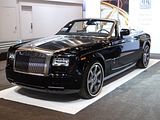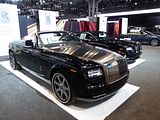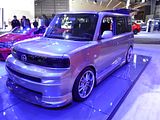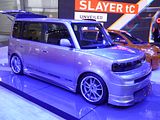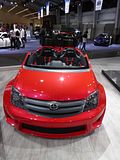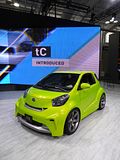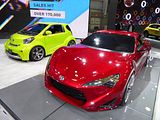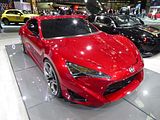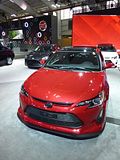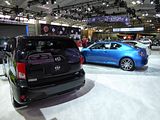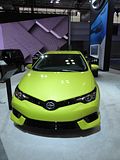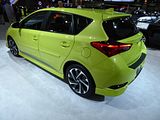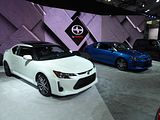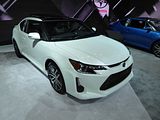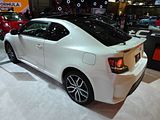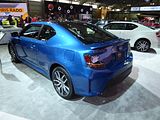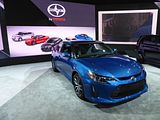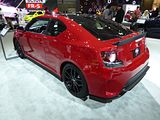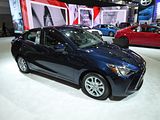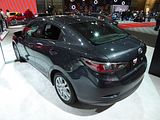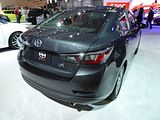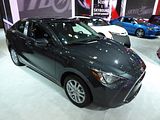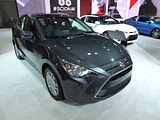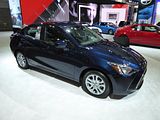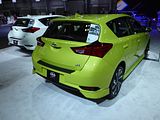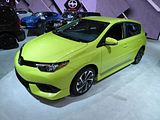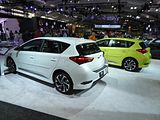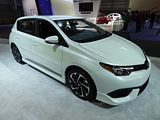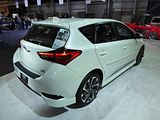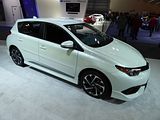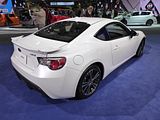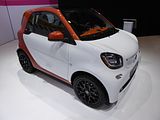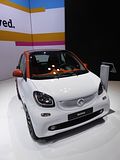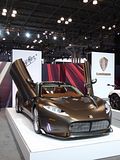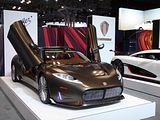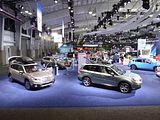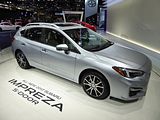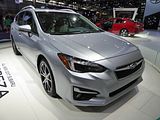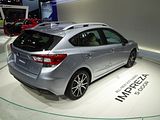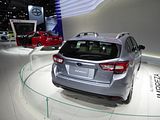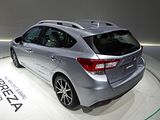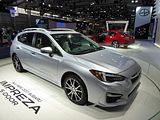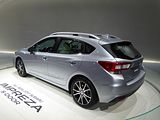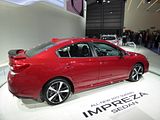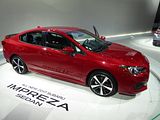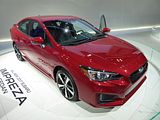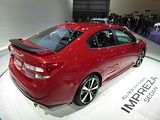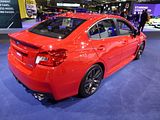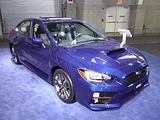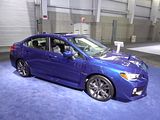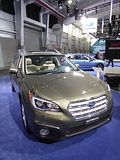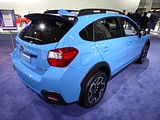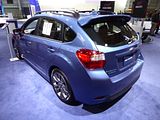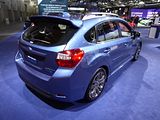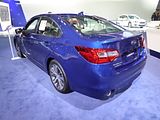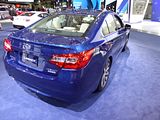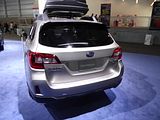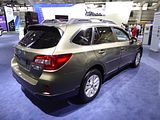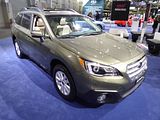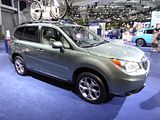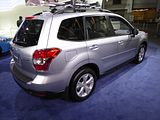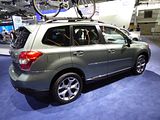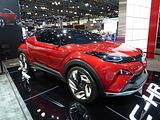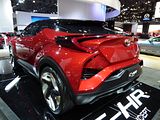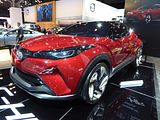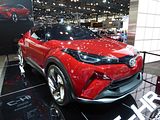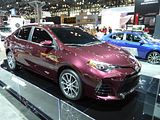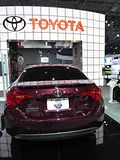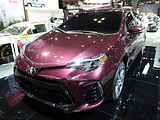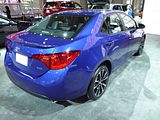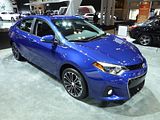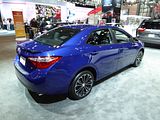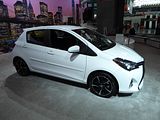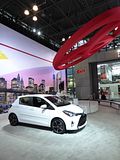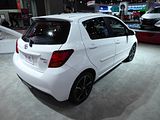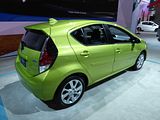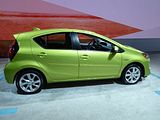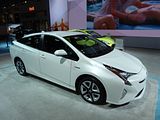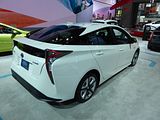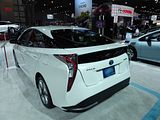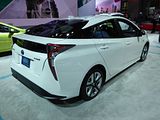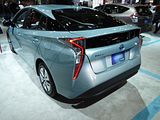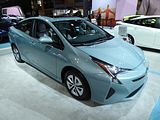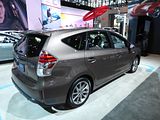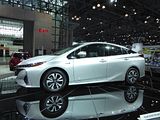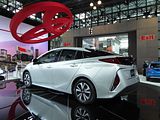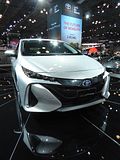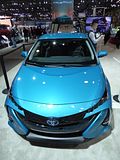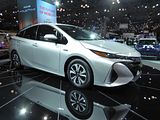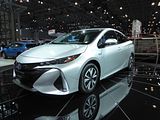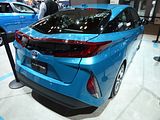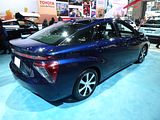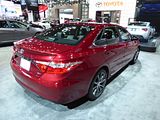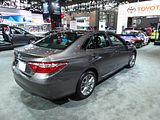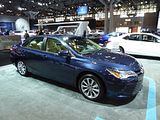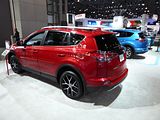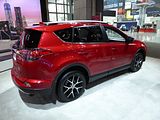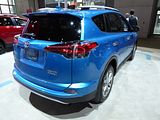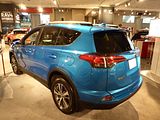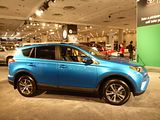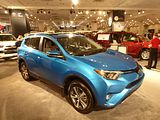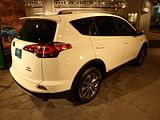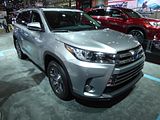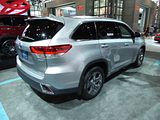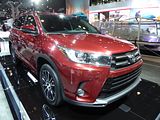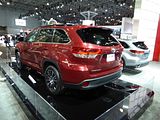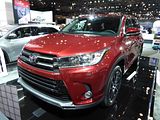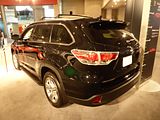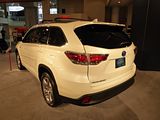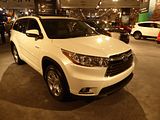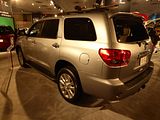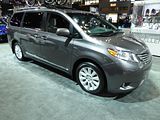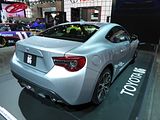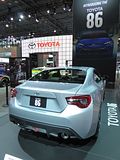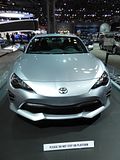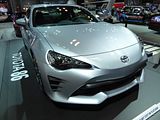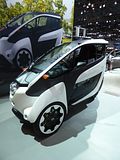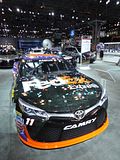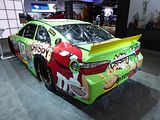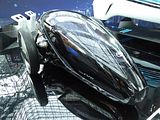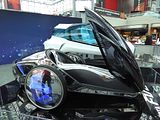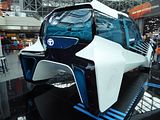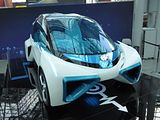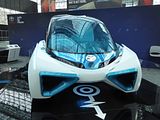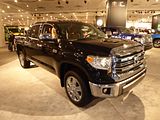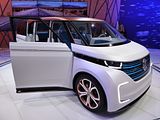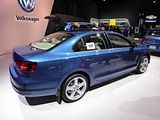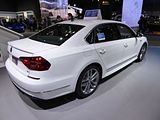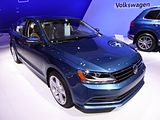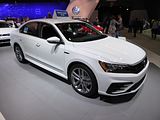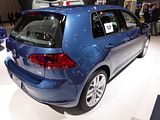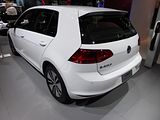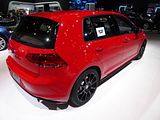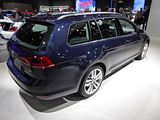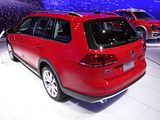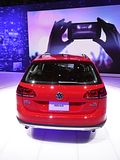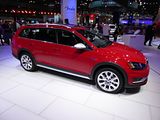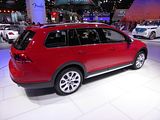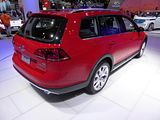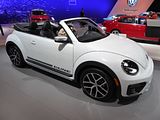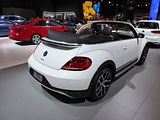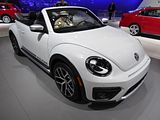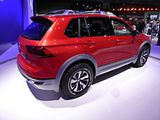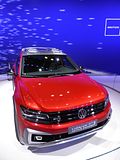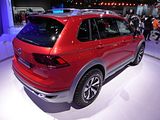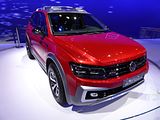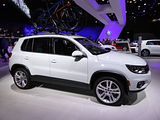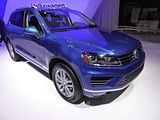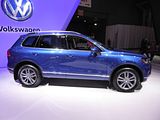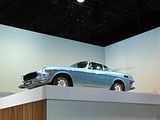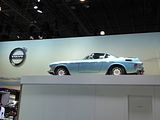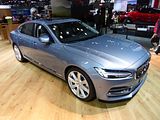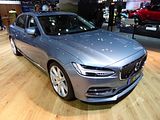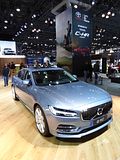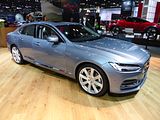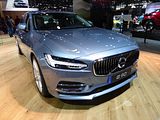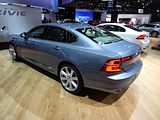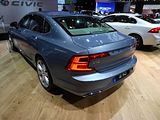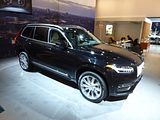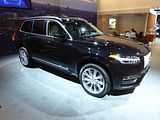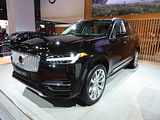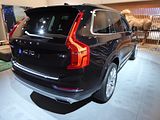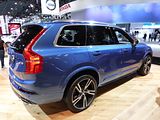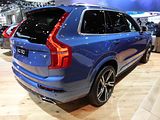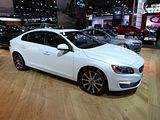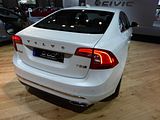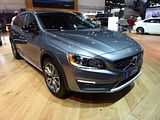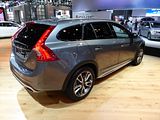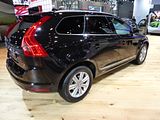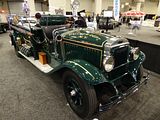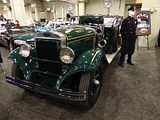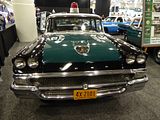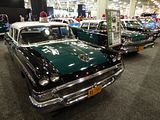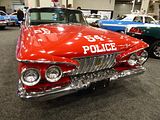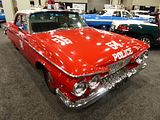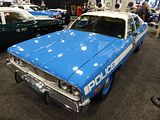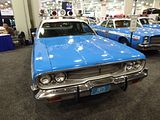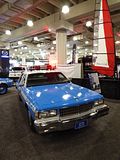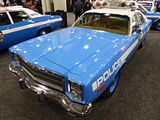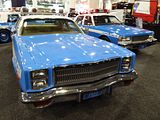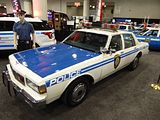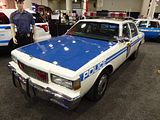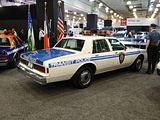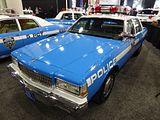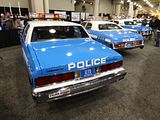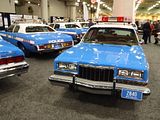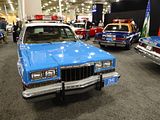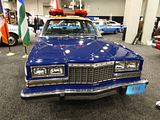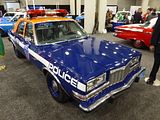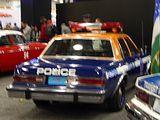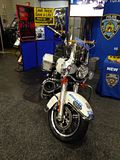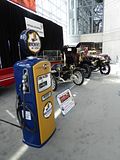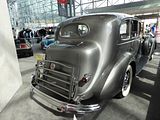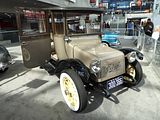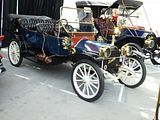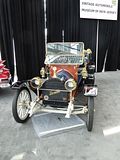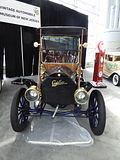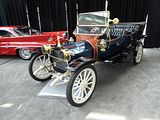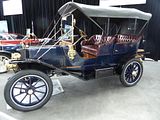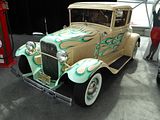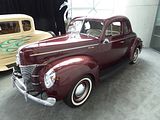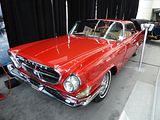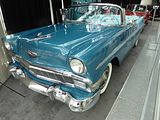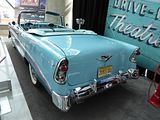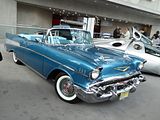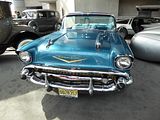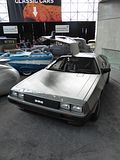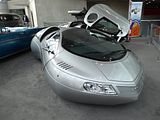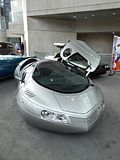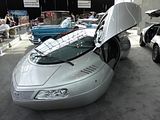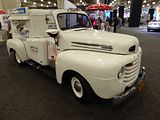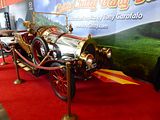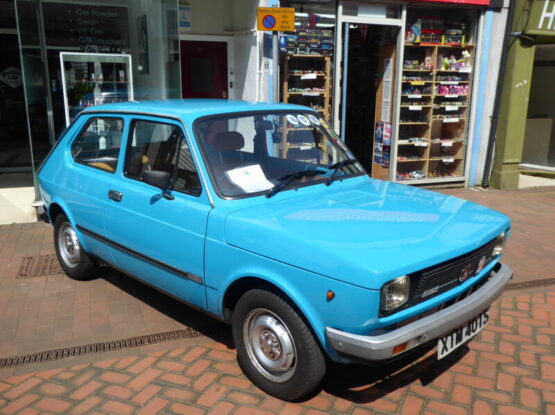As anyone who has visited will know only too well, probably from having made at least one spectacular mis-judgement of distances, America is an awfully big country. The concept of “national” does not really work when it involves an event somewhere in the country that would be accessible to the majority of the population. So, unlike smaller countries in Europe, there has never been a single “National” Auto Show in America. For sure, the one held in Detroit in January tends to be perceived by many, certainly those who are not familiar with the US, as America’s version of Geneva, Frankfurt or Paris. And in a way, the show that is currently titled the North American International Auto Show, is still the most important of the Shows held in America. It holds the position largely as a legacy of the fact that the US motor industry was centred on Detroit and it was therefore local to the domestic car makers, but over the last 20 or so years that has no longer been the case, especially after the Japanese brands established sizeable manufacturing plants in other parts of the country, and of course it has always been the case that there are larger centres of population and hence target buyers than that part of Michigan that sits between Lake Michigan and Lake Eerie. And so, those Shows that have long been held in the major centres of population have assumed a far greater significance with every year that passes, and the Big 3 other ones now receive plenty of global coverage. Those three are Los Angeles – which holds a show around Thanksgiving time, in late November – Chicago – their show being in mid February – and New York, which times its show to be around Easter. Production car debuts, and indeed the showing of the latest concept models is now shared out amongst these, with manufacturers relishing the opportunity to get a greater share of the announcement limelight if they can pick a show that their competitors did not, for their latest products. I’ve been to the New York Show a couple of times before, and enjoyed both visits, so when the timing of Easter meant that I was going to be in America whilst the show was taking place, I looked at the logistics for the 2016 event, and found an affordable way of including it in my vacation plans. I ended up taking a Red Eye flight from Phoenix to Newark airport, landing even earlier than scheduled, at about 5:30am. I had a hotel at the airport, so was able to drop off my bags and then took the local train from Newark into Grand Central, from where it was a walk of a few blocks west to the Javits Convention Centre. I was there, enjoying the spring sunshine some while before the doors opened, so had to retreat to a coffee shop (there are plenty of them on hand as you might imagine!) which was probably no bad thing, as the flight over, and hence the amount of sleep had been short, something which even the excitement of the day ahead could not entirely alleviate.
The New York Show is very manageable. There are two large halls for the cars, connected together by a covered walk way, and there is a further hall in the basement which is dedicated to Vans, Trucks and some trade stands. There are a few displays in the atrium area of the centre, and there are plenty of places offering food and drink throughout the site. I went on a mid-week day, and it never got very busy, so it was easier than usual not just to get a good look at the cars, but also to get photos most of which manage to avoid any human form in them. There was plenty to see, not least because I had missed the Los Angeles Show back in November, having been in Dubai at the time, but also as there were quite a lot of cars making either their global or American debuts. I ended up spending the whole day at the Show, leaving only when it closed, to head off to the hotel and a long sleep, as I was, by that time, pretty tired. Here’s what I saw:
ABARTH
Abarth is not considered a separate marque in America, as that would require all sorts of additional admin and things to set up which are not considered viable given the sales projections for the cars, but I like to pull them out separately when creating reports like this not least because it means that otherwise an alphabetic review would start with Acura, and that might just scare people off altogether! There are now two different Abarth models available in the American market, of course, with the launch of an Abarth version of the 124 Spider. This is more similar to the cars that Europeans buy than in this case for the 500, as it comes off the same line in Japan as the cars for the rest of the world, but it does have its own set-up for the American market, which means it is a little softer than the Euro spec cars, and more significantly 10 fewer horses than its European stablemate. That means is powered by the same turbocharged 160hp 1.4-litre MultiAir petrol unit as the regular 124 Spider. The Elaborazione Abarth will be available with a six-speed manual or automatic gearbox with paddle shifters. Fiat says that this combination gives it one of the best power-to-weight ratios in the segment, with Euro models tipping the scales at 1,060kg. Other new features include a new Sport driving mode, a mechanical limited-slip differential, a different suspension setup with mono-tube Bilstein front and rear shock absorbers and bigger brakes from Brembo. There was one example here on a turntable, in advance of the car going on sale later in the year.
There were also a couple of 500 models, a regular hatch and the 500C. As these are produced in Mexico, and sport a number of differences to those sold in the rest of the world, they have not been updated into 595s and nor do they have the Series 4 changes that were premiered at Geneva a few weeks before this show. Interestingly, some of the detailed differences, such as the filled-in area to create a glovebox and the different electric window switches are now being applied to those Series 4 cars, but these remain Multi Air powered, with a 160 bhp engine being the only available offering.
ACURA
And so to Acura, the “premium” offering from Honda that seemed to lose its way completely a few years ago, introducing cars that were universally condemned as ugly and just, well, unmemorable to drive. Sales volumes of several of the offerings were about as low as you can get without being one of those specialist manufacturers who only ever expects to sell a handful of cars a month. The proverbial penny did drop, and the styling excesses were toned down, and new models are all said to be “better” than what went before, but they compete in tough market sectors, so there is much competition which is making life hard, still. One way of increasing interest in the brand, of course, is to create a halo car. And Acura has done just that. After years of tantalising us with promises of a new NS-X, and then year after year of showing us a concept for one, the production car is finally here, and there was on stand. It was not exactly bringing huge crowds to the stand, but it was certainly helping, and was well worth a long hard look, especially as production volumes are not going to be big, so you are not going to see these on the road that often.
Acura is keen to establish the new NSX hybrid as a legitimate rival to the likes of Ferrari, Lamborghini, Aston Martin, Porsche and the rest, and what better way to do that than with a FIA GT3 entry. So revealed here was a twin turbocharged NSX GT3, still undergoing testing and slated for homologation as an FIA GT3 class racecar by the autumn of 2016, so it can campaign in North American competition starting in 2017. “The NSX was designed as a pinnacle expression of Acura Precision Crafted Performance, and we’re looking forward to proving out its ultimate performance capabilities in GT3 racing,” said Art St. Cyr, president of Honda Performance Development. “We’ll be working with the NSX engineering teams in Ohio and Japan to bring our dream of a truly world-class new Acura NSX racecar to fruition.” The GT3 model ditches the regular 2017 NSX’s hybrid and all-wheel drive setup, but keeps its 3.5-litre twin turbocharged V6 engine, including the block, heads, valvetrain, crankshaft, pistons and dry sump lubrication system, paired to a 6-speed, sequential-shift racing gearbox, driving the rear wheels. It sports custom bodywork and aero components including a large deck wing spoiler, underbody diffuser and enlarged hood vents for “efficient engine cooling”. While initial development was conducted by the company’s Japan-based race engineering arm with testing on race circuits in Europe and Japan, the NSX GT3 is now being honed by the company’s North American race engineering group, Honda Performance Development (HPD), in California.
Of the Acura models that are intended to sell in volume, it is the pair of SUVs that do actually find reasonable favour with buyers. The larger of these is the MDX, and a revised version for 2017 was making its debut here. Whilst Americans may be in love with SUVs, Acura’s “beak” grille was not liked much, so the Japanese car maker has decided to do away with it, starting with the 2017 MDX. First seen on the Precision Concept that debuted at the NAIAS in January, the diamond pentagon grille is part of the firm’s new styling and it is integrated in the sculpted hood. The front fascia benefits from restyled “Jewel Eye” headlights and new LED fog lamps. In the profile, we see a new chrome rocker panel, which acts as an element of contrast, while at the rear one can notice the revised bumper, body-coloured skid garnish and twin tailpipes. All trims come with electric parking brake with automatic hold function, SiriusXM Radio 2.0, four 2.5-amp USB charging ports and automatic high beam headlights, while advanced grades add LED fog lights, heated steering wheel, genuine Olive Ash Burl or Black Limba wood interior trim and Surround-View Camera system with six selectable viewing angles. The 3-person second-row seating can, on top-level versions, be replaced by two captain’s chairs and a center console with two additional USB ports and there’s an optional Advance ENT Package that adds an ultra-widescreen rear entertainment system for rear passengers. Available at an extra cost, the Technology and Advance packages add keyless remote engine start, HD Traffic, power folding side mirrors, two new 20-inch wheel and tire options. They also feature the Active Sport Suspension, which is in the Dynamics System and offers three dynamic modes (Comfort, Normal and Sport, and a Sport+ on the Hybrid), improving ride quality and handling. Joining the NSX supercar and RLX flagship sedan, the 2017 MDX sport Hybrid is the third model to feature the company’s three-motor Sport Hybrid SH-AWD powertrain. This uses a 3.0-litre DOHC V6 with Variable Cylinder Management mated to a 7-speed dual-clutch gearbox with an integrated electric motor, powering the front axle, while the two electric motors of the Twin Motor Unit power the rear wheels. Total system output is 325 HP (330 PS), 35 HP (36 PS) over the non-hybrid, and EPA fuel economy ratings are 25/26/26 in city/highway/combined. Also, apart from the advanced AWD, the MDX has electrified torque vectoring for improved straight line performance and cornering precision. All variants are equipped with the AcuraWatch suite of safety technologies that includes just about everything, from Lane Departure Warning to Adaptive cruise Control. The system can maintain a set speed and following interval, during freeway cruising, initiating throttle inputs and braking and adding steering input to help the driver maintain position in the current lane. Acura’s Design Studio in Torrance, California, was in charge of the new MDX design that was developed and engineered in Raymond, Ohio and will be manufactured at the same facility as its predecessor, in Lincoln, Alabama. In early 2017, it will also be assembled at the East Liberty, Ohio plant.
Joining it was the slightly smaller Acura Crossover, the RDX. Also an important model in the range, it can surely only be a matter of time before it receives the same styling updates as have been applied to its larger brother.
There are three sedan models in the range: the ILX is now the oldest of them, based on the previous generation Civic, and above it sit the TLX and very slow-selling RLX. All three were represented here, as well as a TLX car in race spec.
ALFA ROMEO
A small number of the highly desirable 8C Competizione models were sold in the US, but the relaunch of the brand in America only really started with the arrival of the 4C Competizione. Only ever going to be sold in small quantities, it was something of an attention grabber before the volume cars were ready. It has found appeal in the US, of course, though only in relatively small numbers Accordingly, there was a 4C Spider on show here.
Joining was something that would attract even more attention – at least among those who knew just how special it is: a 33 Stradale from the late 1960s, and a very rare car indeed. Bellissimo!
The presence of a significant number of Giulia models on the stand was confirmation that this eagerly-awaited sports saloon will soon be US-bound. The 2017 Alfa Romeo Giulia will be available to US market customers with a turbocharged 276hp 2.0-litre petrol engine mated to an eight-speed automatic transmission. Alfa claims that the 276hp Giulia needs less than 5.5 seconds for the 0-60mph sprint, with the top speed standing at 149mph. The new eight-speed automatic transmission is designed with enthusiasts in mind, offering gear shifts that take less than 100 milliseconds. Customers will also have the option of Alfa’s new Q4 AWD system on Giulia and Giulia Ti models for better all-weather traction. Every model will come with a class-exclusive carbon-fibre driveshaft, leather upholstery, a seven-inch digital display in the instrument binnacle and Alfa’s DNA selector with Dynamic, Natural and Advanced Efficiency driving modes. Infotainment options include a 6.5-inch or a 8.8-inch widescreen display. Next to the regular Giulia was the Quadrifoglio version which is powered by a twin-turbo 2.9-litre V6 with 505hp, allowing it to accelerate from zero to 60mph in 3.8 seconds and lap the Nurburgring in 7:39 minutes. Top speed is rated at 191mph. Performance-wise the range-topping Giulia offers a four-mode DNA Pro selector with an additional Race driving mode, a torque vectoring differential, six-piston Brembo brakes at the front and four-piston ones at the rear.
AUDI
Highlight on the expansive Audi stand was a three car display of second generation R8 models which included the Spyder version which was making its global debut here. There is a a weight penalty of 158 kg (348 lbs) on top of the coupe, but it is still significantly lighter than its predecessor. Presented in base form at the Big Apple event, it tips the scales at 1,612 kg (3,554 lbs), meaning 113 kg (249 lbs) less than what the previous Spyder used to weigh, and in this version, its 532 HP (540 PS) and 398 lb-ft (540 Nm) of torque allow a zero to 62 mph (100 km/h) time of just 3.6 seconds, meaning 0.1 seconds slower than the Coupe. Behind the V10, there is a familiar 7-speed S tronic gearbox, which sends power to the Quattro all-wheel drive system with an electro-hydraulically activated multi-plate clutch, at the front axle. In extreme cases, up to 100 percent torque can be sent to either the front or the rear wheels. Incorporated into the Audi drive select system, the intelligent control offers four driving modes, from dynamic to comfort-oriented, joined by the three driving programs that will make the machine cope with dry, wet or snow-covered road surfaces. Underneath its folding fabric roof, which takes 20 seconds to retract and can be opened or closed at speeds up to 31 mph (km/h), Audi has added its large 12.3-inch virtual cockpit, MMI navigation plus with MMI touch as standard, voice control and the firm’s smartphone interface, which makes it possible to display selected content from the device into the virtual cockpit. This will become available as an option, from this summer, on the R8 Coupe too. The four-ring brand will hand-build the new Audi R8 Spyder at a manufacturing facility near Neckarsulm, Germany, and it will offer it on sale later this year.
Entry point for Audi in America is the A3, as the smaller A1 model is not sold on US shores. Americans get a more limited range of A3s than Europe does, too. The three door body is not available at all, and the Sportback is only offered in eTron guise. There was an example of that car here, as well as the Saloon and the Cabrio.
With a range of several different Crossover/SUV models on offer, Audi has not bothered to import the Avant versions of their A4 and A6 to America for a while now, but those buyers who want the less bulky body-style can get the Allroad versions, and 2016 marks the arrival for the first time of the smaller of the two cars, the new A4 Allroad in B9 guise. This comes standard with Audi’s all-wheel-drive system and sports the same tailored elements that transformed previous generations of Allroads from regular estates into daring, adventuring cross-overs. So, when it comes to the exterior, this really does just look like a lifted A4 Avant with a higher ground clearance and body cladding. Not anything about this model is all-out rugged, though even if its new version of the “Audi Drive Select” comes with an off-road mode in addition to the existing comfort, auto, dynamic, efficiency and individual functions, as its sports a chrome-rich front grille and can also be commissioned with 17 inch or 19-inch wheels; traits that make the car a suitable choice for a wide array of occasions. In Europe the A4 Allroad comes with a plethora of powerplants for buyers to choose from, including five TDI engines, in the US, the car will be sold exclusively with a 2.0-litre turbocharged petrol four-banger, rated at 252PS (249hp) and 273 lb-ft of torque.
Ingolstadt’s newest rival to the BMW 3-Series and Mercedes-Benz C-Class, the A4 sedan, was also present at the Auto Show, accompanying the all-terrain variant in the line-up.
S and RS models, especially in the upper echelons of Audi’s range are rare sightings in Europe, where the fiscal regime and fuel prices make them costly to run as well as to buy. In parts, at least, of America, they find rather more buyers, and so Audi keeps showing us, as do their arch rivals, with a slew of new models and versions that they have no apparent intention in backing down on the horsepower wars. So it shouldn’t come as a surprise that they’re branching out, creating new sub-segments and sub-monikers for their high-performance editions. The S7 model that was on show here was joined by the RS7 Performance and S8 Plus, two such recent additions to the range, with both packing an improved 4.0-litre twin turbo V8 punching out 605PS (597hp) and 700Nm (516lb ft) of torque with an additional overboost function that sends the torque figure up to 750Nm (553lb ft).
Back in the rather more prosaic and practical world, Audi offer a trio of SUV models, and they were all on show here: the Q3, which was only recently added to the US range, as well as the Q5, which is the best-selling model here, and a Q7.
Final car on the stand was the TT-S, an example of the third generation of Audi’s sports coupe.
BENTLEY
A couple of Bentley models were on display: the new Bentayga SUV that is about to go on sale in the UK and the established Continental GTC.
BMW
BMW had a large stand here, and it was always busy, though nothing like as much so as is the case at European shows. BMW were making much of the recent announcement of iPerformance, for plug-in hybrid vehicles, with the US spec 330e being launched here. This 248hp 330e will go on sale in the States in the summer starting at $44,695 including destination and handling. Before we go over the 330e, here’s some food for thought; the asking price for the PHEV is $3,850 more than the 180hp 2.0 litre four-cylinder diesel 328d ($40,845), and $5,350 more than the, comparable in regards to performance, 240hp 2.0 litre four-cylinder gasoline 328i ($39,345). All cars come with a standard 8speed automatic. Given that the 330e iPerformance is marketed as a high-efficiency model, buyers should take into consideration the fact that, the price difference over the 328d, will let owners of the latter cover 66,000 miles – with the average price of diesel in the States currently hovering around $2.1 a gallon, and the EPA rating the diesel at 36mpg combined, before breaking even. In the case of the 328i, with the average price of 1 gallon of premium gasoline fuel on March 21 standing at $2.46, according to the US Energy Information Administration, and the EPA giving the car a combined economy rating of 27mpg, you’ll cover nearly 59,000 miles before making up the difference in pricing with the 330e. The EPA has given the 330e iPerformance a gasoline engine only combined rating of 31mpg and an electric and gas engine rating of 72MPGe. According to the government agency, whereas the 330e will save you $750 in fuel costs over 5 years compared to the average new vehicle, or the same as the $39,345, 240HP and 27mpg combined 328i, the 328d will double that at $1,500. The 330e draws its power from a 2.0-litre turbo’d four-cylinder petrol engine delivering 180 hp and peak torque of 215 lb-ft, which works in tandem with an electric motor, developing 87 hp with maximum peak torque of 184 lb-ft, for a system output of 248 hp and 310 lb-ft. This allows for a sprint from 0 to 60 mph in 5.9 seconds and a top speed of 140 mph. Pure-electric driving is possible at speeds of up to 75 mph and with a range of around 14 miles. The 328i reaches the 60mph mark in 0.1 seconds faster at 5.8 seconds and has an available de-limited top speed of 150mph (otherwise regulated at 130mph), while the 328d diesel is notably slower at 7.4 seconds, but can reach a de-limited top speed of 143mph (otherwise restricted at 130mph). Without taking into consideration any differences in equipment and how the three cars drive on the road, after a first glance at the numbers, both the 328d and the 328i seem like better financial choices than the 330e. It will be interesting to see if the market agrees.
Displayed alongside it was another member of the iPerformance family, the 740e.
Following its online unveil last year, the M2 is now being seen in America. It debuted at Detroit, where the firm announced its first pricing details and was making an appearance here, too. BMW’s smallest M car starts from $51,700 and, for the money, customers get a lot of standard features that include the xenon headlights, adaptive light control, DRLs, shadowline exterior trim, 19-inch black light-alloy wheels wrapped in 245/35 front and 265/35 rear tyres, as well as auto-dimming rear and and side mirrors, electrically-adjustable and heated sports seats, carbon fiber interior trim, rain and light sensors, multi-function steering wheel, keyless entry, universal garage-door opener, smoker’s package, dynamic cruise control, ambient lighting, navigation, sat-radio with 1 year subscription, Harman Kardon sound system, Assist, eCall, TeleServices, Online and Apps, advances real-time traffic info and more. The non-metallic Alpine White colour comes at no extra charge, while the Black Sapphire, Mineral Grey and Long Beach Blue metallic ones cost a reasonable $550. The Executive Package, with its rearview camera, Park Distance Control, automatic high beams, Active Driving Assistant, Speed Limit Info and heated steering wheel costs $1,250. Hardcore drivers will be more than thrilled with the standard 6-speed manual gearbox, but for the rest a seven-speed M double-clutch transmission is priced at $2,900. Joining it on the stand was an M235i Coupe.
Up a size, there was the M3 and a 4 Gran Coupe to inspect.
Also from the 4 Series was the limited production 2016 M4 GTS, a track-focused special that’s completely street-legal packing 500PS or 493hp under its bonnet and having recorded a Nürburgring lap time of 7 minutes and 28 seconds – that’s nearly 30 seconds faster than the standard M4. Production is limited to 700 units worldwide, with the US market grabbing 300 of those at an as of yet, undisclosed price. So, BMW M3 enthusiasts who…haven’t already spent their life savings on E30s and E46s offered at ludicrous prices over the years, will have a chance at obtaining one of the cars coming to the States – but you’d better hurry before the GTS turns into the another 1M Coupe on the market. Previewed by the M4 GTS Concept at this summer’s Pebble Beach Concours d’Élégance, the production car remains unchanged and is both a performance beast and a technological showcase for the BMW brand marking two industry firsts, the Water Injection System that provides a substantial power boost and the OLED (Organic Lights with LED) tail lamps. Powering the GTS is the M4’s 3.0-litre turbocharged straight-six that has been modified with the incorporation of BMW’s proprietary water injection technology, first used on the BMW M4 MotoGP Safety Car. What this system does is inject a fine spray of water into the intake manifold plenum chamber (where it evaporates), significantly lowering the temperature of the intake air, which in turn, reduces the final compression temperature in the combustion chamber thus allowing for an even higher boost pressure for increased power. More specifically, the S55 twin-turbo six produces 493hp (500PS) at 6,250rpm and 442 lb-ft (600Nm) of peak torque between 4,000 and 5,000rpm, a notable increase over the regular M4’s 425hp (431PS) between 5,500 and 7,300rpm and 406 lb-ft (550Nm) between 1,850 and 5,500rpm respectively. BMW claims that fuel consumption remains at the same levels on the European cycle, but there is a minor catch / inconvenience with the Water Injection System; the chamber that holds the 1.3 gallon / 5 litre water tank in the boot needs to be topped off as often as every refuelling under hard track driving or every fifth refuelling interval if you’re cruising on the highway. Offered exclusively with BMW’s 7-speed M double-clutch transmission that gets a specially configured Launch Control system in manual mode, the GTS can reach 60mph in just 3.7 seconds or 100km/h in 3.8 seconds, and is free to top out at 190mph or 305km/h. While some competitors may have more oomph under the hood, like Mercedes-AMG’s C63 S Coupe that boasts 503hp (510PS) from its bi-turbo V8, BMW focused on the power-to-weight ratio making the GTS 80kg or 176 pounds lighter than the standard M4 through a series of measures. These include the removal of the rear seats, the use of aluminum for the control arms, wheel carriers and axle subframes, carbon fibre reinforced plastic (CFRP) for the bonnet (in addition to the roof) and the front and rear spoilers, Carbon Ceramic brakes and a titanium exhaust system. BMW’s M division also gave the GTS a specially designed, full three-way adjustable M coilover suspension, additional spoilers, including a huge rear wing, a re-worked electromechanical steering system, an enhanced Active M slip differential, reconfigured electronic aids, and Michelin Pilot Sport Cup 2 tires shod in 265/35 R19 wheel front and 285/30 R20 rear with some very…1970s Pontiac Firebird Trans Am Bandit lightweight alloys. There are plenty of changes inside with the M4 GTS making no effort to hide its track-focused nature, not only with the removal of the rear seats, but also with the fitment of a roll bar, a pair of lightweight racing bucket seats with a six-point harness, which sadly, won’t be offered in the States due to regulations, a fire extinguisher, Alcantara steering wheel and trim, and fabric door pulls. Four colours will be available for the exterior, including Sapphire Black metallic, Mineral Grey metallic, Alpine White and Frozen Dark Grey Metallic paint finish.
The first car to bear the iconic M badging was the M1, long since out of production, and now a well respected classic. An example of this model was on show mounted in an upstairs area that most show-goers could not directly access.
Also familiar were the 5 Series and the 6 Series Coupe both on show here.
BMW has not graced us yet with an M7, but it continues to work with Alpina to give us the best alternative, with their new B7 xDrive, and the latest version was shown at Geneva a few weeks before this show, so this was its US debut. The third generation of the full-sized luxury sedan uses a 4.4-litre twin-turbo V8 engine, connected to an 8-speed Sport Automatic Transmission with Alpina Switch-Tronic made in collaboration with ZF, that delivers an impressive 600PS (592hp) 608PS (600hp) between 5,750 and 6,250rpm, and 590lb-ft (800Nm) of torque, available from 3,000rpm. The figures were achieved by performing a number of technical upgrades in the air intake, intercooler, turbocharging, pistons and sports exhaust system and they allow the “BMW M7” to go from naught to 60mph in just 3.6 seconds, on its way to a top speed of 193mph. Not until long ago, these were considered supercar figures, but they can be achieved in the tweaked BMW 7-Series and controlled by switching the Driving Dynamic Control between Comfort and Sport Mode. Modifications were made to the suspension system too, but the focus was to retain “he exceptional long-distance cruising comfort of the predecessor while at the same time significantly sharpening tthe agility, handling and lateral dynamics“. Adaptive dampers, active roll bars and four-wheel steering are present as well. The car rides on 20-inch Alpina Classic wheels, wrapped in 255/40 front and 295/35 rear Michelin performance tyres that cover the 15.5-inch front (with four-piston fixed calipers) and 14.5-inch rear (with floating calipers) high-performance braking system. Optional 21-inch forged wheels are available. On the outside, the car has maintained the BMW kidney grille, which was fitted with “an integrated air flap control system that adapts to the BMW Alpina B7 xDrive’s cooling needs“, while it also sports two elliptical twin tailpipes, integrated in the rear apron. The design is complemented by the bespoke Alpina Blue Metallic and Alpina Green Metallic paints. An extensive range of standard equipment is offered inside, including high-end Nappa leather, ceramic inserts, soft close doors, comfort seats, leather-wrapped instrument panel, full-color HUD, rearview camera, latest BMW navigation, communication and infotainment systems. Other goodies found are the sports steering wheel with blue and green stitching, Timeless Piano lacquer or classic Myrtle Luxury Wood, door sills with blue illumination, Alpina B7 model inscriptions and full-color digital instrument panel in LED technology. In Comfort Mode, the car has a classical look with round instruments, blue background and red needles, while in Sport mode, the design changes to blue and green drag indicators and focuses on primary information, such as the centrally positioned permanent digital speed read-out.
Alongside it was the new performance-focused BMW M760Li xDrive, the closest the company has got to an M7, which was also making its North America debut at the Show, following on from its global debut in Geneva. The first M760Li xDrive models will arrive in the United States in early 2017 and represent the pinnacle of the 7-Series range, offering a legitimate alternative to the Mercedes-Benz S63 and S65 AMG. While the new Alpina B7 has a twin-turbo V8, the BMW-branded opposition has a twin-turbo 6.6-litre V12 that pumps out 592 hp at 5,500 rpm and 590 lb-ft of torque at 1,500 rpm. Coupled to that massive engine is an 8-speed automatic transmission powering all four wheels and resulting in a 0-100 km/h (62 mph) sprint time of just 3.9 seconds as well as an electronically limited 250 km/h (155 mph) top speed. Like the B7, the M760Li xDrive is adorned with a plethora of eye-catching design elements that make it stand out. They include larger front air intakes, different twin five-spoke wheels, bright blue brake calipers and quad rectangular exhausts.
The second generation X1 has come over to the US, to join the larger X3 and both were displayed on the stand here.
Representing the X4 was the M40i model that was launched at Detroit. Priced at $57,800 in the US, BMW’s top of the range X4 promises to offer more bang for your buck than the car many will see as it most direct rival, the Porsche Macan. Not that an exact comparison is that straight-forward. The BMW has 360 PS to go with its 465 Nm (343 lb-ft) of torque, which puts it on the same level as the Macan GTS, performance wise. The GTS also comes with 360 PS, though a bit more torque at 500 Nm (368 lb-ft). It will also zip past the 100 km/h (62 mph) mark in 5.2 seconds, which is 0.3 seconds off the pace of the cheaper X4 M40i. And by the way, we’re talking about a $10,000 price difference, which is hard to ignore. So then, which Porsche Macan can you get for the same money as the range-topping X4? Well, the ‘S’ version, obviously, which will set you back about $54,400 in the US. The problem with the Macan S at that price is that it’s half a second slower to 100 km/h than the Bimmer and people who tend to buy these flagship speedy SUV models, tend to appreciate these types of performance figures, otherwise they’d just get the 2nd-most expensive version and check all the optional extras. That’s all very well, but just about every test has concluded that the Macan is an excellent car, and the X4 just isn’t in the same league. Of course, it now has another rival, the AMG version of their GLC Coupe, which was launched at this show. Perhaps it is a BMW v Mercedes battle all over again, especially for those who cannot stretch to the Porsche.
Go up a size and here again, BMW have a couple of offerings, both of which are well established in their current forms: the conventional-looking X5 and the stylised coupe X6, seen here in X6M guise.
Completing the BMW display were examples of both of the electric models that the Munich brand offers, the i3 city car and futuristic-looking i8 sportscar.
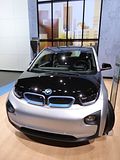
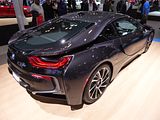
BUGATTI
This Veyron as one of a number of super- and hypercars that was in a special display, and was a real crowd-puller.
BUICK
Star of the Buick stand was the rather stylish Avista Concept which had first been seen at Detroit earlier in the year. This car was apparently “Buick rekindling its historic performance roots” with a new sports coupe, a sector in which there has not been a Buick for some time, since the cancellation of the last Riviera model. The 2+2 coupe gets its mojo from a new 400-horsepower twin-turbocharged V6 driving the rear wheels through an eight-speed automatic transmission, while also featuring start-stop and cylinder deactivation technology, and GM’s Magnetic Ride Control for the suspension. Buick doesn’t specifically say it, but given that the study has the same exact wheelbase length as the new generation Chevrolet Camaro at 110.7 inches (2,812mm), we’re willing to bet that the two cars share the same Alpha underpinnings, sourced from the Cadillac ATS, which would make a production version all the more plausible. For the time being, Buick sees the Avista as a concept that “pushes the brand’s contemporary design ethos and rekindles its historic performance roots”. It’s a more restrained yet elegant take on the sports coupe theme, with a hunkered down stance on the outside, and a high-tech interior with widescreen display that covers two-thirds of the otherwise, minimalist dashboard, and a center console that incorporates touchscreen controls and extends to the rear seating area. “There is elegant simplicity in the Avista’s surfaces, which speak to the purity of the car’s performance, and a timeless beauty that’s a hallmark of Buick design,” said Bryan Nesbitt, executive director Global Buick Design. “It was designed to capture the spirit of the perfect drive.”
A production Buick making its debut here was the 2017 model year Encore subcompact, sporting a much more mature and refined design. But don’t think for a second the company replaced the automobile altogether, as it’s only a facelifted variant, mirroring the design of its German counterpart; the Opel Mokka. Albeit few, the Encore comes with some of its own visual style cues, managing to integrate itself in Buick’s current line-up and design language. On the mechanical front, the Encore draws power from the same 138hp and 148 lb-ft 1.4-litre turbocharged petrol engine, which the 2016 Encore Sport Touring Edition’s more powerful 1.4 litre Turbo that delivers 153hp and 177 lb-ft being offered as an option on the Leather and Premium trims. Start/stop technology is available on most trim levels as well as 10 air bags and StabiliTrak stability enhancement control. The interior design was revamped as well, with the 2017 model coming with a greater emphasis on material selection, as well as an updated instrument panel that flows across the dash incorporating new gauge cluster with a 4.2-inch-diagonal colour driver information centre. The appeal of the cockpit is completed by a new, frameless 8-inch colour touch screen. The Encore was Buick’s best-selling model in North America last year (it’s also sold in Mexico and China), accounting for nearly a third of overall sales.
A model which had first been seen at the Los Angeles Show last November, but which I had not seen before, was the new 2017 LaCrosse. The tri-shield brand tells us that the LaCrosse was “influenced by the dramatic cues” of the Buick Avenir Concept from the 2015 Detroit auto show, which is true to some degree, but the implementation leaves a lot to be desired, as it lacks the dynamic appeal of the study. Unfortunately, Buick doesn’t seem to be interested at this point in creating a true flagship with a production version of the larger and more imposing Avenir. “We have no plans to bring that in,” Buick chief Duncan Aldred said of the Avenir to Autonews. “We’re absolutely delighted with the LaCrosse being the flagship.” Frankly, the front of the LaCrosse gives the impression of a bloated Opel Astra, while the profile with it’s so-called “sweepspear” design that adds a slightly more pronounced shoulder line above the rear wheel seems like a forced attempt at giving the car some character. It’s as if GM had Opel designers turn a Chevy Impala into a Buick rival for Hyundai’s Azera, though, if you ask Buick, you’ll get a very different response. “The new LaCrosse is drop-dead gorgeous and signals the next phase of Buick’s international momentum,” says Aldred. “Its quietness, comfort and connectivity were developed to set new standards in the segment, supported by technologies not offered on competitors such as the Lexus ES.” The interior doesn’t stray too far away from GM’s current design standards, with Buick employing plenty of leather and decorative wood accents throughout. The dashboard is fairly uncluttered with a frameless 8-inch-diagonal colour touchscreen located at the centre console. Moving away from the styling that can be subjective, the 2017 LaCrosse rides on GM’s new global midsize platform that uses lighter high-strength steels to shed 300 pounds (136kg) over its predecessor. New features include a five-link rear suspension, as well as available a HiPer Strut front suspension and an electronically controlled Continuous Damping Control active suspension. It has a similar footprint to the outgoing model, as it’s only 0.6 inches longer, 0.4 inches wider and 1.6 inches taller, but Buick has shortened both overhangs, pushing the wheels closer to the bumpers. While Buick was expected to add at least one turbocharged unit, the new LaCrosse will be offered exclusively with a 3.6-litre V6 at launch. It belongs to GM’s second generation of DOHC V6 engine family and incorporates Active Fuel Management (cylinder deactivation) and Stop/Start technology, producing 305hp and 268 lb-ft of torque. It’s paired to a new eight-speed automatic transmission that drives the front or optionally, all four wheels via Buick’s first twin-clutch AWD system. Sales start later in 2016.
Established models include the Verano, which shares more under the skin with the outgoing Astra than might be obvious from its external appearance, and the Cascada and Regal which look very familiar to European eyes, as they have undergone only limited modifications in the process of federalising them.
One of the surprises at Detroit, earlier in the year, was the addition of a mid-sized SUV to the Buick range, which had no equivalents with the other GM marque’s branding on it. That is because this is not a US-created product, but a Chinese one, where Buick is something of a success story. The logic for bringing it to America is that this could just be the right car at the right time for Buick, as their sedan sales are down but dealers can’t get enough of the crossovers. The Envision is really the right size for what people consider a luxury crossover to be. While it looks small externally, the interior is extremely spacious. Seating is upright and there’s lots of rear legroom, with a seat that slides for more cargo space – although there’s plenty of that in the first place. There are flaws, however, but none that could be blamed on the Buick’s built-in-China status. The Envision doesn’t feel particularly upscale inside. Plastics are of a good quality, but nothing significantly better than what Chevrolet is putting into their new sedans. It’s also not quite up to what you’d find in an Audi Q5 or Volvo XC60. This may matter more when we find out how much it’s going to cost, because the Envision would win an opulence race against a Ford Escape Titanium or Honda CR-V, for example. Nevertheless, it’s all put together well enough. And then there’s the look of the whole thing. It’s not unattractive, but the Envision seems to lack anything particularly distinctive or detailed. The styling may be too conservative on the outside. And inside, the clearly fake wood and purple accents on one example were a bit much. Other than its point of origin, the Envision doesn’t really breaks new ground, but because it’s the right size and will probably be priced in a sweet spot, those in the market for a plush two-row crossover will find a lot to like in the Envision. So much, in fact, they probably won’t care about its birthplace.
Buick announced the new Sport Touring Edition for the 2017 Enclave SUV. As with the rest of the Touring editions, the new addition brings a Satin Black Ice front grille with matching 20in wheels to the 2017 Enclave. Buick says that their mid-size SUV has the brand’s most loyal customers, with 33.4 per cent of the Enclave’s buyers in 2015 to have come out of other Buick models. Available in three exterior colors, White Frost Tricoat, Crimson Red Metallic and Ebony Twilight Metallic, the new Buick Enclave Sport Touring comes with heated steering wheel, heated seats, Ice-blue LED ambient lighting around the instrument panel, 4G LTE connectivity and tri-zone climate control among others on top of the Leather and Premium trims. Buick will present the new Enclave Sport Touring Edition at the 2016 New York Auto Show, with sales starting this summer.
CADILLAC
The new XT5 is Cadillac’s roomier, slimmer and some say, better looking, replacement to the aging SRX, the firm’s best-selling car, which made its debut at the Los Angeles Show last November. Fitted with Cadillac’s new XT designation for ‘Crossover Touring’ models with the number signifying the car’s size and placement in the range, the XT5 is built on a brand new and lighter architecture tipping the scales at 3,999 lbs (1,814 kg) for the FWD model and 4,277 lbs (1,940 kg) for the AWD version. GM says that the new XT5 is 278 pounds (126 kg) lighter than the current SRX, adding that it’s 100 pounds (45 kg) lighter than the Audi Q5, even though it’s seven inches longer, and more than 650 pounds (295 kg) lighter than the similarly-sized Mercedes-Benz GLE-Class. It achieves these weight savings while maintaining an almost identical footprint to the SRX at 189.5 inches (4815 mm) long, 75.0 inches (1,903 mm) wide and 66.0 inches (1,675 tall), with all numbers being within an inch from Cadillac’s outgoing crossover. However, the XT5 rides on a 2.0-inch longer wheelbase at 112.5 inches, which helps improve rear-seat legroom by 3.2 in. compared to the SRX. In North America, the XT5 will be offered once again with a 3.6-litre V6, but this is the newer version used in the ATS and CTS models delivering 310hp and 270 lb-ft of torque, paired to a standard 8-speed automatic transmission with an auto start/stop instead of the SRX’s 6-speed unit. Front wheel drive comes as standard with a new “twin clutch” all-wheel drive system offered as an option. Cadillac said the Chinese market version of the XT5 will be available with a 2.0-litre turbocharged four-cylinder, which will not be offered in the USA or Canada. The mid-size Cadillac features a MacPherson Strut suspension in the front and a five-link independent design at the rear, with standard 18-inch wheels, or optionally, 20-inch wheels, in which case, you also get a Continuous Damping Control system. On the outside, the new XT5 looks like a more contemporary take on the SRX theme mixing softer edges with the brand’s latest signature styling elements such as the new grille and tear-drop headlamps. Cadillac was bolder with the crossover’s interior that gains a simpler (and probably, more ergonomic) central console that does away with most of the clutter found in the previous model, while adding a better looking instrument panel and fresh suit of tech features such as a rear camera mirror, Apple Carplay & Android auto compatibility, and a new CUE infotainment system. “Our focus for the interior was sophistication and simplicity, ensuring an economy of lines to reduce visual noise and clutter,” said Andrew Smith, Cadillac executive director of global design. “A feeling of space is the ultimate luxury, so we sought to emphasise that. We also use a greater variety of authentic materials and palette of colours to deliver expressive interiors in all trim levels.” Production of the new XT5 will begin in the USA and China in the spring of 2016, with pricing to be announced.
A new Black Chrome package can now be optioned for customers looking into Cadillac’s 2016 ATS Coupe and Sedan and CTS Sedan models. As the name suggests, the new optional package replaces the bright chromework on the body with a darker one, adding gloss black side window mouldings and ‘After Midnight’ grey paint finish for the wheels. The Black Chrome Package is only available for the ATS Coupe and Sedan models with the 275hp 2.0T and 333hp 3.6 V6 Luxury and Performance Collection trim levels, either with RWD or AWD. Customers will be able to choose the new option only in conjunction with the Black Raven, Phantom Grey Metallic, Red Obsession Tintcoat and Chrystal White Tricoat colours. If you want your CTS with the Black Chrome pack, the same engine/powertrain restrictions apply, with Cadillac only letting you decide between three paint options: Black Raven, Phantom Grey Metallic and Chrystal White Tricoat. Cadillac asks for extra $595 for the ATS Coupe, $795 for the ATS Sedan and up to $1295 in the case of the CTS Black Chrome.
There were plenty of the more established Cadillac models here, too. The potent ATS-V Sedan and Coupe were joined by the regular models.
Also here were the large front wheel drive XTS saloon and the gargantuan Escalade.
CHEVROLET
There’s a lot of new models coming from Chevrolet at present, and two of them sat on a large display plinth at the back of the stand. The production version of the Bolt EV is the one which has not been seen before this year. GM’s answer to the BMW i3, it was launched at Detroit, in advance of going on sale later this year. A version, to be called Ampera E will be sold in Europe, but not the UK, in due course. The Bolt is the production version of the study shown last year, and it will be priced from $30,000, after the $7,500 federal tax credit. What impresses – especially compared to the BMW, is the compact EV’s range, which stands at more than 200 miles (322km). It makes use of a lot of lightweight materials like carbon fibre, magnesium, aluminium and woven mesh to keep its curb weight down. This could be the car that convinces a whole load more people to go EV.
Joining it on the turntable, and with several examples on show elsewhere was the 2017 Malibu, Chevrolet’s latest competitor in the all-important full-sized family sedan, as a rival to the Toyota Camry, Hyundai Sonata, Ford Fusion and a raft of other rivals. The previous Malibu had a short life, perhaps shorter than Chevrolet originally envisaged, as there was widespread criticism of insufficient space in the cabin, something which an early facelift could only address with reshaped seats, which was hardly a full solution to the flaw. The new car looks very similar to the highly praised Impala, though it is of course smaller, and it has the latest GM 4 cylinder engines available under the bonnet, with a 1.5 litre Turbo the mainstay of those offered.
The second generation Spark has been on sale for a little while now, not that you would notice, as you rarely see them on the road. When the equivalent model was offered in Europe, it was positioned as an economy city car but Chevrolet tried to position the US model as a sporty and trendy device, something which it really was not. They seem to have been rather quieter about this one.
Chevrolet’s Sonic subcompact hatch and sedan will enter the 2017 model year with a facelift that brings freshened up looks and new tech features. On both body styles, out goes the quirky front end design with the round headlamps, and in comes a softer and more generic styling that echoes the global Chevrolet cues seen on vehicles ranging from the Cruze and Trax all the way up to the Impala. Beyond the redesigned bonnet and front bumper, the new headlamps can now incorporate available LED daytime running lamps. Similarly, the round lighting units at the back have been replaced with rectangular-shaped inner fixtures, with Chevrolet also re-profiling the rear bumper. Four new exterior colours have been added to the palette for 2017, called Orange Burst Metallic, Brimstone, Cajun Red Tintcoat and Arctic Blue Metallic. The interior has been updated, too, with a new, detailed gauge cluster incorporating an analog speedometer, and new comfort and convenience features that include a power driver’s seat, Keyless Open and Start, heated cloth seats and new heated steering wheel. There’s also a new 7-inch infotainment system supporting the latest connectivity technologies, including Apple CarPlay and Android Auto compatibility and 4G LTE with Wi-Fi hotspot. Power will come from a standard 1.8-litre four-cylinder unit, and an available 138hp 1.4-litre turbocharged four offered with either six-speed automatic or manual transmissions. The 2017 Sonic will reach North American showrooms this fall in LS, LT and Premier trims with an available RS package on sedan models, while the hatchback returns exclusively in RS guise, offered in LT and Premier trims.
After its official debut at the 2016 Detroit Motor Show earlier this year, the 5-door version of the all-new Chevrolet Cruze has made its way to New York City. The lights do shine really bright in the city that never sleeps, and the Cruze hatchback certainly deserves some attention, especially after GM North America president Alan Batey said that this is the perfect time for Chevy to bring this car to the States. According to Batey, there was a 9% market growth in small hatchbacks during 2015, though at the same time, the best selling compact car in the US last year was the 4-door Toyota Corolla. Still, Chevrolet say that the Cruze is the segment’s second-best selling model to people under 25 and the sporty hatchback version should definitely appeal to that type of demographic. Besides, it should still be sufficiently practical since it’s got no fewer than 18.5 cu ft of cargo space in the back, or 42 cu ft if you fold the rear seats. The 2017 Chevrolet Cruze hatchback will be offered in LT and Premier trims, though only the latter was present at the NY Auto Show, as it’s the better equipped version. Customers will also be able to opt for the RS package if they feel the need for an even more aggressive-looking car – slightly different front & rear fascias, rocker panels, rear spoiler, fog lamps and 18″ wheels. The established Cruze Sedan was also on show.
Fresh from a debut at the Chicago Show a few weeks earlier, was the 2017 Trax, which borrows styling elements from the Cruze, Malibu and Volt, to give is a more modern look. The car’s new components are easy to spot, particularly the reshaped headlights, a number of chrome touches and the dual port front grille. Individual fog lights are also found up front within a matte black plastic housing, mimicking the look of the wheel arches and black side skirts. In the cabin, the refreshed Trax includes a 7-inch MyLink colour touchscreen, redesigned gauge cluster with a digital centre display and a selection of Galvano chrome touches. While the interior and exterior tweaks are noticeable, an improved selection of active safety features really set the new car apart from the outgoing model. Such new technologies include Forward Collision Alert, Rear Cross Traffic Alert, Side Blind Zone Alert and a Lane Departure Warning. Ten airbags also come standard, as does a rearview camera. Power for the 2017 Trax continues to come from a 138 hp (140 PS) and 148 lb-ft (200 Nm), 1.4-litre turbo’d four-cylinder.
There are no changes to the well-received Impala, Chevrolet’s large sedan, and there was one of these on display.
Believe it or not, the Camaro turns 50 this year, and to celebrate its birthday, Chevy will manufacture a very special, limited edition of the model. Aptly called the 50th Anniversary Edition, it will be available in both Coupe and Convertible 2LT and 2SS (V6 and V8, respectively) models, and it will include a bucket-load of goods. Available only in the Nightfall Gray Metallic exterior hue, the Camaro special sits on 20-inch 50th anniversary wheels, while the special stripe package and “fifty” exterior badges will attest its pedigree and heritage. Other visual add-ons include a unique grille with satin chrome accents, body colored front splitter and orange brake calipers. The 2LT variant benefits from the RS Appearance package, as well. The interior hasn’t escaped Chevy’s touch, as the 50th Anniversary edition will welcome you into a cabin garnished with suede inserts and orange accent stitching, as well as distinct (and unique) treatments on instrument panels, seatbacks, steering wheel and illuminated sill plates. The regular productionmodels were also on show.
Also on show was the new 2017 ZL1 car, a key reminder that whilst the Camaro started out as a “pony car” and as well as being seen as a “muscle car”, the top models are now very much “super-car”. The 2017 Camaro ZL1’s aggressive, sharp lines aren’t there for show, as it signals the monster that dwells under the bonnet. Taken from the Z06 Corvette, the 6.2-litre supercharged LT4 V8 engine makes sure this Camaro is taken seriously, developing a mind-boggling 640hp and 640 lb-ft of torque (868 Nm). That’s more than a Lamborghini Huracan, mind you. With a 60hp and 84 lb-ft leap over the previous Camaro ZL1’s 580hp 6.2-litre supercharged LSA powerplant, the new model should be faster than the old one that hit 60mph from standstill in in 4.0 seconds for the manual and 3.9 seconds for the automatic version, reaching speeds of up to 184 mph. A standard, six-speed manual transmission with active rev-matching, as well as a brand-new 10-speed automatic with paddle shifters are responsible for getting the power to the 20-inch rear wheels, wrapped in 305/30ZR20 Goodyear tyres. The car also gets a suite of performance tech to help it perform, including an updated Magnetic Ride suspension, Performance Traction Management, electronic limited-slip differential, Custom Launch Control and Driver Mode Selector.
The Camaro’s sporting brother in the Chevrolet range is the pricier Corvette, and that was well represented here, too. You always get crowds of people around any Corvette at any US Show I’ve ever been to, and this one was no exception.
In complete contrast were this pair of crossover vehicles, the Equinox and the now rather venerable Traverse.
The second generation Volt represented quite an evolution over the ground-breaking first car, and I’ve started to notice them out on the road now. There was one here to inspect in detail.
Chevrolet had a huge stand in the downstairs hall, which contained examples of the commercial and utilitarian vehicles from the range.
Aiming for customers in the heart of the midsize pickup truck market, GM pulled the wraps off the 2017 Colorado Shoreline, a model joining a rich portfolio of special edition Chevy trucks. According to Chevrolet, California is by far the largest midsize pickup market, as more midsize trucks are being sold in Los Angeles than the next two largest markets combined. With this specific demographic in mind, the Shoreline package will be offered on Colorado LT extended cab models, with either two-wheel drive or four-wheel drive. The Colorado’s “Californication” is evident by the bright exterior colours (Silver Ice Metallic, Summit White, Laser Blue, Red Hot) with blacked-out trim and minimal chrome accents. There’s also a body-colour front grille, black 18″ wheels and black trim for the door handles, mirrors and beltline. Shoreline customers will also get to enjoy popular features such as the spray-in bedliner, all-weather floor liners and one-year of Sirius XM radio subscription. “The new Colorado ignited the midsize pickup market, accounting for 74 percent of the growth in the segment in 2015,” said Chevy truck marketing exec Sandor Piszar. “This year we are continuing that momentum with the Shoreline edition designed specifically for customers in the segment’s biggest market.” Piszar went on to add that the Shoreline “is a great example of our strategy to offer unique trucks designed for very specific customers. These trucks have clearly resonated with customers, as last year our special edition trucks sold in one-third of the time, and to younger, more affluent buyers than the industry average.”
There were plenty of examples of the larger Silverado here, too. This is Chevrolet’s best-selling vehicle, and the model which is only outsold by the Ford F150.
CHRYSLER
One of the few truly new cars at the Detroit Show was the Chrysler Pacifica, the much rumoured next generation MiniVan from the company that arguably invented the genre back in 1984. In recent years, there has been a massive shift away from this type of vehicle to the Cross-over, but having seen this new model, then if anything can convince Americans that MiniVans so still have a future, this is the product to do it. While the Chrysler Town & Country had a loyal following, Chrysler thought it was necessary to start from scratch. Unlike another founding member of the people mover class, the Renault Espace, the Pacifica is unashamedly a MiniVan and hasn’t taken a turn down the crossover route. Power sliding doors, a floor that’s flat when all of the seats are folded away, a place for every cup or gadget – this is what MiniVans are about and Chrysler gets it. The Pacifica is practicality first. Still, it’s hard not to be attracted to the exterior in some way. The detailing is impressive inside and out. It may be too chromed and swoopy for some people, but at least there was effort made here. And it doesn’t look like any MiniVan on sale today, even if it does have some allusions to the Espace. You have to respect the Pacifica for exploring new heights of luxury convenience features. The sliding doors open with the wave of your foot. The second-row seats collapse and hide away with one motion. Underpinning the all-new Pacifica is a bespoke platform which the automaker promises delivers both a class-leading ride, improved handling and lowered noise, vibration and harshness levels. The new platform found beneath the sleek skin of the Pacifica is reported to be the lightest and stiffest in its class and all told, the car is more than 300 pounds lighter than the outgoing Town & Country weighing in at 4,330 pounds in base spec. In terms of proportions, the Pacifica is slightly shorter than the Town & Country but is an inch wider and about half an inch taller. Visually, the new dimensions and radically-overhauled body panels ensure the car looks nothing like its predecessor. There are clear similarities to the Chrysler 200 sedan with curvaceous headlights, an eye-catching grille with a chrome surround and a set of 17-inch wheels as standard. Beauty is of course in the eye of the beholder so we’ll leave it up to you as to whether or not the new design is a success. Whatever your thoughts, it’s certainly more in touch with existing Chrysler products than the current Town & Country. In terms of powertrains, just two are offered. The first model is powered solely by Fiat Chrysler Automobiles 3.6-litre V6 delivering a total of 287 hp and 262 lb-ft, joined with a nine-speed automatic transmission. Power from that engine is sent directly to the front wheels and soon after the Pacifica reaches the market, a stop-start feature will be added. The second powertrain available is a hybrid. It utilises the same Pentastar V6, albeit detuned to 248 hp and 230 lb-ft, as well as a 16 kWh battery pack. That battery can be charged in two hours and makes the Pacifica the first car in its segment available as a hybrid, and with its 30 mile electric-only range, this could be exactly what most parents will need shuttling to and from the elementary school. It’s not like the rest of the segment is sitting still, though. The Kia Sedona went on sale last year and there’s a new Honda Odyssey due later in 2016. But Chrysler is staking its claim on the MiniVan market with the Pacifica. They know it’s their bread-and-butter vehicle and realised they needed a new recipe.
Chrysler surprised more than a few people when they announced that the 200, the mid-sized sedan entry that is finally a class-competitive car would cease production at the end of the 2016 model year, just two years after it went on sale. Falling demand for cars of this type and a need for more capacity to build Jeeps was the official rationale offered. That means that this could well be the last major US Show were the model features. It certainly did not have a particularly prominent billing on the stand.
Chrysler decided to give its 300S sedan another dose of energetic styling through the new Exterior and Interior Sport Appearance Packages. The kit was conceived to further emphasise the vehicle’s main character traits, offering a more prominent “commanding presence” – according to Chrysler. With a subtly, yet aggressively tweaked front fascia – sporting large air intakes and integrated LED fog lamps – the package comes standard with the 300S V8 model and can be commissioned on the V6-powered variant as well. Below the Gloss-Black headlamps and dimensional grille you can find what Chrysler likes to describe as “a larger body-color painted Mobius strip”, which, of course, gives the car a new road presence; a trait also underlined by the new Ceramic Gray exterior paint, and the 20-inch (19-inch with AWD) rims. “The new 2017 Chrysler 300S re-excites the passion of what owning an American flagship sedan is about. And now for our Chrysler enthusiasts, two all-new sport appearance packages that take the 300S model’s athletic styling and appointments to the next level,” said Tim Kuniskis, Head of Passenger Car Brands – Dodge, SRT, Chrysler and FIAT, FCA – North America. Step into the cabin and you’re greeted by the model’s sport-contoured seats with new premium perforated leather and more lateral support for, ahem, spirited driving. The cockpit is bedizened with Piano Black interior trim appointments on the instrument panel, door panel and instrument cluster bezels, and Light Gray Diesel coloured accent stitching. Speaking of spirited driving, the models come with a “Sport Mode”, which reduces shift times (from approximately 400 milliseconds to 250 milliseconds), sharpens the engine and throttle responsiveness and firms up the steering in the 363 horsepower 5.7-litre HEMI V-8 engine. The 3.6-litre Pentastar V6 engine got some attention too, with Chrysler bumping the power up to 300 horsepower and 264 lb-ft of torque, plus adds a unique sport-tuned dual exhaust system with a more distinctive sound. The variant will be made available at Chrysler dealerships for ordering in August.
DODGE
Most exciting product on the Dodge stand, which merged seamlessly into the Chrysler area was the SRT10, the third and what we now know will be the last generation of the hairy-chested sports car that debuted as the Viper back in 1993.
Another car on death row is the compact-sized Dart. its good looks and decent quality finish inside have not been enough to get people to buy it in anything like the quantities that were envisaged, the model selling little better than the vastly inferior Caliber that it replaced. Production has now officially ended, but there are still examples for sale, which I guess is why there was one on show.
For those old enough to remember the Charger and Challenger cars of 45 years ago, there was a chance to take a trip down memory lane with the new Go Mango Challenger and Charger models. For those aching for Mopar’s “good ol’ days”, the American car manufacturer has prepared a surprise consisting of a new paint addition to the Charger and Challenger model line-up. Initially, Dodge announced that it will only make the colour available for SRT 392 and SRT Hellcat models, but in the meantime the parent company decided to offer the option on “lesser” models as well – no need to stay exclusive if the demand is pretty high, right? We’ve seen a tremendous response from our customers after we announced the return of Go Mango at the 11th annual Spring Festival in California. In fact, nearly half of all SRT and Hellcat orders are for Go Mango,” said Tim Kuniskis, Head of Passenger Car Brands – Dodge, SRT, Chrysler and FIAT, FCA – North America. This intriguing hue was first introduced as an option, in the 1970 Dodge Challenger, and offered again (albeit in limited numbers) on some Charger R/T Daytona and Dart models in 2006 and 2016, respectively. Dodge adds the new colour to its list of revived heritage paint schemes, which includes the “Plum Crazy” purple, “B5 Blue” and “Sublime” green. There were several examples of the Charger and Challenger here.
Completing the display were both of Dodge’s Crossover vehicles, the Journey and the larger Durango. Both have been available in their current form for some time now, although there has been a steady program of improvements to them over the years. The Durango remains quite appealing, but the Journey struggles as it is relatively small for its class, and it lacks many of the technology features of more modern rivals, though it is relatively cheap to buy.
FIAT and ABARTH
The US Fiat range has grown steadily since its relaunch in 2010. The initial offerings were the 500 and 500C, both of which changed little in the last 5 years, and these have been joined by the 500L and 500X. Neither has found the same appeal as the 500, though.
Joining these cars now is the 124 Spider, which was to be seen here in Fiat guise as well as the Abarth model already depicted. Unveiled at the Los Angeles Auto Show, the new Fiat 124 Spider is constructed on the same base as Mazda’s perfectly-balanced drop-top, the MX-5. Mind you, the Fiat’s bodywork has been redesigned, with its silhouette bearing a subtle reminder of its origins. Opinions will vary, and debate will rage for a long time as to which is the “better” looking, but many may conclude that the Fiat 124 may very well be a tad better than the MX-5, thanks to its 500 Abarth-sourced, 160 hp turbocharged 1.4-litre mill, which could make a good base for a more potent version. But until then, we’re left with a retro-inspired machine that’s somehow the opposite of Mazda’s offering. Unlike the MX-5, which is a very sharp-looking, poised, naturally-aspirated machine, Fiat’s own take on the matter is much more classical. In fact, the 124 will be available in two different rim levels – called Classica and Lusso – which kind of underlines the Italian car manufacturer’s need to make the automobile a little more softer, glamorous and fashionable, with a torquier power band in the lower revs, rather than a hard-pushing approach to get the power out.
FORD
No question as to the star of the Ford stand: the GT supercar. Joining the rest of the Ford’s performance lineup, which currently includes the Fiesta ST, Focus ST, Focus RS, Shelby GT350R and F-150 Raptor, the GT that will be built by Multimatic Inc in Ontario, Canada, will be the crown jewel of the series. For its motivation, Ford developed a new 3.5-litre EcoBoost V6 that’s set to produce in excess of 600 horsepower, with a dual-clutch automatic transmission sending power to the rear wheels, allowing for a zero to sixty sprint in under 3 seconds. Active aerodynamics will help the GT make the most of its potential. When it finally arrives in the market, the Ford GT will reportedly be priced similar to the Lamborghini Aventador, which starts from around $400,000. Annual production will be capped to just 250 units and the final number will not exceed that of its predecessor, which was assembled in less than 4,000 examples.
The GT will be beyond the means of most buyers, so perhaps the most commercially significant new model on Ford’s vast stand was the revised Fusion, of which a number of examples were displayed. Familiar to Europeans as the Mondeo, it may seem rather early to be facelifting the car, as it only went on sale in Europe a a few months ago, but this American buyers have been able to buy a Fusion in its current guise since 2013, so it is time for the mid-cycle update, especially as it is a highly competitive class in which it competes, against the likes of the Camry, Accord and Altima, with models such as the Malibu, Optima, Chrysler 200 and VW Passat surfing in its wake. The changes can be summarised as the availability of more power, a SYNC 3 infotainment system with voice recognition and a few subtle exterior changes. To start off, a 325 HP 2.7-liter EcoBoost V6 engine sounds a lot better than what the Mondeo currently has going for it in Europe, which is the 240 PS 2.0T EcoBoost unit and the 2.0 Duratorq TDCi engine, good for 210 PS. While Ford has yet to confirm that their top of the range Fusion Sport will ultimately morph into a Mondeo ST, all we can do for now is hope. In the looks department, it’s the rear of the car that took most of the “beating”, but in a good way. The horizontal insert makes the Fusion look more aggressive by having the new taillights split down the middle like that, and the wing has always helped visually. Other than that, the grille is slightly larger, the bumper slightly different, plus there are LED daytime running lights and upgraded materials inside.
There was a revised Escape, too, which received similar changes, which were first shown at the Los Angeles Show. From a visual perspective, the redesigned front end gives it a very imposing mini-Explorer vibe which future customers might genuinely appreciate even after talking themselves into purchasing the car – which happened very often in the last few months, with the model becoming Ford US’ best-selling vehicle after the F150 truck. In fact, the Escape has been 2015’s second best-selling non premium compact SUV in the United States, trailing only the Honda CR-V. And keep in mind, that’s a very competitive segment we’re talking about, considering how the Toyota RAV4, Nissan Rogue, Jeep Cherokee and more than a dozen other models are constantly locked in battle, both in terms of sales as well as in terms of image. Speaking of which, it’s not that the Ford Escape didn’t have a good image, it’s just that it really needed to offer its owners better safety features. Driver-assist systems such as Blind Spot Information, cross-traffic alert, auto high-beam control, adaptive cruise control, forward collision warning with brake support and lane-keep assist are just some of the 2017 Escape’s party tricks. The interior also needed to be addressed and so Ford went and changed the steering wheel, redesigned the center stack and installed an electronic handbrake instead of that plain-looking mechanical one that just took up space. Under the bonnet there are two new EcoBoost power units, rated at 183 PS (1.5-litre) and 249 PS (2.0-litre) respectively. While the smaller of the two won’t get you to 100 km/h (62 mph) faster than 10.1 seconds, the 2.0-litre twin-scroll EcoBoost engine should more than suffice since it’s already proven to be a solid performer in the Ford Edge. Expect many of these alterations to filter through to the European Kuga in due course.
There were a couple of examples of the Fiesta here, neither of them in quite the forms that are available in Europe. The ST is only sold as a 5 door in America, and the range also includes a slightly oddly proportioned Sedan version.
There were several examples of the Focus here. This is sold in 5 door hatch and 4 door sedan guises in the US market, with a subset of the same engines as are offered to European buyers.
There was high expectation for the Focus RS, especially since the previous models have been denied to American buyers, but the press reaction to it when it arrived was far more muted than has been the case in Europe, and the car has only sold in small volumes.
The C-Max is only available in America as a Hybrid or in the full-electric Energi version which was to be seen here. Not surprisingly, this is also a low volume product.
The Edge is probably the opposite to the Focus RS in that it received some fairly luke-warm reviews when it arrived in Europe, whereas Americans rate it more highly. Further proof as to how difficult it is to offer a common product set around the world.
Not actually shown on the Ford stand itself, but in a separate display, where it was firmly anchored to a wall was the evidence that half a century after the legendary rent-a-racer 1966 Shelby GT350-H, Ford, Hertz and Shelby are joining forces again to celebrate the anniversary with a special edition based on the 2016 Mustang GT named the Shelby GT-H. This is actually the third time that the three partners have come together to create a special rental car following the Shelby GT-H a decade ago. Only 140 units of the souped-up Shelby GT-H will be made, all of which can be rented exclusively through Hertz’s Adrenaline Collection at select airport locations. Built at Shelby American’s Las Vegas assembly facility using a 2016 Ford Mustang GT with the stock 435hp 5.0L V8 as the base, all Hertz specials wear a black exterior paint, set off with dual gold “Le Mans” racing stripes along with rocker stripes with the “Shelby GT-H” nomenclature. Each car gets a Hertz Edition emblem on the front fenders, a custom hood, carbon fibre splitter and rear spoiler, Hertz Shelby GT-H sill plates and a numbered dash plaque. To spice things up, the GT-H gains a throatier sports exhaust and the Racing Handling Pack that includes special-tuned dampers, lowering springs, sway bars and a staggered wheel kit consisting of 19-inch alloys shod in high performance Michelin rubber. You’ll be able to rent the Shelby GT-H from Hertz beginning Memorial Day weekend and I look forward to getting the chance to try one.
On Ford’s own stand, there were a number of examples of Mustang models you can buy including the very potent GT500.
Downstairs there was an extensive display of Ford vehicles. The Crossover and SUV models that had been seen upstairs were also here: Flex, Explorer, a whole load more revised Escapes and the Edge.
There were plenty of examples of the F150, of course, the best-selling vehicle in America for as long as anyone can remember.
Joining it were the smaller trucks from the range: the Transit and Transit Connect.
GMC
As GMC’s range comprises Pick Up trucks and SUVs of various sizes, it seemed appropriate that their stand was in the downstairs hall. Star of the stand was an all-new Acadia. Very unusually, it is notably smaller than the model that it replaces – though that one will continue in production for some while as well, we are told. The 2017 Acadia is smaller than the outgoing model in every dimension – by 7.2 inches in length, 3.5 inches in width and 3.9 inches in height – and as such it is no longer available with eight seats, but will be offered in five, six or seven passenger configurations. The upshot of the vehicle’s reduced size and its additional use of lightweight steels in its construction means it weighs 700 pounds less than the current car. Impressively, GMC has managed to actually increase cargo capacity from 70 cubic feet to 79 cubic feet despite the reduced size. Engine wise, base Acadia models utilise a 2.5-litre four-cylinder engine that records 22 miles per gallon city and 28 mpg during highway driving. For customers looking for some more oomph, a 3.6-litre V6 delivering 310 hp and available with an all-wheel drive system is offered. The automaker hasn’t announced when the first units will hit U.S. streets but it is likely to be the in the middle of the year.
If the Acadia is not big enough, then you need a Yukon, available in standard and XL sizes. This is GMC’s version of the Chevrolet Tahoe and Suburban, and apart from badging and a few trim details is all but identical.
Oldest product in the range is the Terrain. A new edition made its debut here, in an effort to add some more interest until an all-new version appears. This is the stylised 2017 Terrain Nightfall edition which adds blacked-out exterior details and wheels, and well, that’s about it. If the trim name sounds familiar, that’s because GMC used it on the Canyon pickup truck last year. While the most fitting exterior colour for the Terrain Nightfall Edition is Onyx Black, GMC offers three more choices, named Summit White, Graphite Gray Metallic and Crimson Red Metallic. All come with the same black styling cues, including 18-inch wheels with gloss black spokes, a charcoal grill with a gloss black surround and accents, gloss black front and rear fascia accents, gloss black rear license plate surround trim, gloss black outside mirrors and black luggage rails. The Nightfall Edition is available on the Terrain SLE-2 and SLT models, with pricing to be announced closer to its on sale date in the third quarter of the year.
GMC’s trucks are called Canyon and Sierra, and are very similar to their Chevrolet equivalents, the Canyon and Silverado.
HONDA
Unlike Europe, where sales have fallen massively, in recent times, Honda has been doing well in the US. The cars have a different image, too, and nowhere is that more the case than at the bottom of the range, where the model we know in Europe as the Jazz, but which is called the Fit in America, which is popular among the older buyers is seen by Americans as a “cool” car for youngsters.
It is widely report that the upcoming Civic Hatchback won’t look that much different from the concept first unveiled at Geneva and now on show here. Certainly this boldly styled prototype looked production ready. Whether you like the striking new look will come down to personal taste. I don’t – I think it looks awkward and over fussy from every angle, but there are those who disagree with me . As well as the striking design, Honda promise a sporty, European-inspired driving experience – to do this, Honda will mate the all-new 1.5-litre turbo engine to its 6-speed manual transmission for a sportier dynamic performance (or an optional CVT). “Offered with the first application of the 1.5-litre turbo engine paired with a manual transmission, this sportiest Civic to date will attract a whole new set of enthusiast buyers to the model and Honda brand”, said Jeff Conrad, senior vice president and general manager of the Honda Division of American Honda Motor Co., Inc. The 2017 Civic Hatchback will be launched later this year and will be built on the same platform as the 10th-gen Civic Sedan and Coupe. More importantly, Honda says the 10th generation Civic line-up will be rounded by the arrival of the Si and radical Type R variants. Styling-wise, the hatch features a long wheelbase and short overhangs, and although the big rims won’t make it into production, almost everything else will. The sleek and swept-back body lines, the front fascia governed by the big air intakes and the distinctive C-shaped rear lights. The production variant will be exclusively manufactured at Honda’s UK manufacturing plant in Swindon.
The tenth generation Civic saloon, which looks very similar to that Hatch concept, has been on sale for a few months now. It’;s going to take longer than that to accept its looks, which to my eyes go from the rather bland previous car to one which is clearly trying far too hard, with awkward addenda where they are not needed making it look like every detail that anyone conceived was added to the finished product. It is, by all accounts, a very good car to drive, and thanks to being the largest car in its class, also particularly roomy. Take a look and draw your own conclusions.
There’s a Coupe version as well, just about the sole entry in a sector which was once replete with style-focused versions of volume selling-sedans. Premiered at the LA Show in November, the two-door model essentially carries the same front end design as the sedan, but differs from the A-pillars back, featuring a further lowered roofline (-1 inch) and rear side windows that taper inward to give the rear wings a more muscular look. Inside, the differences have more to do with rear passenger space, as the shape of the car reduces headroom, than the styling which is virtually unchanged. Nevertheless, thanks to a longer wheelbase (+2.9 inches) and wider body (+1.9 inches), interior space grows by 8.4 cubic feet and rear seat legroom by more than 5 inches, compared to the outgoing Coupe. You’ll find the same pair of engines as the sedan on the coupe including a base 2.0-litre mill producing 158hp and 138 lb-ft, and the new 1.5-lirtr turbo churning out 174hp and 163 lb-ft. Both will eventually offer a choice of CVT and six-speed manual transmissions driving the front wheels.
The CR-V has become ever more significant as buyers move over to this genre from the traditional three box saloon, with sales of the model now generally making it Honda’s best-selling car in the US, and the latest version was on show for people to inspect in detail.
There’s a smaller crossover Honda available these days, the HR-V, and that has yet to find the same level of success. It was never likely to in America, as – versatile as it is -they generally see vehicles of this size as simply being too small!
The Accord, until recently, Honda’s biggest seller, received an update for 2016, with styling changes which you could say either added more character, or more bling- to what had previously been a rather inoffensive design making it easy to recognise from earlier versions. Several were on display.
Displayed in its final US specification, the Clarity FCV will be available in one of the three colours, namely Signature Red, Black or White. It also comes with a multimedia system that features Display audio, Apple CarPlay and Android Auto compatibility, app-based navigation, streaming audio, voice-controlled search capabilities and access to Google- or Apple-approved smartphone apps. The manufacturer has fitted the Honda Sensing onto the FCV, as part of the active safety gizmos, which uses advanced sensor tech to detect potential collision or lane departure, initiating emergency steering and braking to prevent mitigation or vehicle collision. Technologies found here include Collision Mitigation Braking System with emergency braking, Lane Departure Warning, Forward Collision Warning, Lane Keeping Assist, Road Departure Mitigation and Adaptive Cruise Control. Equipped with a fuel stack 33 percent more compact than its predecessor, with a 60 percent increase in power density, the Clarity FCV will go on sale in select California dealers by the end of this year at at around $60,000, with a targeted monthly lease of less than $500.
The Odyssey is widely regarded as one of the very best of the now quite limited range of MiniVans on offer to US buyers. I’ve not driven one for a good few years, but I certainly thought this was the case back in the day when I did, and Honda are nearly two generations on from that 2008 model, continuing to refine and improve the genre. It won’t win prizes for looks, but for versatility and practicality, it scores highly indeed.
Compared to the previous generation model, the new 2017 Ridgeline is not only a more modern car in all aspects, but also a more conventional-looking pickup. What made the old Ridgeline stand out was definitely its boxy design and tall flat-bed. It looked interesting, though according to people who like to add up numbers, it didn’t even come close to having good sales in 2015. Thankfully, it doesn’t need to go against the big boys, such as the F-150, Silverado, Ram, Sierra or the Tundra. What this new Ridgeline should concern itself with is the likes of the 2016 Nissan Frontier, 2016 Chevy Colorado and 2016 Toyota Tacoma, which are still strong competitors, yet it’s hard to choose a clear front-runner. If sales were our decisive factor, the Tacoma would be the truck to beat, otherwise, we’d say the Colorado is looking mighty good thanks to its tech and highly efficient turbo-diesel engine. The 2017 Honda Ridgeline however does have one or two aces up its sleeves. For starters, it’s more refined as it’s based on an SUV. It also may end up having best-in-class acceleration and fuel economy (according to the manufacturer), thanks to its 3.5-litre V6 petrol unit. Second of all, its AWD system can manage the way you drive on different type of terrain by providing you with a couple of very helpful drive modes such as Normal, Sand, Snow and Mud. Then there’s the interior. Not only does it feature strong safety equipment like Collision Mitigation Braking, Lane Departure Warning, Road Departure Mitigation, Forward Collision Warning, and Lane Keeping Assist, but it also looks like a genuinely nice place to be. The materials look good, the dash layout is attractive and the entire cabin looks considerably more high tech then what you see inside, pretty much, all of its rivals. Whether or not that will translate into a very strong sales year, remains to be seen. Some people simply want to get the Chevy, and there’s really no way around that.
Honda also had a stand downstairs, with examples of the most of the SUV and MiniVan models from their range on it, so that meant another chance to look at the Pilot, the Odyssey and the CR-V.
HYUNDAI
The most important vehicle on the Hyundai stand, and indeed one of the most significant concept cars of the whole Show was what was called the New York Concept. Strictly speaking, this is a Genesis and not a Hyundai, the significance of which will become more apparent as Genesis goes from being a model name to a stand-alone brand, as the Korean car maker follows a similar path to Nissan, Honda and Toyota in trying to be considered as a make of truly premium products. This striking luxury sports sedan concept provides some strong hints as to where it is heading with a much-rumoured future entry in the compact luxury car market. What Genesis really wants us to take away from the study is its design language, which will be applied on the G70 that will challenge the BMW 3-Series, Mercedes-Benz C-Class, Audi A4, Jaguar XE and Cadillac CTS, among other entries in the populated segment. The concept is sleek, has powerful shoulders and a confident and aggressive front end, which almost compliments the elegant rear in the same way that Mercedes-Benz managed to do with the AMG GT supercar. Genesis say that this concept is supposed to offer “the unexpected” from a visual perspective and we tend to agree as there aren’t a lot of sports sedans out there right now that look like they would belong in a futuristic Gotham City. Inside, a production-ready car would make do without things like the four individually sculpted single seats or the open steering wheel. But the fact that the Genesis brand is already thinking ahead at future models that might one day turn this futuristic cabin into “the norm”, is an exciting thought. This concept also offers us a glimpse into the next-gen driver interface, which Genesis call the Human Machine Interface (HMI). I’m not sure about the positioning of the large curved 21″ horizontal display, but spec-wise, with 4K resolution and advanced In-plane switching technology, it’s still cool enough for any tech junkie to admire. I look forward to seeing the production G70 model, which is probably a good eighteen months away yet.
There are two Genesis models that you can buy now. The larger of these was premiered at the 2016 Detroit Show, where the separation of Genesis from Hyundai was also formally announced. The G90 replaces the former Hyundai Equus, and like that model, it is conceived with the objective of instantly reminding you of a Mercedes-Benz S-Class type of car, but obviously with a smaller price tag, which is sure to win over lots of potential customers. Right off the bat, the G90 speaks to you through its powerful and refined silhouette, which grabs your attention as soon as you glance over its prominent hood, follow the lines of the car along the wheelbase and finally rest your gaze on the sophisticated rear deck surfacing. It’s no S-Class but as long as the price is right, the value of the car will certainly speak for itself. The G90 is fitted with a choice of two petrol engines – where one is a 3.3-litre twin-turbocharged V6, purring along at 365 HP, and the other one a beastly 420 HP 5.0-litre V8. The latter also has a good 376 lb-ft (509 Nm) of torque, which should help it hit various high speeds with relative ease. If the top of the line G90 is to hit 100 km/h (62 mph) in 5.7 seconds as previously reported, it would mean being around 1 second slower than a Mercedes-Benz S500 (sticking with the S-Class comparison, plus V8). But again, small price to pay as long as the price is smaller. Either powertrain is available with an advanced H-TRAC AWD system, which will of course give drivers more confidence under adverse conditions such as snowy and icy roads, by directing up to 40% of the available torque to the front wheels. 90% of that very same torque can be directed towards the rear axle under the H-TRAC Sport calibration, whereas Economy mode will see 100% of the torque being distributed to the rear for maximum efficiency. In terms of safety, the Genesis G90 is expected to receive a 5-star rating (NHTSA) as well as a Top Safety Pick+ (IIHS), based on nothing but preliminary internal crash tests. The standard safety tech also sounds good, with advanced systems such as Automatic Emergency Braking (AEB) with Pedestrian Detection, Smart Blind Spot Detection (SBSD), Lane Keep Assist, Rear Cross-traffic Alert, Driver Attention Alert, Dynamic Bending Light headlights with High Beam Assist, and a 360-degree Multi-view Monitor. Drivers will also appreciate the Head-up Display which has been increased from 7.4 inches to 9.7 inches with enhanced illumination. Of course, with these types of cars, safety and performance aren’t everything. You need comfort and convenience across the board in order to even put up a fight against a 7-Series, S-Class or Audi A8 – which is why the G90 features a 22-way electronically-controlled power driver’s seat, which includes power bolsters, cushion extension and shoulder adjustment. The passenger seat “only” comes with 16-way adjustment though. In the back, the seats are adjustable electronically in 12 ways (14 ways for the rear seat position) on the V8 model, ensuring high levels of comfort. They can slide, recline, offer lumbar support, among other things – such as offer access to 9.2″ dual rear monitors which can be controlled from the rear seat Driver Information System controller. Once inside the G90, you’ll undoubtedly notice the car’s luxurious 12.3″ high-definition display, perhaps even before you notice the seats. In order to present its occupants with an amazing acoustic experience, Genesis used a Lexicon Premium Sound System with QuantumLogic Surround sound – which means 17 speakers and a 10″ subwoofer, because you obviously can’t sell a luxury saloon without a top of the line audio system. Perhaps one of the most impressive features of the G90 is how hard the engineers worked on its segment-leading low NVH (Noise, Vibration & Harshness) capability. The car comes with special sound-absorbing materials throughout the cabin, as well as specially laminated acoustic film glass on every widow – whereas road noise was minimized with the help of a specialised Helmholtz design, with hollow, two-piece wheel construction and an integral sound absorption chamber for the 19″ alloys. Whichever way we look at it, the Genesis G90 is certainly an impressive car. Aside from looking elegant, it certainly makes the most of that ‘crest’ grille and those full-LED signature headlights, complimented by the distinctive Daytime Running Lights, which generally makes for a good first impression when viewing an incoming vehicle. Customers looking to buy should know that the G90 is currently available in five colours, ranging from Casablanca White and Caspian Black, to Manhattan Brown, Santiago Silver and London Gray.
Second of them is the the car that started everything as well; now rebadged under the Genesis G80 moniker. Don’t let the name fool you, as it isn’t a new model, but the old Hyundai Genesis sedan transformed into the G90’s little sibling and given the Genesis label. But other than that, the model remains practically unchanged, sporting the same exterior style cues, the same interior comfort and the same price tag. So, governed by the lines that Hyundai sketched to give the German competition some nightmares, the car appears to be a recipe for success, as the car maker sold more than 100,000 units in just 18 months. So, if Hyundai convinced you with this interesting, discrete, somewhat German-looking machine, you should know that it has a $38,000 starting price in the U.S. – if its mated with the 333hp 3.8L V6 powerplant.
Of the cars that retain Hyundai badging, star billing was given to the new Ioniq model. This is the Ioniq’s second motor show appearance after making its global debut in Geneva a few weeks back, and now that it’s found its way to the US, the likes of Toyota, Nissan and Chevrolet need to watch out. Hyundai is doing something truly unique when it comes to this car. Unlike the Prius, and unlike the Leaf or the Volt, the Ioniq is available in three distinctive energy-efficient powertrain versions, which means that customers are no longer limited to just one type of fuel-efficient car. On the other hand, since there’s an Ioniq out there for everyone, Hyundai needs to focus its efforts and resources in three different directions, which sounds a bit counter-intuitive since we pretty much know where the automotive industry is heading. But even if we were to focus only on the all-electric version, we’d certainly walk away impressed due to its maximum (estimated) driving range of 110 miles. Even the PHEV model can drive on pure electricity for 25 miles, and that’s not just better than what the Prius can muster, but even better than the recently unveiled Prius Prime PHEV. As of right now, it seems car enthusiasts in general are enjoying pointing out how the Ioniq is a better-looking car than the Prius, and if we add that to its already impressive numbers and range diversity, we might say that Hyundai have struck a bit of gold here. It will be interesting to see how well it sells.
There were examples of the saloon and hatch-based models, arranged by size, for you to see the progression and the family resemblance. Few of them will be familiar to Europeans, as these cars are mostly from the i-badged models that the Korean brand sells in Europe. Entry point is the Accent, sold as a four door sedan and a five door hatch. Not exciting, in any respect, this is one of the most capable of the cars in its class these days, though.
Compact sedans are a high-volume, and highly-competitive, class in the US market. Hyundai replaced its contender, the Elantra, after five years with an all-new model that was launched at the LA Auto Show. In the sixth generation, the curves of its predecessor’s “fluidic” design have been replaced by the brand’s simpler stylistic language. The new Elantra rides on a new, more rigid yet lighter, platform and the company says it offers not only improved ride and handling but excellent safety, too. Two new four-cylinder engines will be available in the US: a 147 HP 2.0-litre that’s mated to either a manual or an auto six-speed transmission and a turbocharged 1.4-litre with 128 HP and a seven-speed dual clutch gearbox as standard. The 2017 Elantra comes with seven airbags (including a new driver’s knee one), Electronic Stability Control, Vehicle Stability Management, Traction Control, ABS and a Tyre Pressure Monitoring System as standard. Depending on the trim, there are two infotainment systems available with the latest connectivity, including iOS and Android integration. The Elantra GT – which is very similar to the i30 that we see in Europe – continues unchanged for now, and this was also on show.
The Sonata has evolved through a series of new versions every 4 or 5 years and is now one of the highest-rated cars in the class. It still does not sell in the volumes of even-more established models like the Toyota Camry, though, despite the fact that in almost all respects it is at least as good, and in many ways a “better” car. Hybrid versions are available as well as models with a 2.4 litre naturally aspirated and 2 litre turbo engine.
Sitting in that small market sector above the Sonata, but below the premium-aspiring Genesis models is the large front wheel drive Azera, a car which although worthy has not found much favour in its latest incarnation.
The mid-sized Tucson SUV was updated for 2016 and the new one is selling as fast Hyundai can build them. This was the chance for people to have a good look, to see why.
Final car on show was the larger Santa Fe. The 2017 version of this has debuted in Chicago with some styling updates, a host of new technologies and an extensive range of standard features for both Santa Fe and the Santa Fe Sport. The entry-level Santa Fe still has a 2.4-litre engine with 185 hp on tap, whereas the Sport variant offers a turbocharged 2.0-litre petrol pumping out 245 hp. The most powerful of the range remains the seven-seater Sante Fe that comes exclusively with a 290 hp 3.3-litre V6.Some of the key styling changes include different vertical LED daytime running lights, updated headlights and taillights, a different front grille and dual exhaust tips. At Chicago, two examples are on display, one finished in blue with chrome elements and the other painted silver with dark accents, including the wheels. As with the current model year Santa Fe, the 2017 range continues to offer a lot of tech considering its mid-$20k price point. Some of these include Remote Start with Climate Control, Stolen Vehicle Recovery, remote keyless entry, heated exterior wing mirrors, blind spot monitoring and a rearview camera.
INFINITI
After tantalising us with concepts which looked close to production-ready, throughout 2015, Infiniti pulled the wraps off the Q60 Coupe at Detroit, finally offering a successor to the car which started out as the G37 Coupe and which under the new naming scheme had been rechristened Q60. Despite what they would want you to believe, this really does appear to be little more than a Q50 clothed in an attractive two door body, as opposed to a stand-alone model. As good looking as it is, I can see that it will likely have a really tough time taking on the BMW 4-Series, Mercedes-Benz C-Class Coupe, Audi A5 and Cadillac ATS Coupe. It does have plenty of plus points. Right out of the gate, the Q60 is a very attractive car. It’s got a bold yet stylish design, it’s rocking Infiniti’s new signature grille, it has LED headlights and a 3.0-litre twin-turbo 405 PS V6 unit. That V6 also comes with 475 Nm (350 lb-ft) of torque and should prove considerably quicker than its other two engines configurations – 304 PS / 400 Nm (295 lb-ft) version of that V6 and a 211 PS 2.0-litre turbocharged unit. What this means is that on paper, at its best, the Q60 Coupe should in theory be able to outrun the likes of the BMW 435i, Audi S5 and ATS Coupe, though the C63 AMG, M4 and the RS5 should be out of reach seen as how they all pack considerably more power. Unfortunately, Infiniti hasn’t released any prices for this car, but they’d be wise to keep it within throwing distance of their German rivals. What really fetches your attention when it comes to the Q60 Coupe, aside from the exterior, is the cabin, which looks just as premium as basically anything else on the market right now. It may not be packed with as much clever tech as the C-Class Coupe, but then again, few are. Key will be how it drives – and there could come the rub, as the Q50 has failed to get close to class best in this respect.
There is also an updated Q50, again first shown at Detroit. The Q50 saloon did not exactly receive universal approbation when launched, with many finding the changes over the much-praised G37 that it replaced to be somewhat of a disappointment. Enthusiasts did get excited when the concept Eau Rouge project was shown, but sadly, the economics of that potentially M3-rivalling model did not add up and the plans for production were halted, To atone, somewhat, the Japanese car manufacturer is now offering a brand new, twin-turbo V6 in the Q50, capable of churning 400 hp and 350 lb-ft (475 Nm) of torque (between 1600 and 5200 rpm) form its 3.0-litre displacement. As a huge power output wasn’t clearly enough, Infiniti claims that this powerplant has the best power-to-efficiency ratio in its class, even though there aren’t any official figures out in the open. Anyway, if shredding tyres isn’t your thing, the Q50 can also be commissioned with a de-tuned variant of the engine, chugging “a measly” 300 horses from the same displacement, but still capable of offering an ideal mix of driveability, efficiency and performance. Moreover, if you’re looking out for the planet, but still want to have more than 300 horses under your right foot, the Q50 also comes with a 360 hp hybrid powertrain, which combines a 3.5-litre V6 and a compact laminated lithium-ion battery with an innovative one-motor, two-clutch control. Of course, elsewhere in the range, the vehicle is available with a new 208 hp and 258 lb-ft (350 Nm) of torque from a 2.0-litre turbocharged four-cylinder, while Europe also gets an entry-level 168 hp and 295 lb-ft (400 Nm) 2.2-litre diesel, but its more fun talking about hefty power-figures and whatnot.
At the Detroit Show, Infiniti also updated its mid-size seven-seater luxury SUV, the QX60, for 2016, bringing it in tune with its current design language. In fact, the freshened up automobile’s new suave lines make it appear a little more aggressive, focused and premium. The car’s exterior styling remains easy on the eye, even though at a second glance one could spot complex details on its body – take for instance the redesigned double-arch grille, flanked by standard-fit bi-xenon headlamps. Mechanical wise, the SUV comes with brand new shock absorbers and springs, which obviously improve ride comfort, but also reduce body roll at corners. The emphasis on dynamic is also set by the new electric power steering system – which was developed by the engineers to be more responsive, and now requires just 2.9 turns lock-to-lock. A 265 hp, 248 lb-ft of torque 3.5-litre V6 comes standard, but a hybrid powertrain, made up of a supercharged 2.5-litre inline four-cylinder combined with an electric motor and lithium-ion battery pack, which offers 250 hp and 243 lb-ft torque is available as well. For 2016, Infiniti has also added seven new equipment packages and a fresh range of exterior colours.
There have been no significant changes to the larger Q70 model since the launch of the longer wheelbase Q70L, which is the version of Infiniti’s 5 series rival which as seen here.
In advance of its on-sale date, but following its US debut late last year, we know now that the small hatch models will all be badged QX30 in America, as opposed to the original plan to have the Q30 and QX30, as originally announced. Telling them apart is not that easy, and this is the official reason why the marque has decided to use the single model name. From the outside, the QX30 doesn’t look like a crossover so much as a “Cross Country” or “Allroad” version of the Q30. And calling jacked-up hatches or wagons “SUVs” didn’t really work. Even among these new compact crossovers, the QX30 looks positively diminutive against a BMW X1 or Audi Q3, or even a Fiat 500X. From the driver’s seat, it doesn’t feel that much higher up than the Q30.By all accounts, the car is not that sporting to drive. Also seen was the sporty “S” form, the version which was originally going to be just a Q30 doesn’t look as awkwardly lifted as the QX, helped by nicer wheels, too. It’s a nicer fit inside, too, with the more sporting one-piece seats and a hemmed-in feel, rather than the just-plain-snug QX30. Having said that, the QX30 feels less claustrophobic in the back and you don’t have the issue where rear passengers stare at nothing but the back of the seat, as they do in the Q30. One additional piece of trivia I found is that these new models are the first Infinitis to have a power seat switch on the door since the original 1990 Q45. It’s a fun fact for seat-adjuster enthusiasts because Mercedes-Benz told Infiniti to stop putting the switch there because they had a patent. And guess where the Q30 and QX30 get their switches from? Every time you grope around the side of the seat trying to move it forward, you’re reminded this Infiniti is a Mercedes product. Beyond the buttons and knobs on the doors, the whole package feels like a Mercedes-Benz GLA. And that’s even before you start up the 2.0-litre turbo models mated to a 7-speed dual-clutch transmission that’s ripped straight out of the A/CLA/GLA Mercedes cars. What is less clear is how these small Infinitis are going to differentiate themselves enough from their corresponding Mercedes donor, or any other compact hatch (ahem… VW Golf GTI?), but there’s enough to like here to watch what happens.
A new version of the established QX70 was making its debut here, which is why the model was on a plinth. This is the new Infiniti QX70 Limited, a more premium version of the company’s familiar crossover. It’s the second Limited model we see from Infiniti after the 2016 QX80 Limited and features a ‘unique’ front fascia, LED daytime running lights replacing the standard fog lights and a new grille design which will be on every 2017 QX70 soon. “The QX70 Limited offers a range of premium exterior and interior treatments, adding an extra touch of exclusivity to the dramatically styled crossover,” said Randy Parker, vice president, Infiniti Americas. “The QX70 has always been a popular model in the greater New York area so it’s fitting that visitors to the New York International Auto Show will be the very first to see this beautiful new QX70 Limited model.” Other exterior changes include the body-coloured side air-vents, the dark-finished mirror housings, a stainless steel rear bumper protector and the dark rear lights. An exclusive set of 21in wheels with 265/45 tires complete the differences. Inside there is now a new Graphite and Stone high-contrast leather treatment, a dark headliner, special open-pore wood trim with aluminium flake trim on the console and aluminium pedals. A 325hp 3.7-litre V6 petrol mated to a seven-speed automatic is still the only powertrain of choice, with the 2017 QX70 offering a series of safety systems like Around View Monitor system with Moving Objection Detection, Intelligent Cruise Control and Lane Departure Warning and Lane Departure Prevention.
Final Infiniti models here were the medium-sized QX50 and the massive QX80.
JAGUAR
Star of the Jaguar part of the combined Jaguar/Land-Rover stand was the SVR version of the F Type The most powerful, fastest and expensive version of Jaguar’s F-Type, it was first presented in Geneva last month, and was making its American debut here. The North American version will be identical to the European one, minus the price, which starts from $126,945 for the coupe in the States. It’s powered by a 5.0-litre supercharged V8 engine, borrowed from the V8 S and V8 R models, tweaked to deliver 567 HP and 516 lb-ft (700 Nm) of torque. That’s 25 HP on top of what the $20,000 cheaper “R” has to offer. With the SVR, you also get a modded AWD system, improved aerodynamics, different exhaust, the option of carbon ceramic brakes and a carbon fibre roof on the coupe. Both Coupe and Roadster versions were on show.
Crucial for increasing sales volumes is the new F-Pace. Launched at last September’s Frankfurt Motor Show, the F-Pace is Jaguar’s interpretation of how a crossover/SUV model should look like. Needless to say, the British car maker’s major style cues integrate effortlessly into the F-Pace’s muscular, yet plump-ish body. It’s not that easy amalgamating or bloating a clean design (found on a coupe, or a sedan) in order to form a totally different approach, but Ian Callum – Jag’s chief designer – did a great job with the F-Pace. In fact, the meaty 300PS 3.0-litre V6 diesel and 380PS 3.0-litre V6 supercharged petrol powerplants best suit the well-proportioned, beefy body – even though the engine line-up is much more consistent (180PS (177hp) 2.0-litre diesel manual RWD/ AWD and automatic AWD, a 240PS (237hp) 2.0-litre petrol automatic RWD, a 300PS (296hp) 3.0-litre diesel automatic AWD, and 340PS (335hp) and 380PS (375hp) 3.0-litre petrol automatic AWD). Speaking of proportions, the F-Pace does a very well job hiding its actual size. Its 4,731mm length classifies it somewhere between a compact and a mid-sized luxury crossover. Being a product of Jaguar Land Rover, the F-Pace comes equipped with some gimmicks taken from Jaguar’s sister company, Land Rover. So, even though it’s unlikely an F-Pace will go off-road (especially with those wheels), it sports the trademarked Adaptive Surface Response (ASR) – a system which identifies the type of surface the car is rolling on and optimises the mapping of the powertrain and dynamic stability control system. US sales start later in the year.
As well as the second generation XF, which has been available in America for a few weeks now, Jaguar buyers will finally soon able to get their hands on the smaller XE. It made its US debut at the NAIAS in January 2015, but Jaguar’s entry in the compact premium segment was only launched officially during an event that took place at Hollywood’s Raleigh Studios right before the car’s display at the LA Auto Show in November. The British automaker’s 3-Series fighter will be available in dealerships starting in spring 2016. Its range includes three engines, rear- and four-wheel drive and four trims. The base XE 25t is powered by a turbocharged 240 HP petrol four cylinder (yes, the naming strategy is as confusing as BMW’s…) and starts at US$34,900. The 20d is the sole diesel, with a 2.0-litre pumping out 180 HP and it’s priced from US$36,400, while the range-topping 35t has a 3-litre supercharged V6 that’s good enough for 340 HP and will set you back at least US$41,700. Mind you, you must also factor in a US$995 destination charge. All three engines are mated to an 8-speed auto transmission supplied by ZF, but the 35t gets the sturdier 8HP70 instead of the lesser models’ 8HP45. The 20d and 35t can be ordered with AWD, too, unlike the 25t that is RWD-only. US buyers will be able to choose between the XE, XE Premium, XE Prestige and XE R-Sport trims. Depending on spec, the new 2016 Jaguar XE equipment includes the InControl Touch Pro infotainment system with a 10-inch tablet-style touchscreen, Wi-Fi hotspot function, iOS and Android connectivity as either standard or optional. The Intelligent Active Driver Assistance technologies include Lane Keep Assist, Adaptive Speed Limiter and Driver Condition Monitor, while Jaguar points out that its 5 year/50,000 mile EliteCare warranty package is best in class. It will be interesting to see how well it performs in the market.
JEEP
Among the numerous examples of the luxurious range-topping Grand Cherokee that were on show was the new Trailhawk version. If you ever wanted your Grand Cherokee to be better at off-roading without resulting in after-market solutions, Jeep has you now covered, and proved it in a debut where the new Trailhawk climbed down some stairs. Jeep has tweaked the Quadra-Lift air suspension specifically for the needs of their new off-road model to offer improved articulation and a longer suspension travel. The new Grand Cherokee Trailhawk still uses the company’s Quadra-Drive II 4×4 system with rear ELSD as well as Selec-Speed Control with Hill Ascent Control. New skid plates and a Traihawk-exclusive anti-glare bonnet decal are standard features while a removable lower front fascia allows the new model to increase its approach angle from 29.8 degrees to 36.1 degrees. The breakover angle is 27.1 degrees and departure angle is 22.8 degrees. Changes to the suspension now means that Jeep’s new Trailhawk offers up to 10.8 inches of ground clearance. New exterior features include the front fascia and the seven-slot grille we first saw on the 75th Anniversary models, a pair of red tow hooks front and rear, standard 18-inch wheels with the option of 20-inch ones dressed in Goodyear Adventure off-road tyres with Kevlar reinforcement, a new grey roof rack, ‘Trailhawk’ and ‘Trail Rated’ special badging and optional Mopar rock rails for better body protection. A unique black interior with leather/suede seats and red stitching, brushed Piano Black details and gun-metal finish on every painted surface set the mood inside while the standard 8.4-inch Uconnect display has been updated to include new off-road pages showing specific info like wheel articulation and other relevant features. Also joining the range is the premium Summit model in a move to push their biggest model yet into the upper corner of the market. The company stuffed the Grand Cherokee with more features than ever and updated its looks with a new front fascia, grille, LED head lamps and a set of 20in polished alloy wheels. The interior is now fully wrapped in leather, with the dashboard, centre console and door cards upholstered in Nappa leather and the seats in Laguna leather, offered in four colour schemes. Other features include a suede headliner, lighted door sills, an acoustic windshield, an active noise cancellation system, thick Berber carpet mats and a 19-speaker Harmon/Kardon audio system. The new Jeep Grand Cherokee Summit will also be offered with headlamp washers, Blind Spot Detection, Forward Collision Warning, Adaptive Cruise Control and, for the first time, Lane Departure Warning and Parallel and Perpendicular Park Assist as standard. Each Summit model comes fitted with Jeep’s Quadra-Drive II 4×4 system with ELSD as well as Quadra-Lift air suspension and Selec-Speed Control. Customers will be able to choose between Light Brown Stone, True Blue, Bright White, Ivory Pearl, Granite Crystal, Velvet Red, Diamond Black Crystal and Luxury Brown for the exterior of the most luxurious Jeep model ever.
The Renegade and Cherokee models, of which a number of examples were on the stand are both well-established now, and it is their increasing levels of success and the need for more production capacity which has caused parent company FCA to kill off the Dodge Dart and Chrysler 200, so that production capacity can be increased to allow more of cars like these to be built, Currently, the Renegade, sharing its underpinnings with the Fiat 500X, is. of course, built solely in Italy.
Also on show were the Patriot and Compass, making what is likely to be their last appearances at a major US Auto Show, as the replacement for these now long-lived models is due to premiere later in the year.
KIA
Star billing was given to the Telluride concept which was first seen at the start of the year at the Detroit Show. Officially, this is just a design study, but it does reveal the company’s interest in re-entering the large SUV segment after the demise of the short-lived Borrego a few years ago. The boxy shape of the Telluride shows that Kia wants to be more flexible with their design language while the fact that the concept is based upon a stretched Sorento chassis is proof of their will to throw it into production. As a concept, the seven-seater gets a lot of impressive features such as the suicide rear doors and a limo-like configuration for the second row’s passengers but also some border-line ridiculous, like the embedded health sensors on the seats which detect your jet lag and then command the Light Emitted Rejuvenation (LER) system on the ceiling to display a therapeutic light pattern to improve your energy level. Kia also say that the Telluride is powered by a plug-in hybrid powertrain, consisting of a 270hp 3.5-litre V6 petrol engine and a 130hp electric motor for a combined 400hp which allows the big SUV concept to return 30mpg on the highway. Whether the Telluride reaches production or not depends on the public’s reaction to it, and so far the results look really promising.
The Niro was first seen at Chicago, and then again at Geneva. It is an important car, and could do well in the battle for sales success. It is built on a new eco-car platform shared with Hyundai and for now there is a single powertrain option, which consists of a 1.6-liter four-cylinder direct-injection unit delivering 103 hp and joined with a 43 hp electric motor. This results in a total of 146 hp and 195 lb-ft and when sent through a six-speed dual-clutch transmission driving the front wheels, returns 50 mpg over the combined cycle (4.7l/100km), just shy of the Prius’ fuel consumption. Underpinning the Kia Niro is the same platform as the Hyundai Ioniq and to ensure it is as efficient to drive as possible, includes the firm’s Coasting Guide and Predictive Energy Control. This setup sees the navigation system and cruise control working in tandem to maximise efficiency by gathering information about topographical changes in the road and adjusting the car accordingly. Visually, the Niro is quite unassuming with simple curved lines across the front, down the sides and at the rear. These curvy elements are then offset with a number of sharper elements, like the fog light surrounds and silver trim found on the rear bumper. It looks neat but a bit unmemorable.
Smaller than the Niro, and a real hit with US buyers is the Soul. Now on its second generation, this version builds on the success of the first, and was freshened recently with one of those mid-life updates which takes an expert eye to spot, bit which introduced worthwhile mechanical and technology updates into the car. Several were on stand including the distinctive EV version.
Following its launch at the 2015 Frankfurt Motor Show, the new generation of the Kia Sportage was first presented in North American specification at the LA Show in November, and it was making another appearance here in advance of an imminent onsale date. Visually speaking, the model is identical to its European counterpart, bringing the same “tiger-nose” grille, repositioned HID headlights, LED fog lamps, LED taillights and 19-inch wheels. The overall length has increased to 176.4in (1.6in more) while the width remains the same at 73.0-inches. The wheelbase has been stretched by 1.2in to 105.1in and the interior is now more spacious. Under the bonnet the North American Sportage has a 2.4-litre naturally aspirated engine, on the LX and EX, with 181hp (184PS) and 175lb-ft (237Nm) of torque, while the SX adds a 241hp (244PS) and 260lb-ft (353Nm) of torque 2.0-lirtr four-pot turbo. The CUV is offered with both FWD and AWD and power is sent to the wheels through a standard six-speed Sportmatic transmission. The engine lineup has nothing in common to the one used on the European version, which has two petrol units, a 1.6L with 132hp (132PS) and a 1.6L turbo, rated at 175hp (177PS), along with three diesel burners, a 1.7-litre CRDi, developing 113hp (115PS) and a 2.0L “R” with 134hp (136PS) and 181hp (184PS). On the entry-level LX, Kia offers the 160-watt sound system, 5.0-inch colour touchscreen with Bluetooth, SiriusXM sat-radio and rear-camera display. The mid-range EX adds the 7-inch display with the UVO3 infotainment system complete with Android Auto, Apple CarPlay, access to onscreen apps such as Pandora and Soundhound, Wi-Fi tethering and 8GB of music storage, all free of charge, while the range-topping SX Turbo comes with an 8-inch touchscreen and an onboard navigation system. Driver assistance features found on the crossover include the Autonomous Emergency Braking (AEB), the Lane Departure Warning System (LDWS), the Blind Spot Detection (BSD) with Lane Change Assist (LCA), the Rear Cross Traffic Alert (RCTA) and the Bi-HID headlights with Dynamic Bending Light (DBL). Kia Motors America hasn’t released a launch date or pricing details on the new Sportage for the U.S. market yet.
Kia’s larger models include the Sorento and the Sedona MiniVan and both of these, still relatively new products in their latest iterations were on show.
The Rio is Kia’s entry level car, offered in a four door saloon version as well as the five door hatch which is familiar to Europeans. It’s come a long way from the early models to bear the name, and although the pricing means that a basic model is one of the cheapest new cars you can buy in America, it is far from an economy special.
Making another appearance here after its launch in Detroit were the refreshed Forte and Forte5 hatchback. Both benefit from some minor exterior alterations, with a wider front grille, redesigned headlights and taillights with higher-spec cars come with standard LED daytime running lights and taillights. The three trim levels -LX, EX and SX- are now offering more kit than before with the EX trim packing LED taillights, leather seats with the front ones heated, push-button start with Smart Key and Kia’s UVO infotainment system with a seven-inch touchscreen which now supports Android Auto and Apple CarPlay. As for the engines, the standard Forte5 models come with a 2.0-litre GDI petrol engine mated to a six-speed manual gearbox. The sporty SX derivatives are using a turbocharged 1.6-litre T-GDI petrol engine which is paired with a seven-speed dual-clutch transmission. The exact power and fuel economy figures are going to be announced closer to the model’s launch which is expected in the first-half of 2016.
There were several examples of the Optima here, including the new Hybrid models that made their first appearance at the Chicago Show. There were two of them: the PHEV and the new HEV (Hybrid) model, both launched under the Kia Motors EcoDynamics environmentally friendly sub-brand. Where the Optima PHEV features a more powerful hybrid engine, a smarter telematics system, exterior design enhancements and a more refined interior, the Hybrid model boasts a 10% increase in fuel economy and seeks to offer the same “premium driving experience” that the fourth-generation Optima sedan is already claiming in the public’s eye. Now, just so there’s no misunderstanding, we’re talking about two separate vehicles here. Both hybrids, yet only one of them comes with a charging port. Since we’re on the topic, the PHEV model can achieve a full charge in less than three hours via a 240V (Level 2) charger, and less than nine hours if you’re using a 120V (Level 1) charger. Kia’s product planning VP Orth Hedrick stated that “As part of our bold initiative to increase fuel efficiency by 25 percent across the entire Kia model line-up by 2020, a plug-in hybrid was a critical addition to our offering. The Optima HEV adds hybrid efficiency to the standout styling and vehicle dynamics of our all-new Optima, and the PHEV takes things one step further with all-electric range that is among the best in the segment.” Both the PHEV and the HEV version have a drag coefficient of 0.24 Cd, which is said to be the lowest of the segment, yet tied with that of the Tesla Model S. Both models come with active grilles, which automatically open and close at high and low speeds, while other styling differences (compared to the regular car) include model-specific front air curtain, bevelled rear bumper, a new rear diffuser designed to streamline airflow and a more aerodynamic wheel design. They also have LED lighting, yet differ in the sense that the PHEV model comes with an ‘Eco Plug-In’ badge, whereas the Hybrid has an ‘EcoHybrid’ badge. In terms of performance, the Hybrid model now uses a more efficient 2.0-litre GDI four cylinder unit, rated at 154 HP, coupled with a hybrid starter generator and a 6-speed transmission. There’s also a 38 kW electric motor and clutch replacing the old torque converted, therefore providing better off-the-line acceleration. The total power output of the Optima Hybrid is estimated at 193 HP, achieved around the 6,000rpm mark. The electric motor makes use of a more lightweight high-density lithium-polymer battery pack, featuring a 13% increase in capacity, now reaching 1.62 kWh. This revised battery configuration has allowed Optima designers to integrate 60/40 split-folding rear seats, which is always a plus for hybrid owners looking for an extremely practical saloon. The PHEV version on the other hand features a more powerful electric motor, rated at 50 kW, allowing for greater all-electric capability. The engine however remains the same 154 HP 2.0-litre GDI unit found in the Hybrid. As for driving range, you can drive for about 600 miles (965 km) in the Optima PHEV, depending of course on your choice of modes. There’s the all-Electric Mode (city driving), Hybrid Mode (highway) and Charging Mode, which increases energy direction to the battery while the car is at high speeds. Both cars come with the all-new Eco-DAS (Driver Assistance System) which features Kia’s first application of Coasting Guide – meant to maximize fuel economy by informing the driver on when it’s best to coast and brake, via an icon in the Instrument Panel which offers visual and audible alerts. Inside, the HEV and PHEV come with Autonomous Emergency Braking, Blind Spot Detection, Advanced Smart Cruise Control, Lane Departure Warning System, Front Collision Warning System and a 10-speaker Harman/Kardon QuantumLogic premium surround audio system, which also features a 630-watt digital amplifier – just in case you’d rather listen to some good music instead of traffic alerts. In terms of connectivity, Optima PHEV drivers will be able to use exclusive EV charging features, such as the possibility to locate charging stations, check the vehicle’s charge status and even schedule charge events.
A brand new model, making its debut here was the 2017 Cadenza, the second generation of Kia’s large saloon. The outgoing Cadenza has been near the bottom of its segment in terms of sales for the past two years, which is why Kia pulled out all the stops when it came to the new model. For 2017, the Cadenza features a stylish exterior with easy to notice signature Z-shaped lighting, both at the front as well as at the rear inside the LED taillights. And while a verdict is impossible to give seen as how it hasn’t hit the streets yet, we do know that it’s well equipped to take on its usual rivals such as the Toyota Avalon or the Nissan Maxima. Powered by a revised 3.3-litre V6 unit, the new Cadenza is said to send around 290 HP to the front wheels, via the brand’s first FWD-based 8-speed automatic transmission. The Korean automaker expects this gearbox to provide “quick and crisp shifts” and that’s going to be important in a segment where everybody is trying to offer increased sportiness on the road. Of course, the interior of the car counts just as much, and the Cadenza doesn’t disappoint with its high quality soft-touch materials and heavy usage of leather. The fact that Kia saw to lower the driving position is also worth noting because these “little things” do add up in the minds of the consumers. In terms of connectivity, the Cadenza features Kia’s latest generation UVO system with Apple CarPlay and Android Auto as standard, while audiophiles will enjoy listening to music through a 12-speaker Harman/Kardon system. Now all that’s left is for fans to fall in love with the design, which is somewhat of an unknown factor still.
Sitting at the very top of the range is the K900. This large executive saloon sports understated styling, impeccable finish and a very lengthy list of standard equipment, as well as a price tag that is thousands of dollars less than its rivals with longer established presence in this sector. Not surprisingly, sales have been modest, even though the car deserves a better fate than that.
In addition to the production Kia models shown here, there was a special display in the atrium with some rather imaginative one-offs.
KOENIGSEGG
Material I read before the Show suggested that there would be two Koenigsegg cars here, but if there then the Regera completely eluded me. The only one I saw was this One:1, which was included in the supercar display in the middle of one of the halls. Named after its one-to-one power to weight ratio, the 1360hp megacar has to move just 1360kg. The Swedish maker build just seven of them, and the NY show car is the only One:1 that resides to the United States.
LAMBORGHINI
Next supercar to enjoy was this Lamborghini Huracan, the “entry level” model in this Italian marque’s range.
LAND ROVER
Scheduled to hit U.S. showrooms later this year, with a starting price of $50,475, the Range Rover Evoque Convertible was on display here. Based on the firm’s most successful model, the Evoque, the Convertible comes in a three-door body style, powered exclusively by a 240 PS (237 HP) 2.0-litre turbo four-pot mill, mated to a 9-speed auto. The drop-top Evoque celebrated its premiere last year, at the Los Angeles Auto Show.
Billed as the most luxurious and powerful series-production Range Rover in the vehicle’s 45-year history, the Range Rover SVAutobiography is available in the States immediately, priced from $199,495. The SUV features unique exterior design enhancements, it can be ordered in a dual-tone body color and it benefits from exclusive premium leather interior with unique trim finishes. Under the bonnet, it shares the same supercharged V8 engine with the Range Rover Sport SVR, which is capable of producing 550 HP and 502 lb-ft (681 Nm) of torque, meaning 40 HP and 41 lb-ft (56 Nm) over the standard Range Rover supercharged V8 models.
Completing the display were examples of the Range Rover Sport, in standard guise as well as the exceedingly potent SVR version as well as the much cheaper Discovery Sport.
LEXUS
The production version of the LC500 made its debut at the Detroit Show in January. Changes from the LF-LC study revealed in late 2011, were kept to a minimum, a rarity for such an extreme design. Underpinned by the new GA-L platform it goes against the forced induction trend by using a naturally aspirated it carries a 5.0-litre V8 borrowed from the RC F and GS F. Its 467hp are sent the rear wheels via a brand new Aisin 10-speed auto transmission, making for 0 to 100km/h (62mph) acceleration of less than 4.5 seconds. Going after a pretty strong competition, it’s only natural to come with the latest tech that includes adaptive cruise control, collision mitigation and lane-keeping assist. The manufacturer will also allow prospective buyers to replace the standard panoramic glass with an optional carbon fibre roof. Coming straight from the 2016 Geneva Motor Show, the LC500h hybrid coupe was making its first appearance in North America here. Officially shown earlier this month, the LC 500h version uses the next-gen Multi Stage Hybrid System powertrain that was specifically designed for performance vehicles. The system aligns engine speeds and throttle inputs, while balancing fuel consumption with power and also features an “M” mode, allowing drivers to initiate direct and responsive gear shifts. The hybrid follows the LC 500, which was presented in January, at NAIAS. The high-performance coupe marked the firm’s shift in engineering processes and design direction, with its aerodynamic shape, V8 engine and the newly developed 10-speed automatic transmission, the first one to be used in a luxury vehicle.
Besides the two coupes, Toyota’s luxury brand was also showcasing the 2016 GS F performance-oriented sedan, with its 5.0-litre naturally aspirated V8 producing 467 HP, along with the 2016 RX, wrapped in a “brilliant colour print“. These were joined by the GS F and RC F “360 Virtual Reality Experience”, which will allow visitors to the event to experience them as “if driving on a professional track“.
The complete range of saloon and hatch models that Lexus offer in the US was on the stand. This starts with the CT200h hatch, shown in the slightly incongruous F-Sport trim as sporting is the last thing this car is and goes through the IS, one that is not offered in Europe, the ES350, the regular GS (the difference between this and the ES is that the former is front wheel drive, the latter has its rear wheels driven), and concluding with the luxury LS460.
The RC Coupe has been out for a year or so, and is Lexus’ direct aim at its German rivals, though the reality is that this rather heavy machine is more of a boulevard cruiser in anything other than then top-spec RC-F guise, and will appeal to those who like its style and its Lexus-ness. It has sold in greater quantities in the US than in Europe – as is the case with all Lexus models, but even so, it remains a niche offering in the range.
Completing the display were the SUV models: the RX, completely updated for 2016, as well as the larger duo that we don’t see in Europe, the GX460 and leviathan LX570.
LINCOLN
Dominating the Lincoln stand was the dramatic Navigator Concept. While certainly spacious and imposing, the Navigator has never really had the same stylish credentials as the Escalade, for example. However, if this concept will faithfully represent most of what we’ll see once the finished product arrives, minus the gullwing doors, for sure, the likes of Cadillac and perhaps even Land Rover should start paying attention. In front of the blue leather cabin with its six-seat configuration lies a 3.5-litre V6 EcoBoost engine, putting down more than 400 HP. So forget about the custom wardrobe management system in the back, once this thing hits production, people will want to hear about numbers, aesthetics and on-board tech – where we can expect systems such as Pre-Collision Assist with Pedestrian Detection, a 360-degree camera and an enhanced parking assist system. In terms of connectivity, the all-new Navigator should feature Wi-Fi and proper smartphone integration inside the cabin. All in all, this concept should help put Lincoln back on the map when the production model appears some time in 2017.
A Lincoln you will be able to buyer sooner than a new Navigator is the Continental, replacement for the little-loved MKS model, which made its production debut at Detroit. It sticks very closely to the concept that bore the same name at last year’s New York Auto Show. And because it was met with such polarised opinions, the response to the production car has been equally mixed. It’s impressive how many interesting features Lincoln slathered their new flagship with. Mock the attention on the door handles, but they are so severely impressive – a retro metal weight mated to soft-open and soft-close features so you’ll never slam a door again. I was briefly trapped inside, however, because the door release is a small button on the lower interior door panel. At least that looks good, too. The seats are also fascinating. They’re 30-way adjustable and they really have thought of every way to adjust them, such as the different heights your thighs can be should you choose. Your front passenger will be amused by this, although if you’re driving the Continental you’re probably going to spend a lot of time in the garage figuring out the best position. And then there’s the fact you can get it in the outrageous blue leather/blue everywhere in the interior from the concept, a brave choice for sure. I’d like to think a matching velour suit comes with the car. For all of its “wow” factor, there’s something not quite right with the Continental. Against the Volvo S90, also a relaxed luxury sedan that was shown just down the hall, the Lincoln isn’t as elegant. I think it’s the grille. What was the last Lincoln to have a “right” grille? Then there’s the whole issue of it being attached to the humble Ford Fusion and the fact you can get the 400-horsepower turbo engine in the 2017 Lincoln MKZ, too. For all of the novelty features, is there going to be enough substance to the Continental once it’s out on the road? I’m cautiously optimistic. But the most important thing is that the Continental has people talking about Lincoln again. That’s half the battle right there.
There’s a strong family resemblance between the Continental and the facelifted 2017 model year MKZ which was first shown at the Los Angeles Show in November. The updated saloon sports a 3.0-litre GTDI V6 twin-turbo engine, based on the 2.7-litre unit found on the Ford and Lincoln line-up. When paired with all-wheel drive, the engine is rated at 400hp (406 PS) and 400lb-ft (542Nm) of torque, while in FWD, it comes with 350hp (356 PS) and the same torque figure. The engine makes the facelifted MKZ the most powerful Lincoln ever built and it’s added to the 2.0-litre four-pot turbo, with 245hp (249 PS) and the gasoline / electric hybrid variant. No details on the 3.7-liter Duratec V6 have been announced so far, but in the pre-facelift MKZ, it produces 300hp (304 PS). Exterior modifications include the new front end with the firm’s revised grille and new full LED headlights. Inside, engineers added new switches and dials that replace the slider adjustments, commonly used buttons and USB ports which are easier to access, two new Lincoln Label themes (Chalet and Vineyard), and a fully retractable panoramic glass roof that offers “the largest open-air roof among sedans”. The Driver’s Pack is available as an option in the range-topping AWD and it brings the same torque-vectoring rear-differential as the Focus RS, 19-inch wheels, light Magnetic-finished grille, Ebony painted calipers, Ebony interior with carbon fiber appliques, customizable multi-contour seats and aluminium pedal covers. Since technology plays a main role, the updated MKZ is equipped with the latest Ford Park Assist, Pre-Collision Assist with Pedestrian Detection, adaptive cruise control with stop-and-go functionality, auto hold feature which will keep the car at a complete stop, without the driver having to press and hold the brake pedal, and the Lincoln Drive Control, providing three drive modes: Comfort, Normal and Sport. The “new” Lincoln MKZ goes on sale in summer 2016. No pricing details have been announced so far, but we will remind you that the pre-facelift version starts at $35,190 MSRP.
Completing the display were the three SUV models in the range: the MKC and MKX, which are quite hard to tell apart (these are the posh relatives of the Ford Escape and Edge, respectively) as well as the venerable Navigator.
LOTUS
In recent years, the only Lotus model offered in the US has been the Evora, and there was an example of the latest version included among the supercar display.
MASERATI
Arriving in Maserati’s biggest market, the Levante SUV becomes the fifth model in the brand’s range, alongside the Ghibli, Quattroporte, GranTurismo and GranCabrio. Prices kick off at $72,000 for the entry-level 350HP Levante and $83,000 for the 430HP Levante S, both getting a 3.0-litre bi-turbo V6 mated to an 8-speed auto that sends power to all four corners, and which allows for what Maserati refers to as “outstanding performances both on- and off-road“. The Levante has the lowest center of gravity in its class and it benefits from air springs on all wheels, with 5 different ride levels, a perfectly balanced weight distribution of 50-50 between front and rear, and a mechanical self-locking rear different, as standard. The SUV is equipped with a number of safety gizmos that include automatic brake assist, lane departure warning, forward collision warning, blind spot alert, and 360-degree camera view. Inside, there’s Maserati Touch Control infotainment system that works together with an 8.4-inch high-res screen and can be controlled via the rotary knob on the central tunnel. The Levante will go on sale in the US at the end of August, but dealerships will begin taking orders from April.
The stand also included the Ghibli, Quattroporte and GranTurismo MC.
MAZDA
Star of the Mazda stand was the new Miata RF. RF stands for Retractable Fastback: nowhere near as sexy as Targa or Spyder (Spider?), but is just the same philosophy for a fraction of the money. It’s the folding hard-top version of the new Miata (MX-5) and, despite the daft name, was doubtless one of the stars of the Show. The implementation is practically identical to that chosen by the likes of Porsche, Ferrari and McLaren in the 911, 488 GTB and 650S, only Mazda did it the other way round, starting with a roadster and turning it into a coupe that can also cater for open air motoring. The same as its predecessor, say you? Ah, but the MX-5 Retractable Fastback is different. While the NC MX-5 had a fully retractable top, the ND employs a much more complicated mechanism that stores the centre panel vertically behind the seats and a retractable rear window. This results in the roof not intruding on luggage space, which is nice because the 130 litres are abysmal to start with, and necessitates two buttresses. Thus, Mazda manages to differentiate the Roadster from the RF visually even with the roof open, whereas in the previous MX-5 the two looked the same, and makes it hard for the uninitiated to distinguish it from a true coupe when it’s closed. Apart from that and a retuned suspension, the RF is all fourth-gene MX-5, which translates into a 1.5- or 2.0-litre naturally aspirated four (the former not available in the US) powering the rear wheels through a six-speed manual or auto gearbox.
Elsewhere, there was another appearance for the Speedster Concept version. Originally shown at SEMA last year before going on display at Chicago, it was making another appearance here. Prime objective was to educe its weight by more than 250 pounds, which was achieved by the 16×8 Rays Extreme Gram Lights alloys, carbon fibre doors, synthetic interior trim, custom carbon-fibre Mu-Len Delta seats and other materials used throughout. Some of its less obvious modifications include the adjustable coilover suspension and the Brembo four-piston calipers with vented rotors. As for its looks, well the pictures speak for themselves, with the Speedster being one sexy looking ride without its windshield and the buttresses added behind the seats. Sure, this is a concept and yes, the fact that it weighs just 2,078 lbs (943kg) sounds very appealing to anybody who’s generally looking forward to putting on a racing helmet and spending their day going from apex to apex, but that’s exactly what you’d need to do with this car, which is more or less to use it like a go-kart. A very expensive go-kart.
This was the first time I had seen the second generation CX-9 which had made its debut at the Los Angeles Show in November. The 2017 CX-9 sticks to Mazda’s more-or-less successful formula that has helped it carve out a space among mainstream brands. But what the new CX-9 does for Mazda is far more important. Mazda makes driver’s cars, we get it, but that doesn’t excuse themselves from making interiors that are low on class or don’t sweat the details. The CX-9 looks like it’ll correct that, with its (real?) wood accents and red-brown leather upholstery. Finally, a colour other than white or black comes to a Mazda interior. That’s not to say Mazda’s interiors have been bad of late. The quality certainly has been there, but in-car tech was lagging behind when the current Mazda 6 and CX-5 launched. That was corrected last year, but the CX-9 shows there was always room for improvement. And while the Mazda reps weren’t letting me touch the insides of their new car, the perceived quality is definitely higher than anything I can recall from the company. It finally has a color display in the gauges, for example. Even the colour is more refined, with this new Machine Gray the official Mazda colour from now on, replacing the Soul Red that tended to feature on Show stands. But the CX-9 looks like it has everything to raise the perceptions of the Mazda brand a little higher, to separate it a little more from the companies that sell cars with Fisher-Price-grade interiors. Of course, all this refinement could be mitigated by a turbocharged SKYACTIV engine that begs you to rev it to the point of making a carload of people sick. Maybe it’ll be the first mainstream three-row family vehicle that’ll make you want to leave the family at home.
Also on show were examples of the Mazda 3 Hatch and Saloon, the Mazda 6 as well as the smaller Crossover models, the CX-3 and CX-5.
Mazda had a second stand, in the downstairs area, and as well as further examples of much of the range, there was a leMans racer here as well.
MERCEDES-BENZ
Mercedes had a large stand, and even so, were only able to accommodate a relatively small subset of their vast product range. Three new versions of recent models were highlighted in a special display towards the back of the stand. Most exciting of these was the AMG C63 Cabrio, a V8 Twin-turbocharged cabriolet which produces up to 503 HP. Recognisable by the flared wheel arches, the new C63 Cabrio adds a live performance soundtrack to those looking to get the most out of the al-fresco C-Class, as Tobias Moers, CEO of Mercedes-AMG GmbH says: “The C-Class is a decisive factor in our company’s success. The new combination of intensive open-air ambience and powerful V8 engine is unique in the segment and perfectly supplements our large C-Class range.” But worry not, because the engine’s sonorous bass won’t constantly weaken your ears, as it can be toned down an exhaust system with flap technology – which comes as standard. On the other hand, if you really want to hear the powerplant scream its pistons out, an optional Performance exhaust system, which allows the sound to be modulated at the press of a button, can be commissioned. Speaking of performance, the 3982 cc V8 under the bonnet comes in two power options, depending whether or not the C63 moniker has an “S” at the end of it. If customers chose to go with the harder S variant, they’ll get 503 HP instead of 496 HP, 0,1 seconds shaved off the 4.2 seconds 0 – 100 Km/h sprint time, and, most importantly, 50 Nm of torque over the “standard” 650 Nm power figure. There was a C400 Cabrio on show as well.
With Mercedes-AMG keen on spreading the wealth when it comes to under 5-second family cars, the latest addition to their family naturally stood at attention in New York. Even though US customers are still about a year away from being able to drive home in the new E43, as it won’t reach showrooms before early 2017, the promise of 396 HP (401 PS) and 384 lb-ft of torque does have a very nice ring to it. And since the E-Class is Mercedes‘ golden car at the moment thanks to its wide range of tech features such as the autonomous functions, short of buying the yet hidden E63 version, this is pretty much the best you can do. The shape isn’t any different than what we’ve seen in other new E-Class models, but add the E43’s more aggressive stance and you’ll come away with a more imposing super saloon. All in all, the new Mercedes-AMG E43 is very powerful mid-size luxury saloon, with the ability to get from 0 to 60 mph in just 4.5 seconds. It should definitely “do” until its more powerful E63 sibling steps in.
The new Mercedes-AMG GLC 43 4MATIC is the latest in a string of ‘43’ AMG-badged models to be introduced in recent months, and just like the other cars that include the C43s in various bodystyles, the E43 and the SLC43, it draws power from a twin-turbocharged 3.0-litre V6 gasoline lump, rated at 362hp (367PS) and 520 Nm (383 lb-ft) in this application. Paired to Merc’s 9G-TRONIC nine-speed automatic transmission with shortened shift times and five DYNAMIC SELECT modes named Eco, Comfort, Sport, Sport Plus and Individual, and the AMG performance 4MATIC all-wheel drive configured with a rear bias (31:69), the GLC 43 shoots to 100km/h in 4.9 seconds (0-60mph in 4.8s) before topping out an electronically limited 250km/h (155mph). AMG engineers put their hands on the chassis too giving the GLC a standard AIR BODY CONTROL air suspension with a specially tuned version of their Adaptive Damping system ADS PLUS that can be adjusted in three stages “Comfort”, “Sport” and “Sport Plus”. Furthermore, the four-link front axle was fitted with special steering knuckles and load-bearing joints, while a more negative camber on the front axle and on the multi-link rear axle promises to offer enhanced lateral dynamics. A re-tuned speed-sensitive electro-mechanical steering with a variable power assistance ratio, together with a larger braking system with four-piston fixed calipers at the front and single-piston fixed calipers at the rear complete the performance revisions. Continuing the ‘43 AMG’ line’s subtly aggressive exterior themes, the GLC obtains a discrete body kit with a re-profiled front bumper sporting larger vents, side skirts and a rear diffuser, along with a diamond grille, four-pipe exhaust, 19-inch alloy wheels and black exterior trims. Inside, AMG gave the GLC a sportier atmosphere with a flat-bottom, part-leather, part micro-suede steering wheel, sport seats, red sticking and seat belts, and a revised instrument panel. The new 2017 Mercedes-AMG GLC43 will go on sale in US dealerships by the end of 2016.
Yet another debut was the AMG 43 version of the GLC Coupe. This is the milder version of the brand-new GLC Coupe. If you haven’t been following the developments over at Mercedes lately, their short lived AMG Sport designation that was created to take the fight Audi’s S Quattro and BMW’s M-Performance lineups has been replaced with the AMG ‘43’ moniker. Teased here in a sketch is the 2017 Mercedes-AMG GLC 43 Coupe, as evidenced by the signature diamond radiator grille with chrome pins and gloss black louvers found in other ‘43’ AMG models, instead of the honeycomb background on the fully-fledged AMG ‘63’ models’. The GLC43 Coupe has the same design for the front bumper with enlarged corner air ducts and an aluminium splitter as on the newly announced Mercedes-AMG GLC 43 that was also making its world premiere here. The two ‘43’ AMG models share a tuned platform and a 362hp 3.0-litre V6 bi-turbocharged engine, paired to a 9-speed 9G-TRONIC automatic transmission with shortened shift times and AMG Performance 4MATIC all-wheel drive configured with a rear bias. Expect similar performance figures to the regular-body GLC 43 AMG that hits 100km/h in 4.9 seconds.
Mercedes sent the CLA and its Shooting Brake counterpart to the plastic surgeon for a light refresh and the results were to be seen here. The differences are subtle on the outside with new bumpers, a diamond radiator grille and new alloy wheel designs as Mercedes didn’t want to mess too much with the successful design of its compact model. The cabin now benefits from new upholstery options and trim parts, as well as chrome-plated controls while on the technology front Mercedes added a slimmer-looking freestanding eight-inch media display. Other new tech features include the Active Brake Assist safety system, the Hands Free Access system which allows the tailgate to be opened without any physical contact and the optional LED High Performance headlamps which offer a color temperature closer to daylight than traditional xenon headlamps. US models will be available with two petrol engines: the turbocharged 208hp 2.0-litre in the CLA 250, mated exclusively to the seven-speed DCT gearbox and a choice between front- and all-wheel drive, and the updated turbocharged 375hp 2.0-litre in the range-topping CLA 45 AMG. The latter needs just 4.1 seconds for the 0-60mph procedure, with a limiter top speed of 155mph and a front mechanical limited-slip differential available in conjunction with the Dynamic Plus pack as an option. As for that sleek-looking Shooting Brake version, Mercedes is keeping it away from the US market again. European customers will be able to choose between a much wider range of diesel and petrol engines, with the most fuel efficient model to be the CLA 180d which offers 109hp and 89g/km of CO2. Mercedes claims that they were able to make the CLA 45 AMG more aerodynamic, thanks to the new design of the spoiler lip on the boot lid, the front apron with splitter inserts and the rear diffuser which features four vertical fins. An optional aerodynamics pack is available to those who want more visual presence, including a larger front splitter, additional flics, a black AMG spoiler lip and a pair of winglets over the air outlets on either side at the back. Regular models gain a new color option, Cavansite blue metallic with Mercedes offering a choice of five 18-inch alloy wheel options. AMG models can be upgraded to 19-inch cross-spoke design alloy wheels. The 2017 Mercedes CLA is expected to hit the US showrooms in the third quarter of 2016 while customers in Europe will be able to order one from this April.
American buyers don’t get the A Class at all, but they can have a B Class – as long as they want an Electric one, as that is the only version sold here. That means that it is a direct rival to the Ford C-Max Energi, and also very much a niche choice.
There were several C Class models to be seen here in addition to the pair of Cabrio models already depicted, including the Saloon and Coupe.
The E220d made a surprise appearance alongside the brand’s other novelties. While the AMG-powered E43 was undoubtedly the main attraction as far as four door Benz cars were concerned, the presence of the diesel-powered E 220d shouldn’t go by unnoticed. The reason why the E 220d is making the rounds is mainly because of its newly developed 2.0-litre turbodiesel four-pot engine, producing 192 HP (195 PS) to go with a peak torque of 400 Nm (295 lb-ft). The E 220d is also capable of returning a combined fuel consumption figure of 60.3 mpg US (3.9l/100km), and sprinting to 100 km/h (62 mph) in 7.3 seconds, which is impressive regardless of what continent you’re on. Of course, we don’t know if this particular engine could be a hit in the US, but the car on display in NY certainly didn’t offend anybody. Thanks to the Designo Selenite Grey Magno paint job and the AMG-Line exterior, this E220d is by no means a modest-looking car – which is good considering how sensitive of a topic “diesel power” has become in the US lately after the VW Group’s scandal.
For those who want a little more style, in a similarly sized car, there is always the CLS, sold to Americans only in the 4 door Coupe body.
At the top of the range are the S Class Saloon and Coupe and the very luxurious Maybach S600, all of them represented here.
Excitement comes in spaces with the AMG GT S, a well-received rival to the likes of the Porsche 911 and Aston Martin Vantage.
Where Acura failed miserably with the ZDX, Germany’s premium brands are thriving, with Mercedes being the latest to expand its coupe crossover offerings with the new GLC Coupe. The production version of last year’s GLC Coupé concept sets its sights not only on BMW’s X4, but the similarly stylish Porsche Macan and Jaguar F-Pace SUVs. Based on the conventional-bodied GLC, the GLC Coupe imitates the styling of the larger GLE Coupe featuring the same sloping roofline that finishes off with a large liftback tailgate. “The GLC Coupé reflects our iconic Mercedes-Benz coupé design while symbolising the bipolarity of our brand – it is ‘hot and cool’,” commented Gorden Wagener, Head of Design at Daimler AG. “With its design idiom of sensual purity, it perfectly embodies our styling philosophy while at the same time representing contemporary luxury.” With an exterior length of 4,730mm and a height of 1,600mm, the GLC Coupe is 74mm longer, but 39mm lower than the regular GLC, while sharing the same wheelbase at 2,870mm. Mercedes claims that entrance height, shoulder room, elbow room and legroom are all on the same level with the GLC, but don’t expect the Coupe to offer the same headroom, while luggage capacity is down by 59 litres to 491 litres, rising to 1,205 litres with the 40/20/40 split rear seat folded flat. The GLC Coupe will come as standard with a sports suspension that includes the DYNAMIC SELECT system with five transmission modes ECO, COMFORT, SPORT, SPORT+ and INDIVIDUAL, along with a more direct steering ratio (15.1:1) than the GLC (16.1:1). Two suspension variants with continuously adjustable damping, the new DYNAMIC BODY CONTROL with steel springing and the AIR BODY CONTROL multi-chamber air suspension, will be optionally available. North America gets only two version of the crossover, the 241hp 2.0-litre turbocharged four-cylinder petrol GLC300 4MATIC, and the 362hp 3.0-liter twin-turbo V6 petrol GLC43 AMG 4MATIC that reaches 60mph in less than 5 seconds. Both models are equipped with a standard 9G-TRONIC nine-speed automatic transmission and are expected to go on sale in the US in early 2017. Europe will get a greater variety of engines, as customers will eventually be able to choose from eight variants, including the four-cylinder diesel 170PS (168hp) GLC 220d and 204PS (201hp) GLC 250d 4MATIC, the four-cylinder petrol 211PS (208hp) GLC 250 4MATIC, the 2.0L petrol-electric hybrid GLC 350 e 4MATIC Coupé with 320PS (316hp), and the aforementioned GLC 43 AMG. A GLC 63 AMG powered by the C63 AMG’s twin-turbocharged V8 producing up to 510PS (503hp) will join the range later on.
At the top end of the SUV part of the range are the GLE63 AMG and venerable G63 AMG, and both were displayed.
There were some more Mercedes models on show downstairs, with a GLE550e and a GLC attracting the camera.
MINI
MINI’s new all-wheel drive version of the Clubman may be one of the most versatile models in the history of the brand. This is the first time MINI uses the new generation of the ALL4 all-wheel drive system which is now interconnected with the Dynamic Stability Control for faster responses to changes in the driving style or road conditions. The new Clubman ALL4 will be available with two petrol engines offered with a six-speed manual or an eight-speed automatic gearbox. The more powerful Cooper S version uses the 189hp turbo 2.0-litre engine while the Cooper model uses the three-pot 134hp turbo 1.5-litre unit. The latter requires 9.2 seconds for the 0-60mph procedure with the manual gearbox, with the Cooper S version clocking 60 in 6.7 seconds. The new MINI Clubman ALL4 benefits from a suspension setup that includes a single-joint strut front axle and a multilink rear axle. Customers in the US can pre-order the new Clubman ALL4 now with sales starting in April.
The original, the 3 door MINI, is still the most important model in the range, and it was to be seen here in the third generation that has been on sale for a little while now. Long enough for us to get used to, if not exactly like, its rather gawky front-end styling.
As well as the regular Cooper version, MINI presented to the world the hottest version of their new Convertible which traditionally bears the John Cooper Works designation. The company says that their latest JCW model “offers the most exclusive way of combining racetrack feeling with open-air pleasure” but we highly doubt that there is going to be a driver who will take this to a track. Certainly not because it lacks the hardware: the turbocharged 2.0-litre petrol engine makes the same 228hp and 236lb ft of torque with the fixed-roof model, 39hp more than the Cooper S version, allowing the JCW Convertible to sprint from 0-60mph in 6.4 seconds with the manual and 6.3 seconds with the automatic gearbox. The suspension has been setup to work with the convertible-specific chassis bracing while the brakes have been developed in collaboration with Brembo. The exterior has been upgraded with all the JCW bits and pieces while the Rebel Green paint finish is an exclusive option, reserved only for the fastest of MINIs. If you ever wanted a MINI that can top out at 150mph and have the wind in your hair, well, we guess you found it. Cheap, though, it is not.
Final MINI model here was the Countryman, a car which is likely to enter a second generation later in the year.
MITSUBISHI
Mitsubishi is expanding the range of their low-cost Mirage subcompact with a sedan model named the G4 that was presented here. Already available in other countries around the world, the Mirage G4 grafts a boot on the existing Mirage hatchback to tap on a wider audience in the States. The result is an awkwardly proportioned little saloon that looks like it was made from two different cars. No changes were made under the bonnet with the G4 utilising the same 78hp and 74 lb-ft 1.2-litre three-cylinder gasoline engine driving the front wheels through a standard 5-speed manual or an optional CVT automatic. When it goes on sale in the States later this spring at an, as of yet, undisclosed price, the G4 will offer a similar equipment package to the revamped 2017 Mirage hatchback, including an infotainment system with support for Apple CarPlay and Android Auto. “A few years ago we entered the subcompact segment with the Mirage hatchback and its popularity with consumers has grown every year with its combination of top fuel economy, attractive pricing and one of the industry’s best new car warranties. The new Mirage G4 repeats that value equation in a four-door sedan package,” said MMNA executive vice president, Don Swearingen. “The Mirage hatchback and now the Mirage G4 sedan will form a formidable one-two punch in the subcompact segment.” That’s a matter of opinion, and it certainly would not be mine, as a couple of days after attending the Show, I drove a Mirage for a day. It was not an enjoyable experience in any regard.
One of the oldest cars in production, the Lancer, soldiers on for another year, unlikely to be directly replaced in Mitsubishi’s range.
Europeans will known this car as the ASX, but when it finally reached America, several years after the rest of the world could buy it, it adopted Outlander Sport badging. rsion. Despite some well documented shortcomings, the Mitsubishi Outlander Sport (ASX) remains one of the most practical and successful cars in its segment. The Outlander Sport has outsold most of its rivals in the US in 2015, only trailing the Buick Encore and Chevrolet Trax in terms of financial accomplishments. This is pretty extraordinary for a car that was technically designed over 5 years ago. So what’s its secret you ask? Well, if you’ve ever driven one then you probably know that it’s not exactly as sporty as its Outlander Sport moniker would have you believe. Second, it really falls behind most of the segment in terms of interior quality – those plastics are bad even for cars a lot older than 5 years. What the ASX/Outlander Sport does brilliantly is take you from A to B in a way that such a small car shouldn’t really be able to. Remember, Europeans might call it a compact SUV, but in reality it’s really sub-compact. The fact that it’s so roomy on the inside is what wins most people over. It doesn’t even matter where you sit, be it in the driver’s seat or in the back, there’s just a surreal amount of headroom, knee room and shoulder room for such a small car. While Mitsubishi has installed some much-needed newer tech on this facelifted Outlander Sport, its $19,595 price tag says a lot about its tactile quality. As for its overall quality, that can’t exactly be measured by the hard plastic surfaces you encounter in the cabin. Besides, Mitsubishi did a good job with the revised steering wheel (among others), which means that ASX owners might get a little jealous, seen as how their version of the car suddenly looks a little older.
After the Mitsubishi Outlander PHEV’s US debut was pushed back several times, the plug-in hybrid SUV finally made its appearance here in advance of going on sale in the autumn of 2016. Looking identical to the facelifted European and Japanese 2016MY Outlander PHEV variants, Mitsubishi’s latest addition to the North American line-up features a 2.0-litre gas engine and two high-performance electric motors, driving the front and rear wheels, responsible for offering a permanent 4WD system that provides quick and optimised torque distribution. The electric units are mounted separately at the front and rear axles, thus providing precise, responsive all-wheel-drive performance, while the company’s S-AWC (Super All Wheel Control) system ensures intuitive and linear handling – or so Mitsubishi says. The battery that supplies the juice for the motors is located is a high-capacity 12kWh lithium-ion pack. located under the floor. The Outlander PHEV features three available driving modes, including the full electric EV mode, series power (electric power with generator operation), and parallel hybrid (engine power and electric motor assistance). The vehicle’s PHEV system automatically selects the most efficient mode depending of a series of factors, such as road conditions and traction. The system also comes with a regenerative braking mode, capturing electricity under braking. “What makes the Mitsubishi Outlander PHEV so special is that it offers the best of both worlds with a balance of electric efficiency and long-range practicality/ Mitsubishi put its engineering prowess and knowledge to work to create a vehicle that meets the demand of a growing number of consumers who need a car that is capable and environmentally friendly. The Outlander PHEV will offer a high electric range and combined miles per gallon (MPG),” said Don Swearingen, executive vice president, MMNA. Although official figures have yet to be released, we know the car boasts a 20.2 km/L (4.95 l/100 km or 47.5 mpg US) consumption figure, measured in the Japanese JC08 drive mode, while its all-electric range is 60.8 km (37.7 miles).
NISSAN
Occupying pride of place on a large raised display was the latest version of the GT-R, Nissan having freshened up the Godzilla once again, upping the power to 565 HP and redesigning the cabin for a more premium feel. “The GT-R has evolved with each model year, and this new model delivers significant enhancements,” added Schillaci. “From the improved aerodynamic design, to the thoughtful cabin layout, to the even more powerful and responsive driving experience, the new 2017 GT-R pushes the legendary GT-R forward once again.” The enhancements can be split into five key areas: driving performance, exterior design, interior refinement, ride comfort and advanced technology. The 2017 GT-R pumps out 565 HP, an increase of 20 HP over the 2016 model. The torque curve is now flatter for enhanced on-demand acceleration, while the new Titanium exhaust system comes with Active Noise Cancellation and Active Sound Enhancement technologies. Acoustic glass and targeted sound dampening should also help reduce wind and road noise inside the cabin. It also features a fresh look both inside and out, though exterior mods can be a little subtle to spot if you’re not paying close attention. The front end is rocking the new V-motion grille, which has a matte chrome finish, an updated mesh pattern and has been slightly enlarged to provide better cooling. The hood is also new (and reinforced), with pronounced character lines flowing from the grille to the base of the windshield. Inside, there’s a Nappa leather-wrapped instrument panel and revised front seat designs for enhanced comfort. Nissan has also dialed down the number of switches from 27 in the previous version to just 11, while the 8″ touch screen display replaces the previous 7″ design. Furthermore, the paddle shifters are now mounted on the steering wheel, which allows drivers to make mid-turn gear changes without having to remove their hands from the wheel. “This new GT-R is the most advanced, most refined and most progressive sports car that Nissan has ever built. And that is saying a lot,” stated Nissan executive VP of marketing & sales Daniele Schillaci. “As the standard bearer for great Japanese engineering and design, the GT-R has always remained true to its character. It symbolises Nissan’s ability to set the agenda. From the onset, GT-R has pushed the envelope by combining the class and refinement of Grand Touring vehicles with the power and precision of a racing car. This new 2017 GT-R refines the legend in a most powerful way.” The car on display was a GT-R Premium Edition (the first of four grade levels) that can also be fitted with semi-aniline leather in the newly added Rakuta Tan, as well as Amber Red or Ivory shade. Sales are set to commence this summer at certified GT-R dealerships. A camo-ed up version was on the stand floor as well.
The rest of Nissan’s range is unaltered in recent months, and there were examples of each of the different models. In traditional saloon car terms, this means a progression from the entry-level Versa – which majors on size and value, but is rather obviously a budget car in too many respects – through the Versa Note, the updated but still rather ho-hum Sentra, the bigger-selling Altima to the sports sedan Maxima which had an all-new look for 2016 and is one of the cars I am looking froward to sampling, hopefully sooner rather than later.
Nissan’s other sports car was here, too, the often-forgotten 370Z, in Nismo guise.
The Leaf remains an important car: the world’s best selling all-electric vehicle, it may not look to have changed since its debut in 2010, but there has been much work done on the underlying technology, to improve the battery range.
Final model on this stand that I noted was the third generation Murano, a car which carries the styling cues of the Maxima sedan to the crossover format, resulting in a distinctive look. It is only offered with a 3.5 litre petrol engine, which is somewhat unusual for the class these days.
Downstairs, Nissan had a large stand, with their commercial vehicles featured. There were several examples of their popular Vans, the small and rather narrow-looking NV200 and the much larger, and almost too-wide looking NV2500.
Nissan also pulled the wraps off the V8 petrol version of the Titan XD pickup truck, along with the shorter half-ton version. Under the bonnet there is now a 5.6-litre V8 petrol engine kicking out 390hp and 401 lb-ft of torque paired to a seven-speed automatic transmission. Nissan expands the lineup of their full-sized pickup truck to include two chassis sizes, diesel and petrol engines, a range of cab and bed sizes as well as 4×4 and 4×2 configurations. The new half-ton model will be initially available in a Crew Cab version, with single and King Cab ones to follow later in the year. Measuring 228.1 inches long, the Titan is 14.7 inches shorter than the larger XD model, having also a foot shorter wheelbase. “The 2017 TITAN half-ton has the same aggressive style of the TITAN XD, but is about a foot shorter in wheelbase,” said Fred Diaz, division vice president and general manager of Trucks and Light Commercial Vehicles in Nissan North America. “They share the same cabs, but while it offers similar ruggedness and durability, the TITAN half-ton’s chassis is completely different than XD.” The new updated V8 shares only its displacement with the old unit as Nissan has added their advanced VVEL (Variable Valve Event & Lift) technology and direct injection for better performance and fuel economy. The compression rate is now 11.2:1 thanks to a new piston design (previous model: 9.8:1) and a Multi Control Valve replaces the traditional thermostat, helping with the management of the thermal efficiency of the new engine. The results are 390hp/5.800rpm (up from 317hp) and 401lb.ft/4.000rpm (up from 385lb.ft). Nissan also said that they will launch a smaller V6 gasoline engine at the near future. Nissan has also announced the pricing for the petrol-powered Titan XD Crew Cab, starting out at $35,290 for the S Crew Cab 4×2 model and all the way up to $55,520 for the Platinum Reserve Crew Cab 4×4 version.
Nissan has put a 5,6-litre V8 petrol engine under the bonnet of the 2017 Nissan Titan Crew Cab, resulting in a healthy 390 HP and 401 lb-ft of torque. Overall, these aren’t bad figures for a truck that hasn’t even been able to come close to its competition in terms of sales in the US. Now, while the large pick-up segment is still dominated by the likes of the F-Series, Silverado, Ram, Sierra and the Tundra, the TITAN could very well find itself a nice niche within the crowd, especially with the longer XD version which is now also available with a petrol-powered V8. According to Fred Diaz (in charge of trucks & commercial vehicles for Nissan North America), the TITAN XD “stakes out a unique position in the full-size truck segment between traditional heavy-duty and light-duty entries. Now, with the addition of the powerful Endurance V8 gasoline engine, TITAN XD buyers can experience the TITAN XD two ways.” The 2017 TITAN Half-ton on display in NY comes with the same aggressive looks as the XD model, but has a wheelbase that is about a foot shorter (30 cm), while actually sharing the same cab with its larger sibling. What they don’t share, however, is the chassis, which is completely different – down to even the smallest of components. The 390 HP 5.6-litre V8 in the Half-ton works together with a 7-speed automatic transmission, just like in the XD version and the Armada SUV. In terms of availability, customers will be able to purchase the Half-ton in one of three different cab configurations with three separate bed lengths. First, the Crew Cab (on display), then there’s the Single Cab and finally a ‘King Cab’ which will be offered later on. According to Nissan, the TITAN Half-ton model will join the XD in showrooms this summer, and promises to be their best-selling version.
If the Titan is too big for your needs, then there is a smaller Nissan truck, the Frontier. This is similar to the model Europeans know as the Navara, and has been offered in it current guise for some time now.
What Nissan buyers around the world know as the Patrol is being introduced in North America as the 2017 Armada. It made its debut at the Chicago Auto Show and is seen again here. If it looks like it bears more than a passing resemblance to the Infiniti QX80, that’s because we’re talking about the same large SUV, sans some cosmetic revisions done to both ends, and a less luxuriously trimmed and equipped, but otherwise, identical interior with seating for up to seven passengers. The 2017 Armada also borrows the QX80’s 5.6-litre V8, albeit slightly de-tuned from 400hp to 390hp, up from the outgoing model’s 317hp, paired to a seven-speed automatic transmission in both 2-wheel and 4-wheel drive configurations, with a standard towing capacity of 8,500 pounds. Nissan will offer the new Armada in three grade levels – SV, SL and Platinum when the SUV goes on sale in the USA this summer. Standard features on all models include an infotainment system with an 8.0-inch colour display, heated front seats, 13-speaker Bose audio system, and several safety features such as the Predictive Forward Collision Warning, Blind Spot Intervention, Backup Collision Intervention and Around View Monitor with Moving Object Detection. Pricing has not been communicated yet, but it will most certainly be lower than the Infiniti QX80 that starts from a little over $63,000.
There were also examples of Nissan’s crossover models down here: another Murano, as well as the smaller Rogue and Juke.
PORSCHE
While the 718 Cayman continues to keep out of sight, its open-top sibling, the 718 Boxster, made its North American premiere here, following its world debut in Geneva a few weeks earlier. Named after Porsche’s four-pot mid-engined racing machines from the 1950s and 1960s, the 718 Boxster ushers in a four-cylinder turbo’d boxer engine era for the series. The new unit is available in two versions, a 2.0-litre with 300 PS (296 HP) for the base 718 Boxster, and a 2.5-litre with 350 PS (345 HP) for the “S”. In both cases, a 6-speed manual gearbox sends power to the rear wheels, but for an extra $3,200, over its entry-level MSRP of $56,000, Porsche will throw in the 7-speed PDK, which will slash 0.2 seconds from zero to sixty. Aside from the four-banger, the Germans facelifted the Boxster with new lighting units, bumpers and some minor updates to its interior that include the instrument panel elements and an improved infotainment system. Porsche’s new roadster will arrive in US dealerships this June.
Making another show appearance was the much-praised Cayman GT4.
Also fresh from its premiere at Geneva was the 911R. Think of it as Porsche taking the 991 GT3 and applying the KISS principle – that’s “Keep It Simple, Stupid”, not the “still-rockin’-in-our-’70s” glam rockers. The latest member of the, already large, Neun-Elfer family is the one that’s supposed to satisfy those booing the PDK-only transmission in the hardcore 911s. The 911 R loses the large wing and wide body but retains the front apron, trick suspension with all-wheel drive steering and, of course, the 493 HP (500 PS) naturally aspirated 4.0-litre flat-six from the RS. Factor in the 1,370 kg (3,020 pounds) weight, the lowest of any 911 on sale today, and the 0-100 km/h (0-62 mph) acceleration of just 3.8 seconds through the short-shift manual six-speeder that many howled for promises a rapid and totally engaging experience. Do away with the flashy stripes and you have a wolf that’s pretending to blend in with the hordes of the 911s out there. The 911 R will be limited to just 911 units worldwide. With all these credentials, we can’t help but wonder if there are any still left; surely, the €190,000 ($212,700) price tag on its local market is hardly an obstacle for its target group.
Lesser versions of the latest 911, complete with the somewhat controversially downsized and turbo-charged for 2016 engines were also on show.
As for the Macan, Porsche were showcasing the new entry-level 2.0-litre inline-four cylinder version, along with the Macan S, GTS and the Turbo models. While we already knew the four-pot Macan can do 100 km/h (62 mph) in 6.5 seconds, US buyers will probably enjoy hearing how it will hit 60 mph in 6.1 seconds a lot more. According to the US Environmental Protection Agency, fuel economy figures stand at 20 mpg (11.7 l/100km) in the city, 25 mpg (9.4 l/100 km) highway and 22 mpg (10.6 l/100km) combined. The 2017 Macan comes standard with Bi-Xenon headlights, 8-way power front seats, Alcantara seat centres, new-gen PCM, a Piano Black interior package and a lane departure warning system. Though customers can already order the car starting from $47,500 (plus a $1,050 delivery, processing & handling fee), deliveries aren’t expected to start until July 2016.
Completing the display were examples of the Cayenne and the Panamera.
RAM
There are two categories of RAM vehicle: the American ones, and those which are familiar in Europe, where they bear Fiat badges. They complement each other quite nicely, and the result is a range of vans and trucks to meet all needs and budgets. The American ones, sold as 1500 and 2500 models, with a variety of body styles and single or double cabs are the big sellers, though they always play third fiddle for Ford’s F150 and Chevrolet’s Silverado. There were lots of them on show here.
The Fiat-based models are called ProMaster City (based on the Fiat Doblo) and the ProMaster (based on the Ducato). The front-end styling has been changed, but otherwise these are very much like their Fiat progenitors. Again, lots of these were also on show.
RENNEN
This was one of those “after-market” stands, and about the only one which I photographed.
ROLLS ROYCE
There were a couple of Rolls Royce models here: a Phantom Drophead and a Wraith.
SCION
Earlier in the year, it was announced that the Scion brand would be phased out, as parent company Toyota rationalised their operations. That means that the 2016 model year cars will be the last ones badged Scion, though some of the products will take on Toyota badging after that. To mark the end of Scion, there was a large stand, and a special display contained a number of models from the marque’s history. These comprised the 2002 BBx Concept, the 2004 FiveAxis speedster xA, 2the 009 Kogi BBQ Truck xD, 2009 iQ Concept, 2011 FR-S Concept and 2014 Slayer tC.
Before making its final transition to Toyota, Scion presented its very last new model here. It’s called the ‘tC Release Series 10.0’ and it was developed in a partnership with tuner Kei Miura. The vehicle is finished in Barcelona Red and is equipped with a Kei Miura-designed Aero Kit that consists of a front lip spoiler, rocker panels, rear lower spoiler and deck spoiler. Contributing to its look are the new alloy wheels, finished in gloss black, and the RS 10.0 black-out Scion badges. Changes continue with the TRD performance lowering springs, which reduce the centre of gravity, enhancing steering response, and the dual exhaust, providing a more resonant and deeper sound. The same black and red theme is found inside, where the manufacturer added red contrast stitching on the seat inserts, parking brake lever, steering wheel and shift boot, joined by exclusive Release Series carpeted floor and cargo mats, red seatbelts and a numbered badge. Only 1,200 RS 10.0 tC Coupes are planned, priced at $23,190 (plus a $795 delivery and handling fee), for the 6-speed manual, and at $24,340 for the 6-speed sequential automatic model.
Joining this new variant were examples of the current range. The xB, xD and tC will die with the brand whereas the FR-S, iA and iM will all take on a new Toyota personality.
SMART
A single Smart model was on show here, the latest ForTwo. Americans have struggled even more than Europeans to warm to this brand. When launched there was hope that it would be seen as the “must have” city car, but that never happened, with far more anxiety being expressed at the safety of a car that is so small, despite huge campaigns by the brand to demonstrate and explain just how strong the safety cell of the car is. The third generation model is faring no better here than its predecessor.
SPYKER
Final car in the supercar display was from Spyker, with the C8 Preliator, a hand-built mid-engined 525hp sports car limited to just 50 units worldwide. “We are delighted to be back at the New York International Automobile Show to unveil the new Spyker C8 Preliator in one of our most important markets,” said Victor R. Muller, Spyker’s Founder and Chief Executive Officer. “Historically, Spyker has sold half of its production in the US, with a very large number of cars sold through the company’s first US dealer, Manhattan Motor Cars”. The new Spyker C8 Preliator uses an all-aluminium space frame while the suspension was tuned by Lotus. Power comes from an Audi 4.2-litre V8 which in this case has been supercharged for 525hp. Customers will be able to choose between a six-speed manual and a ZF six-speed automatic gearbox.
SUBARU
America is a vital market for Subaru, with sales continuing to increase at an impressive rate, and now totalling more than 600,000 units a year, in stark contrast to Europe where they have fallen to almost negligible. So it seemed logical for the all new 2017 Impreza Saloon and Hatch models to make their debut here. These are the first of many Subaru models to use their new global platform. The new Impreza is designed to offer a more involving driving experience and higher levels of comfort. Compared to the previous model, the new Impreza rides on a longer by 1.0in wheelbase with the rest of the car being wider by 1.5in, 1.6in longer and 0.4in lower. The lower height helps in improving the shape of the new Impreza, making more aerodynamic with a lower drag coefficient. As ever, the new generation will continue to be offered with Subaru’s permanent Symmetrical All-Wheel Drive and flat-four engines with the company adding the also new Eyesight array of technologies which includes Adaptive Cruise Control, Automatic Pre-Collision Braking and Lane Departure and Sway Warning, plus a Lane Keep Assist function as standard. Subaru takes pride on their new global platform which is now 70 per cent stiffer and improves crash energy absorption by 40 percent when compared to the one it replaces. The newfound rigidity allowed the company to further lower the center of gravity and re-engineer the suspension setup, with Subaru saying that this is the biggest-ever leap in the brand’s performance evolution. More specifically, Subaru was able to mount the rear stabiliser bar of the double wishbone suspension directly to the body which helped reducing body roll by a whopping 50 per cent compared to the outgoing model. The better straight-line stability makes the new Impreza more relaxing to drive on the motorway with the company also claiming to improve dramatically the agility of the whole construction. Both the sedan and the hatch models will be available initially with the company’s revised 2.0-litre boxer petrol engine which now makes 152hp (vs 148hp before). Subaru added direct fuel injection and made other smaller revisions to boost both the performance and drivability. As before, Subaru will offer a CVT Lineartronic transmission which offers seven preselected ratios in manual mode in higher trims. Sport models will come equipped with Active Torque Vectoring, exclusive suspension setup and 18-inch alloy wheels and aim to become the handling benchmark in their segment. Other exclusive features include LED daytime running lights (DRL), black-finish front grille, body-color rocker panels and turn signal side mirrors. The Impreza Sport Hatch features gloss black rear gate trim with the Sedan getting a rear spoiler. The Starlink infotainment system offers the latest in connectivity and digital music playing, with Subaru to offer Safety and Security Connected Services as one of the most affordable telematics options in the market, including SOS Emergency Assistance, Enhanced Roadside Assistance, Automatic Collision Notification, Maintenance Notifications, Monthly Vehicle Health Report and Diagnostic Alerts, Stolen Vehicle Recovery Service, Vehicle Security Alarm Notification, Remote Lock/Unlock, Remote Horn and Lights and Remote Vehicle Locator. Sales start towards the end of the year.
As it is some time before these 2017 models will go on sale, the current 2016 model Impreza models were also on show, allowing for something of a comparison between old and new.
The stand contained examples of all of the rest of the range: the sporty WRX STi was joined by the XV Crosstrek, the Legacy sedan, the big-selling Outback and Forester models and the BRZ coupe.
TOYOTA
Taking centre-stage in the massive Toyota stand was the C-HR Concept. I was a little surprised to see this, as the production version of the C-HR had been shown at Geneva a couple of weeks earlier. The stand staff whom I spoke with were absolutely adamant that there is no production car and simply refused to believe me when I said I had seen it. Clearly they were following script to a point where any credibility they had simply evaporated. So, what we got here as a re-heated and re-badged version of last year’s Scion C-HR Concept from the LA Auto Show. There will be a U.S. production version later this year, ahead of its sale date, scheduled for next spring, when it will arrive as a 2018 model. “We’re very excited to be showing the C-HR Concept as a Toyota and adding it to our line-up next year. The style and substance of the production C-HR will make it a winner in the hottest segment of the industry“, commented the Toyota Division Group’s VP, Bill Fay.The C-HR is underpinned by the Toyota New Global Architecture (TNGA), which the brand says, is an “innovative and integrated approach to developing new platforms and powertrains“. Technical specifications on the production C-HR for the North American market, will be announced in the coming months. In Europe, the crossover will be offered with a 1.2-litre turbo petrol unit, rated at 114 HP, with a 1.8-litre hybrid powertrain from the Prius, delivering 122 HP, while certain markets will also get a 2.0-litre mill, connected to a CVT.
The Corolla has been in production for half a century and, naturally, Toyota wanted to mark this milestone. This special edition is based on the 2016 MY Corolla SE and adds 17-inch alloy wheels with Dark Gray inserts and Machine finish, LED headlights and 50th Anniversary Edition badging on the exterior that’s available in three colours (Black Cherry, Blizzard Pearl and Classic Silver). Updates made to the special edition continue in the cabin, where it gets a colour 4.2-nch TFT multi-information display, 7-inch high-resolution touchscreen, Entune Audio Plus with Connected Navigation, a sunroof, black interior with Black Cherry contrast stitching on the centre armrest, shift boot and steering wheel, black mixed media seats with the same contrast stitching and smart key system with push-button start. It will be sold exclusively in the United States and be limited to 8,000 units.
After facelifting the European Corolla, Toyota introduced the mildly updated North American version of its compact sedan at this Show. Setting it apart from the outgoing 2016MY on the outside is a tweaked grille and front bumper with LED DRLs, and new tail lamp clusters in red. In addition, the L, LE and LE Eco grades come with LED headlights and a backup camera as standard, while the SE, XSE and XLE benefit from more advanced LED headlights, upgraded interior trim and an enhanced sound system. Standard items also include the Bluetooth and Entune Audio, while for an extra cost, the Entune Audio Plus with Connected Navigation, or the Entune Premium Audio with Integrated Navigation and App Suite that brings a larger 7-inch screen. Last but not least, the Toyota Safety Sense-P is now available on all trims, bundling a host of safety items that include automatic high beams, dynamic radar cruise control, lane departure warning with steering assist and pre-collision system with pedestrian detection function.
Sitting below the Corolla in the range is the Yaris, offered in three and five door hatchback guises, and showcasing the rather awkward (to my eyes, at least) half moon grille that was added to the car to try to make it more distinctive looking.
There is another small Toyota model sold: the Prius C, which takes the popular Prius concept of hybrid technology and wraps it in a smaller and cheaper body. It was not that well reviewed when new, and sales have been modest in America, as opposed to its native Japan where, bearing the Aqua name, it raced right to the top of the best-seller charts.
I am still struggling to come to terms with the bold new looks of the fourth generation Prius, and it would seem I am far from alone, though early indications are these are not putting off buyers. Several of the new model were on show, and to remind us just how different it is from the last model, a Prius Prius V (effectively an estate version of the old car) was also on show.
You’ll be excused for bypassing the new Toyota Prius Prime’s headline fuel economy rating of 120MPGe that’s expected to top all production plug-in hybrids, and focusing on its revamped looks. If you haven’t noticed, Toyota has been trying to shake off its ‘beige’ image lately, bringing more emotion to the brand through livelier designs – you may not fall in love with their newest cars, but they won’t go by unnoticed either, something that applies to the new Prime member of the Prius family. To distance it from the plain hybrid Prius, Toyota’s designers went all Acura NSX with the Prime’s front that now features pinched quad LED headlights, a new grille and a heavily sculpted bumper – and yes, the end result is more complicated than biochemistry pathway chart. They finished up the exterior makeover at the back by swapping the tear-drop-style tail lamps for a unibrow-style unit. Some changes were made inside too, with Toyota giving the Prius Prime additional premium touches highlighted by the very-Tesla like 11.6-inch tall, high-definition central infotainment screen and an available full colour head-up display, while a number of functions, such as checking the charging schedule and remotely activating the air-condition system, are available through a smartphone app. It also gets the Toyota Safety Sense suit that packages the Pre-Collision System with Pedestrian Detection and Automatic Braking, Lane Departure Alert with Steering Assist, Full-Speed Dynamic Radar Cruise Control and Automatic High Beam. Strangely, Toyota chose to discard the middle rear seat turning the Prime into a four-seater, separating the two rear passengers with a console. Of course, the prime reason why you would go for this version of the Prius in the first place is the improved efficiency and the increased battery-only driving range. Toyota estimates that the Prime will get 120 or above MPGe (miles per gallon equivalent) offering a total range in excess of 600 miles, and a pure electric range of 22 miles, which is double what the previous Prius PHEV offered, but it’s slightly behind Hyundai’s new Ioniq PHEV that is said to return over 25 miles. To get these numbers, Toyota’s engineers doubled up on the older Prius plug-in hybrid’s battery capacity, with a new 8.8 kWh lithium-ion battery pack that can be charged in approximately 5.5 hours using a standard household outlet or half the time with a 240V source. The Prime is also the first Toyota model to feature dual motor generator drive system that uses both the electric motor and the generator for drive force, to boost acceleration. The electric drive system is paired to the familiar 1.8-litre Atkinson-cycle four-cylinder petrol engine with a planetary-gear continuously variable transmission (CVT).
Challenging looks also apply to the Mirai, Toyota’s hydrogen-powered family-sized saloon which is now available on a controlled basis in certain parts of America. Although the refuelling infrastructure is still evolving, and it is far from clear how receptive the market will be to this fuel type, it is clear that Toyota will be pushing the product far harder than we perhaps first expected when this awkward-looking machine first appeared.
“Awkward-looking ” is not a phrase that applies to the volume-selling Camry, which has been such as success quite simply because it does nothing out of the ordinary. The model received a mid-life makeover that gave it a new identity that belied how little had changed underneath, which did little to change both its popularity with the buying public and the indifference that the motoring press show for it.
Sales of the RAV4 continue to increase, and it is now snapping at the heels of the Camry, reflecting the market shift to this genre of vehicle. Again, utterly inoffensive, and in most objective measures, one of the weaker cars in its class, it seems to offer just what buyers want, in either petrol or hybrid guises.
Toyota’s family-friendly Highlander SUV has been updated for the 2017MY with a more modern look, more power and an array of available safety features. The mid-sized three-row SUV now gains a new eight-speed automatic gearbox that will be offered with the updated 3.5-litre V6 engine as standard in FWD and AWD models. The company promises significant gains in horsepower and fuel efficiency from the updated 3.5-litre V6 petrol with direct fuel injection, but hasn’t provided any specific figures yet. All we know so far is that all V6 models (bar the SE trim level) will now come with a stop and start engine system as standard. Entry level models will continue using the four-pot 2.7-litre engine, paired to a six-speed automatic, with the Hybrid version to still be the only one with a CVT transmission. A new upper and lower front grille design is the most obvious change from the previous model, with each trim level to be distinguished by different grille finishes. The rear lights have also been redesigned, with top-spec models getting a chrome trim garnish as well. Customers will be able to get a new brown leather interior on the Limited Platinum trim level. The sportiest model of the range is the new SE model, which features 19-inch alloy wheels, a sportier suspension setup and a dark paint treatment for the front grille. The new SE grade will also get unique black leather-trimmed seats with silver stitching with matching dash and door inserts. Toyota has also added the Safety Sense array of systems to the 2017 Highlander, including Pre-Collision System (with Forward Collision Warning and automatic emergency brake), Lane Departure Alert, Automatic High Beams, Pedestrian Pre- Collision System and Dynamic Radar Cruise Control. Sales of the new 2017 Highlander and Highlander Hybrid are expected to begin in the fall of 2016.
The Sequoia is the super-sized SUV, which rivals Nissan’s Armada and the likes of the Chevy Tahoe. It is just massive!
For those for whom carrying people is more of a priority, Toyota have the Sienna MiniVan, which has been around in its current guise since 2010, with only modest updates since that time.
Unveiled here was the 2017 Toyota 86, the reincarnation of what would have been the facelifted FR-S had Scion not been axed. It borrows its name from the international model offered in Japan, Australia, South Africa and other countries, though why it did not simply take the European market moniker is less than clear. “The name 86 is shared globally, and is passed down from the car that inspires it, the Corolla GT-S, known by its true fans as the AE86 or “hachi-roku,” which means 8-6 in Japanese,” said Toyota boss Bill Fay during the car’s presentation in the Big Apple. “As you can see, the name isn’t the only thing that has changed. We’re investing in the 86 to make it better than ever, with styling updates, new wheels and more premium materials throughout. And by that, Fay means the 86’s front end got a little bit busier than the FR-S – a pattern we’re seeing on other recent Toyota models too, like the Prius Prime, with a larger front grille, new LED headlamp fixtures and turn signals, and a reshaped bumper. The rear was refinished with LED tail lamps and a new bumper design, with the car also gaining a new set of alloy wheels. Inside, Toyota says it added a new “Grandlux” soft-touch material on the instrument panel surround and the door trims, together with different upholstery for the seats with silver stitching and a new sports steering wheel with integrated audio controls, and in the automatic models, bigger paddle shifters. Beneath the skin, the 86 benefits from a retuned suspension to improve handling, and in the case of the 6-speed manual gearbox model, a change in the differential ratio and a 5hp bump for the 2.0-litre flat four engine that now produces 205hp and 156 lb-ft of torque. The automatic model keeps the same 200hp engine as the 2016 FR-S. The new Toyota 86 will go on sale in US and Canadian dealerships this fall, by which time, we should see its Subaru twin, the 2017 BRZ facelift.
Almost tucked away on one-side of the stand was the i-Road. This has been presented at quite a few shows in recent years, having been first shown at the March 2013 Geneva Motor Show. There is an electric drive-train and its two 2-kilowatt (2.7-hp) motors are powered by a lithium-ion battery that can be charged using a household outlet. One charge has a range of 50 km (31 mi) and a top speed is 45 km/h (28 mph). It is designed for city use.It has no emissions at point of use. The vehicle is designed with 3 doors and 2 seats in tandem in a fully enclosed body. Car and Driver describes the Toyota i-Road as “something of a cross between a car, a motorcycle, and a fancy golf cart”. It is similar to the concept of a motorcycle but has three wheels. Toyota has developed what it calls “Active Lean”, a new technology that helps provide the centripetal force to make the vehicle go around a corner and smooths the ride over rough ground. “Active Lean” operates using an on-board computers on each side of the front suspension to calculate the degree of lean needed based on input from the steering mechanism, the gyroscope angle and speed. To compensate for road conditions, a front wheel is adjusted up or down as needed to stabilise the vehicle. According to Wired, this technology “allows you to bomb through the bends without tipping over.”Toyota refers to it as a “personal mobility vehicle”. The width is 850 mm (33.5 in), approximately the same width as a motorcycle, and four of these vehicles can be parked in a single parking space. It seats two people in an enclosed cabin that protects the occupants from the environment. Its turning radius is about 2.7 m (9 ft). Currently, the Toyota i-Road is a concept car envisioned for urban use in the future, and there are no plans for general production at this time, but 70 i-Roads have been deployed in Grenoble as part of a last-mile mobility project, managed within an existing car club. The i-Road has also been part of Toyota’s similar ha:mo project in Toyota City, Japan.
Adding a little interest to the stand were a couple of examples of Toyota’s Nascar competitors.
Out in the atrium were a couple of concept Toyota models, including the FV2. This was first seen at the 2013 Tokyo Motor Show, and was described as the Japanese carmaker’s vision for the next generation of transport, a single-occupancy concept car that can read your voice and facial expressions — and maybe even bond with you. The FV2 is all about forging an intimate relationship with the driver. As such, it will use voice and image recognition technology developed by Toyota to determine the driver’s mood, while also logging driving history in order to learn how to be an efficient co-pilot. Meanwhile, the car’s augmented reality display in the windshield will show traffic conditions and safety information, and will change colour according to your mood (just in case you wanted to alert drivers to your road rage). The FV2 even eschews the steering wheel in favour of allowing the driver to steer with his or her body. Toyota has released apps for iOS and Android to give users a small taste of what driving the FV2 might be like. Whether or not the FV2 sees production, it seems like an odd if enticing shift in Toyota’s autonomous car ambitions. After showing at the Consumer Electronics Show earlier in the year an LS-series “advanced active safety research vehicle, an autonomous car that could effectively drive itself, though Toyota was careful in insisting that they wanted drivers to stay alert and active while at the wheel, the FV2 concept, for its part, essentially obliges drivers to not only stay alert but invest as much as possible in the everyday act of driving.
The downstairs stand included Toyota’s truck offerings, the large Tacoma and the even bigger Tundra. Like all their rivals, the latest ones have big brash grilles, which some say is to emphasise their toughness. I just think it makes these workaday vehciles look vulgar – but it seems that this what the market wants (or at least accepts).
VOLKSWAGEN
Star for many of the VW stand was a concept which recalls the Type 2 Bus. VW keep presenting concepts with more than a passing reference to this much-loved classic. One day they might actually build one. This time the model they have produced is an all-electric concept based on the upcoming MEB platform. It is called the BUDD-e, and it is powered by two electric motors, sending a total power output of 301hp (225kW) to all four wheels, while delivering an EPA-estimated autonomy of up to 233 miles (or 533km-NEDC). Furthermore, according to Volkswagen, the concept can be charged to 80% in just 30 minutes – if “fuelled” by a 150kW charger – and does 0 to 100 km/h (62 mph) in just 6.9 seconds; although its electric powertrain can’t make it go faster than 180 km/h (112 mph). The interior stays true to Volkswagen’s commitment for the future of automobiles: drastically reduced knobs and buttons, a philosophy also embraced on other recent VW concepts. Even the multifunctional steering wheel features pressure or swipe activated functions instead of regular inputs. The BUDD-e could be a very important concept for Volkswagen, offering a glimpse into the future of the car maker. If only they would build it, or something like it!
VW’s best sellers in America are saloon cars. The Mexican- built Jetta and American-built Passat, in their current guises, were deliberately optimised for US tastes, and some features of European spec models were omitted to try to keep the price down. Sales went up, even though the press criticised them for such cost-saving as deleting the fully-independent rear suspension on the Jetta. Many refinements over the life time of the models has narrowed the gap, somewhat, and other changes have see new technology introduced, with the engines being kept in sync with the move to the latest 1.8 TSi petrol engine that is familiar in Europe.
The Golf is sold in America, of course, and there were a couple of them on show. including the e-Golf, though Europe’s best seller finds only about 1 sale in America for every 10 Jetta models, the complete reverse of the situation in Europe.
The Golf Alltrack was finally making its debut in the United States, two years after its European unveiling in Paris. Mirroring its bigger sibling’s traits – the Passat Alltrack – this new addition to the North American line-up follows a very successful formula, widely used by VW Group’s subsidiaries. Based on the regular estate version of the Golf, the Alltrack gets a 20mm (0.78in) higher ground clearance along with the Haldex-5 coupling, 4Motion all-wheel drive system – although the vehicle will transfer up to 50 percent of the drive torque to the rear axle only when its sensing limited traction, remaining a front-wheel-drive car most of the time for improved fuel economy. On the outside, it differs from the normal model with 17-inch “Valley” alloy wheels, door mirror caps painted in glossy “Reflex Silver”, and “Alltrack” badge on the wings, whilst it also features a chrome trim strip beneath the side windows and the “Silver” anodised roof rail. The S and SE trim-lines have 17-inch aluminium-alloy wheels, while the topline SEL trim has 18-inch wheels. In Europe, the Golf Alltrack comes with a choice of one petrol unit and three diesels, but for obvious reasons only a 1.8-litre, four-cylinder TSI petrol engine, capable of sending 170 HP (172 PS) and 199 lb-ft (270 Nm) of torque will be available Stateside. Initially, the engine will be mated to a DSG transmission only, but Volkswagen will also offer a six-speed manual down the road. The interior is, from the get go, offered with leatherette seating surfaces, but a brown leatherette option is also available alongside aluminium pedal covers, door sills with Alltrack branding and ambient lighting.
Representing the Beetle was this Dune Cabrio. Having been shown first as a concept, the Dune was launched at the 2015 LA Show last November, one of two special models, the other being the Denim. .The Dune is the more interesting, with its off-road cladding that’s supposed to hark back to the Baja Bugs of the 1960s. Even if it’s just for show (pun intended), the add-ons suit the Beetle just fine and make it stand out from the rest of the range. Both the Dune and the Denim are powered by a 1.8-litre TSI petrol engine, good for 172 PS and 250 Nm (184 lb-ft) of torque and, apart from the dressing, come with the latest in connectivity. Not a surprise, especially in the US where it has become the norm for any new model. The Denim is only available as a hatch whereas the Denim comes with the choice of Hatch or Cabrio body styles.
Although the second generation Tiguan is now reaching most European markets, it is still some way off a US on sale date, so to hint at things to come, VW wheeled out the GTE Active Concept that they showed earlier in the year at the Detroit Show. This is designed to show how a Tiguan GTE can be better in off-roading, with the Tiguan GTE Active concept being in some ways the polar opposite of the ‘normal’ GTE, focusing instead on things like an increased ground clearance, a set of fat off-road tyres, additional body cladding, roof lights and underbody protection. Normally you would find a diesel powerplant under all this off-road attitude but since this is VW we are talking about, the GTE Active uses a plug-in hybrid setup which consists of a turbocharged 148hp 1.4-litre petrol engine and two electric motors mounted front and rear, with 54 and 114hp respectively. The gearbox is a six-speed dual-clutch unit. The total output of the system reaches a combined 221hp, with the driver having the option of engaging the 4Motion AWD system manually via the Active Control switch in the cabin. It is not clear whether there are any production plans for this version.
As the new Tiguan has yet to reach US dealers, it was the first generation model which was also shown here.
Completing the display was the large Touareg SUV.
VOLVO
Mounted up high above the expansive Volvo stand was a classic from the back-catalogue, the 1800E sports coupe, the final iteration of a model that was launched in 1960 and which ran through (in 1800ES guise) to 1973.
Down on the ground, the most important product on the stand was the new S90, which was first seen in America earlier in the year. After years of “nearly”, Volvo are looking like a serious contender these days, and 2015 was a strong year that bested even their expectations. And there’s been enough praise heaped onto the new XC90 SUV to extend to their new luxury sedan – and distract eyes from Mercedes-Benz and the 2017 E-Class. Like the XC90, the S90 grows on you the more you look at it. The styling is subtle for sure, so it requires a good look to take in all of the curves and detailing. Then you realise it’s a supremely attractive package. And inside, it’s the details that help sell the S90. Volvo is openly calling the S90 a four-door coupe, which is rather bold considering its roofline isn’t as aggressive as an Audi A7’s or Mercedes-Benz CLS’. It is apparent, however, from the rear seat, where there isn’t as much space as you’d expect from a sedan as large as this Volvo. Still, it’s not cramped and definitely a nicer place to sit than the old S80. It’s mostly a better place because the S90 oozes quality better than any new sedan shown at this year’s Auto Shows. From the driver’s perch, no Volvo sedan has felt this cockpit-like and special to be in. It’s much like the XC90, but you sit low in front of an upright dash. There was a hint of Porsche to it all. Still, even with the T8 plug-in hybrid churning out around 400 horsepower, expect the S90 to powerfully waft down the road more than anything else. While the luxury sedan market has been suffering in the U.S. because of the lure of expensive crossovers, the Volvo S90 will be attractive to those who lust for clean modern designs. If the XC90 is any indication, there’s still a market for that.
Just as production kicked off in Sweden, the ultra-luxurious variant of Volvo’s XC90 SUV was on display here. Instead of the regular XC90’s seven seat layout, the Excellence replaces the last two rows with two individual reclining rear chairs with massage function, reducing seating capacity to four. In addition, the front passenger seat can be replaced by an infant carrier, a footrest or even an LCD screen, Not only do rear passengers get a whole lot more legroom over the standard model, but they’re also pampered with amenities, including a retractable control touchscreen, refrigerator with bottle and glass holders, a cup holder with heating and cooling functions, folding tables and handmade crystal glasses. The long list of equipment offered by the Swedish manufacturer also includes a premium Bowers & Wilkins sound system, with 20 speakers and 1400-watt, open-poor wood and Nappa leather. Powered exclusively by the T8 Twin-Engine Plug-in Hybrid Electric, the system provides 400 hp, available at the driver’s disposal in three driving modes: Pure, Hybrid and Power. Volvo keeps its performance specs in the dark, but the standard SUV, equipped with the same powertrain, needs 5.6 seconds to do the 0 to 62 mph (100 km/h) sprint. The Volvo XC90 Excellence will go on sale across the US starting from this summer, with prices, excluding delivery and handling, starting from $104,900 (MSRP).
The stand included the rest of the US range as well. This starts with the S60, as the smaller V40 hatch is not sold in America, and includes the V60 seen here in Cross Country guise, as well as the XC60 and XC70.
HISTORIC NEW YORK POLICE CARS
One of the most interesting displays in the entire show was a collection of cars from New York City Police museum’s collection. These showed the evolution of cars that have been used from the 1930s through to the present day, with changes in livery being just part of the interest. Many of these historic vehicles saw service as part of New York City’s Police Department.
This 1930 Mack Rescue Truck looks a lot like a fire truck, but the NYPD employed this open personnel carrier in its Emergency Services Division primarily for riot control to get a lot of officers to a potential hot spot in a hurry. The ESD evolved into a highly trained and experienced rescue unit by the 1960s.
The green and black colour scheme was common for early NYPD cars. Green was the department’s signature color, a reference to the green lights that members of “the watch,” the first police agency in the united five buroughs, used to keep outside their homes to show they were on guard. The museum claims this 1958 Ford Custom 500 was the first radio-dispatched four-door car used by the NYPD, issuing in the era of “you can outrun a police car, but not a police radio.” Fords have been a popular choice for the police since at least the days when the brand’s V-8 engines were endorsed by the infamous criminal Clyde Barrow, of Bonnie and Clyde.
Only a year apart was this 1959 Ford Custom 300, whose styling made a big leap toward longer, lower, wider, and squarer, as this one demonstrates. It was used in the NYPD’s Tactical Patrol Force.
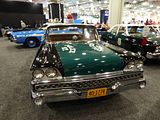

This 1961 Plymouth Savoy looks more like a fire-chief car! It was used in the TV series “Car 54, where are you?”, featuring bumbling coppers Toody and Muldoon, officers based out of the fictitious 53rd precinct, and was indeed shot at a studio in the Bronx with lots of footage obtained on the streets of New York. Their car was given this unusual colour scheme to make sure residents didn’t mistake it for a real black, green, and white NYPD squad car, and it didn’t look that peculiar when viewed in black-and-white.
Before placing what can be fairly large orders for new vehicles, most major police departments like the NYPD put prospective police vehicles through extensive vehicle testing regimens either at their own facilities or sometimes at manufacturer proving grounds. Chevy and its by-then ubiquitous and iconic small-block V-8 obviously got a slice of the business for 1966 as this 1966 Biscayne evidences.
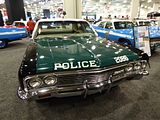
By the 1970s, the green and black colour scheme had gone, to be replaced by the more conspicuous blue and white that is still used today, as can be seen on this 1971 Plymouth Fury.
This is a 1974 Plymouth Satellite. To cut costs during the OPEC troubles, the NYPD downsized from the full-size Fury to the intermediate Satellite Custom. These more svelte (but still huge by today’s standards) sedans featured the same Chrysler small-block 318 V-8 that the big Furys used, but weighed about 700 pounds less. This improved performance, handling, and economy (from a reported 10.4-mpg average to 11.8). The force incorporated 402 of them—with air conditioning—into its 1,372-vehicle fleet.
In 1974 the NYPD removed the precinct numbers and command designation from its squad cars (as seen on the ’74 Satellite in the background), but by 1978, with this Plymouth Fury, the department realised the importance of reassuring the citizens that their own local force was patrolling their streets, and the precinct numbers went back on.
Chevrolet did a lot of police business with its 9C1 Police Package of uprated powertrain and suspension bits, including a 350-cu in. V-8 here. This particular example, a 1989 Impala, was built in tribute to fallen officer Edward R. Byrne, who was slain in the line of duty while providing witness protection in the case of a notorious drug lord.
The large Chevrolet was a popular car with the Department throughout the 1980s, and there was another example here, a Caprice Classic.
Dating from 1988 the Plymouth Fury with is 318 V-8-powered M-body was a mainstay of police and highway patrol duty throughout its long life. Perps enjoyed a bit less rear seat legroom than in the full-size Caprices they most often competed with, but they were slightly nimbler—especially in tight traffic.
The NYC Police Museum’s collection also includes vehicles done up in Housing and Transit Police livery. These separate divisions were eventually merged into the NYPD. This 1978 Plymouth Diplomat, was only used by the Housing Bureau, but something about an orange and blue NYPD car just feels right. There are those who would to see the return of this colour scheme back to match the city’s flag (as well as three of its professional sports teams).
Another highlight of the collection is its collection of vintage uniforms dating back through the decades, many of which were displayed, as well as other artifacts and several vintage bikes from the Department.
This 2005 Chrysler Sebring Convertible was done up in the department’s vintage black, green, and white livery for use during special occasions like parades. It also honours the memory of Detective Dennis E. Guerra.
Bringing things uptodate were examples of a couple of vehicles that you could see on the roads right now, current Fords Explorer and Taurus and a Dodge Charger kitted out for use by the State Troopers.
AUTOMOTIVE MUSEUM of NEW JERSEY
Another display which was quite a contrast from the rows of brand new cars the one put on by the Automotive Museum of New Jersey. I’ll confess I’d not even heard of this collection, but now have the leaflet they were handing out, so will try to visit next time I am in the State. For now, though I had to content myself with enjoying the disparate collection of cars which they had brought along.
The Detroit Electric proves that the concept of the EV is not exactly new, as these models were sold around 100 years ago, and proved surprisingly popular, especially with lady drivers who did not have to worry about refuelling their cars.
Also from this period was an an early Cadillac and a Hupmobile
Classic Ford models included a customised 30s car and an early 40s DeLuxe
This is a Chrysler 300G from the legendary “letter series” of Chrysler 300 cars first seen in 1955. These were high-performance personal luxury cars built by Chrysler in the U.S. from 1955 to 1965. After the initial year, which was named C-300, the 1956 cars were designated 300B. Successive model years were given the next letter of the alphabet as a suffix (skipping “i”), reaching the 300L by 1965, after which the model was dropped. The 300 “letter series” cars were among the vehicles that focused on performance built by domestic U.S. manufacturers after World War II, and thus can be considered one of the muscle car’s ancestors, though full-sized and more expensive. The 300G, seen here was only produced in 1961 and was another restyle on what had gone before. The grille, formerly wider at the bottom than the top, was inverted; the quad headlights, formerly side-by-side, were arranged in angled fashion, inward at the bottom, in a manner reminiscent of 1958-1960 Lincolns, 1959 Buicks and the 1963-1966 Rolls-Royce Silver Cloud Mulliner Park Ward coupe. Small parking lamps below the headlights were likewise slanted and V-shaped, and the front bumper was canted up at each end, scoop-like. At the rear, the taillights were moved from the fins to the tail below them, and the fins were made sharper-pointed. Power windows were standard. Mechanically, the cross-ram “short ram” and “long ram” engines remained the same, although the expensive French manual transmission was dropped, and replaced by a more reliable and still expensive Chrysler racing manual transmission (referred to as ‘option code 281’). There are currently only five cars with this transmission. Code 281 cars may have been built for the 1961 Daytona Flying Mile, although like the 1960 F Specials, no specific records were kept by Chrysler. Unlike the 300F Specials (which were randomly pulled from the line and upgraded for the Flying Mile), the 300Gs had a specific build code (281).
There were examples of both the 56 and 57 Bel Air Convertible, a much-prized classic these days.
One of the most popular vehicles in the display was a DeLorean DMC12, a car popularised thanks to its starring role in the “Back to the Future” film.
The DeLorean was not the only futuristic car as there was also this, the ETV, a strange looking machine which I have only seen once before, at the Concours Event at Hampton Court in 2014. Believe it or not, this “car” started out as a humble Chevrolet Aveo! Designed and built by Floridian, Mike Vetter, of The Car Company. The Extra-Terrestrial Vehicle or ETV – I kid you not, that is the car’s official name- is a futuristic-looking custom build machine with a very sci-fi like appearance. First built in 2009, Mike has gone on to produce around 10 of these amazing looking machines, not all of which are quite the same. The ETV is powered by a 2.0 litre turbocharged Chevy engine and uses an adjustable air suspension to conquer speed bumps and steep driveways. The doors open scissor style. Front and rearview cameras help with outward visibility and parking manoeuvres. One was sold in 2014 on eBay for a not insignificant $71,000. This one was certainly attracting plenty of rather puzzled looks, displayed among some much more familiar machinery here!
OTHER
There were a couple of historic ice cream trucks here. Both built on Ford chassis, the earlier of the duo dates from 1948 and the newer one is built on a 1967 Ford F250 Truck. These days it belongs to 29 year old Tom Topalian, a nurse and co-owner of Phil & Tom Ice Cream from Westport, CT. The story starts with a wanted ad in a newspaper for ice cream truck drivers. His older brother, Phil, had just got his driver’s license and was looking for a summer gig. Together they went and saw this guy who owned a huge graveyard of rusted ice cream trucks near I-95 in Bridgeport, Conn., and he rented out the ones that still functioned, at about $500 a week, plus the cost of ice cream. With a little help from their parents, they rented the truck for the first season, in 2001. His brother drove, and Tom sat on the freezer compressor, which is where the passenger seat used to be. The truck was a vintage 1967 Ford F-250 pickup converted into a Good Humor truck in the 1960s. It was covered in years worth of ice cream stickers, and needed a lot of work. But everything was original, from the brass bells that signal customers to the freezer itself, and they were able to figure out that it originally served in Brooklyn, years before Tom was born. People loved it—particularly their parents, Peter and Joanne, because they grew up in Long Island and could remember buying ice cream from a truck just like it. They served the same Good Humor flavours they could remember: toasted almond, strawberry shortcake. After a few seasons, Tom and his brother had saved enough to buy the truck, paying around $14,000. They rebuilt the six-cylinder, and when they cleaned off all the stickers they found the original Good Humor art beneath, still intact. They even found the company that made the original brass bells; it was still in business, so they got new bells. It looked splendid, as indeed did the earlier truck.
Very different to look at, though also dating from the 1960s was this replica of Chitty Chitty Bang Bang which was to be found in one of the corridors connecting the two main exhibition halls together.
I really enjoyed my day at the Show. There was a lot to see, and it was good to get the chance to get close up without having to take turns with crowds. Needless to say, by the time I got back to the hotel at Newark Airport, I was tired, and I needed a lazy day following this one to catch my breath before returning to Phoenix, and the rest of the holiday. But it was well worth that short hop across America. As I tend to be on vacation in the country around the end of March. early April most years, I will certainly be planning to do something similar when Easter falls at the right time again.




